ORIS SETS THEIR SIGHTS ON THE FUTURE



ORIS SETS THEIR SIGHTS ON THE FUTURE


When I first started trying to explain watches and indeed Calibre itself to people, I talked about how enthusiasts would talk. Reference numbers were key, I said. Reference numbers that were used to identify watch models, movements, sometimes even parts. It was one of the ways I tried to explain that there was far more technical depth and historical importance to watches that just brands and model names. Enthusiasts and collectors would cite these odd (to most people) numbers as a way of being as specific as possible. There were hundreds of models of, say, Omegas or Speedmaster and even within families there were differences over generations. Some would be considered covetable, others very very not.
This all stemmed probably from the industry itself. Watchmakers and watch companies were producing very specific parts and complicated pieces, and they needed to be very precise for many reasons. Besides just keeping track, they needed to have some way of documenting what parts went in what, and where they were sourced or how they were made. And remember, the first clocks and watches often didn’t even have names. Or if they did, it was often of the merchant (often a ship’s chandler) who sold it to you.
Recently when I was talking watches and the industry with a visiting watch company head, it seemed like they began to feel that reference numbers may well be bad for the watch world. People were quoting this number or that as a “grail” or “their next grail” which kind of goes against the whole definition but
that is another discussion. There wonderful pieces of technology and craftsmanship, these works of art, were being identified by people who basically new the number and the price and not much else. They might know what you could google off your phone or what algorithms sent you because you seem like the right type. But there were no discussions of any depth. History, technology, daring, risk. Why the shape of one tooth on a gear made such a difference. Why a multi-awarded watchmaker said something was impossible, until he figured out how to do it. Why some brands refused to use certain precious metals for shaped boxes until they could be up to their standards. That company owner said, you know I really don’t know why people buy so many colors of the same of our watches. What is worse, no one even cared.
It is arguable of course, and probably very true, that we can have these discussions because of our access to the industry. But that access came, as I would explain when asked how we started the whole publishing group we did (as just a magazine at first), that it all boiled down to the simplest of things.
The basic formula is available to anyone really. Get really enthusiastic about something. Learn a whole lot about it. People will start asking you questions.
That is really all it is.
And all this information is now available pretty much to everyone. Not everything of course,
we still have discussions that would honestly astound people and that someday we may be able to talk about.
But more information and access is far more available now than in any other time in history.
So please. If you love something, or even want to learn more about it. Go deeper.

Think.
Talk.
Listen.
Explore.
You sell everything short, including your own passion, if all you talk about is what something might have cost.
Carl S. Cunanan Editor-in-chief


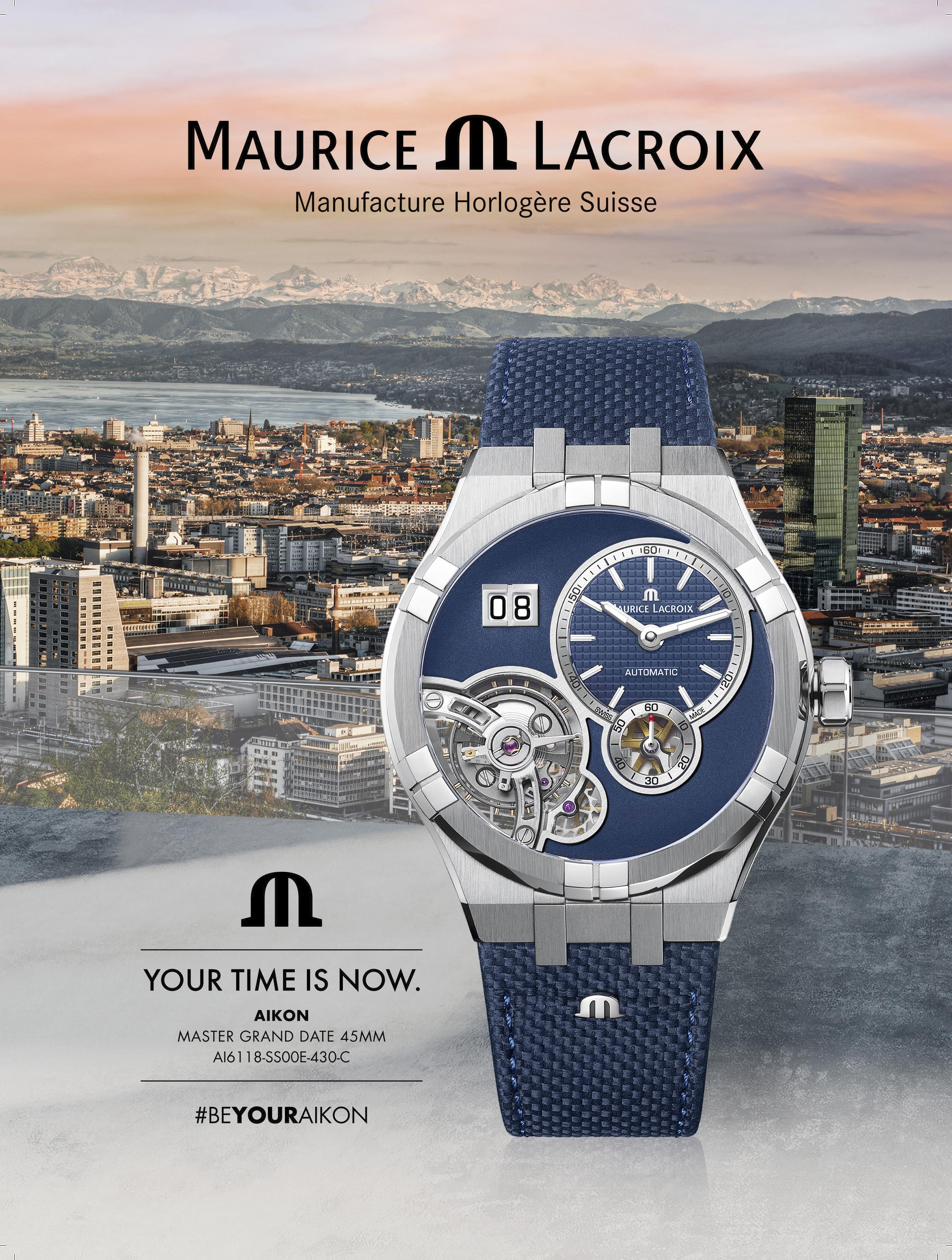










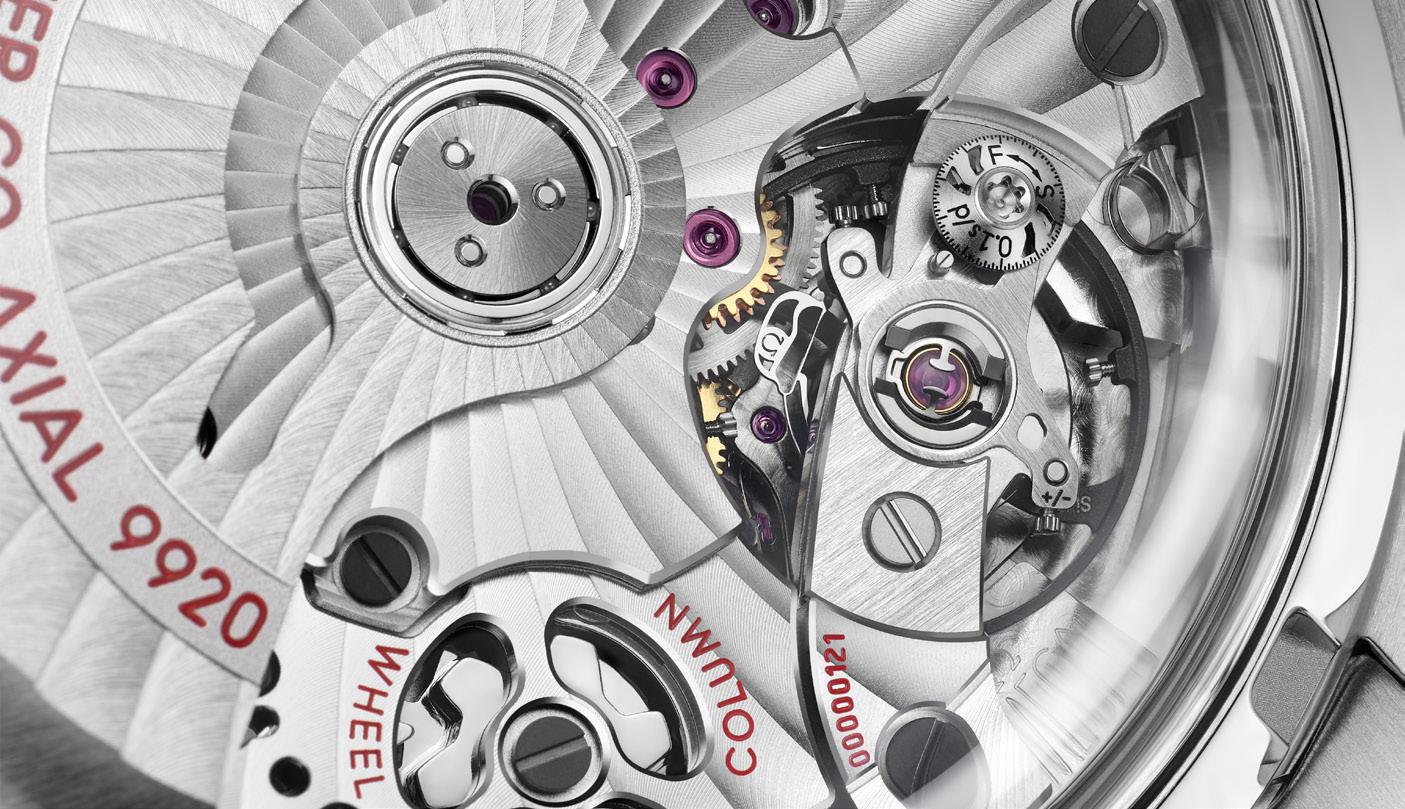



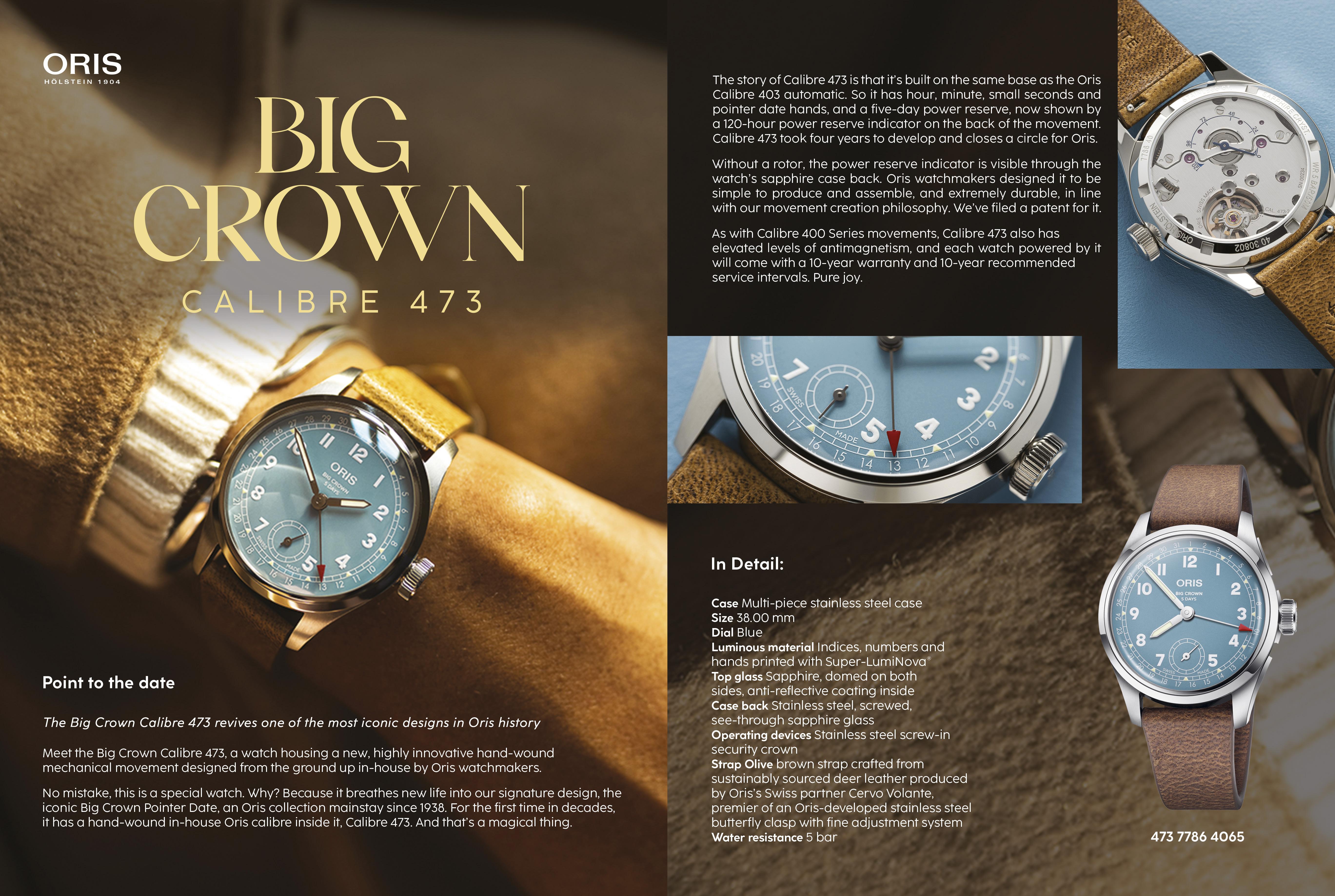

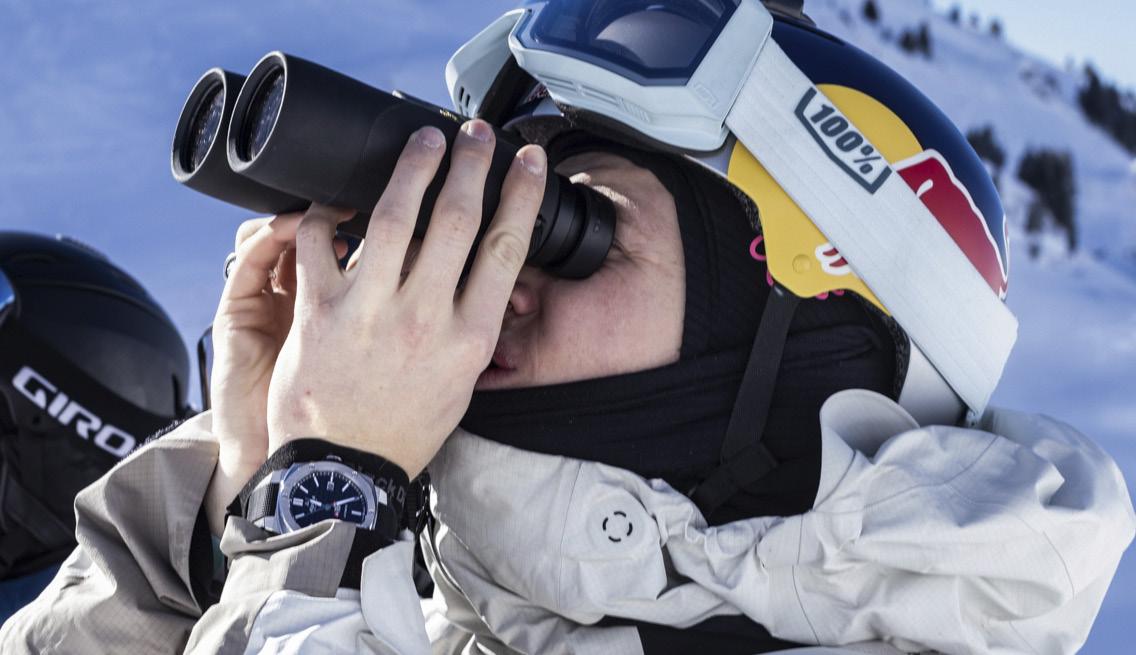




Carl S. Cunanan
Editor-In-Chief
Executive Editor
Joseph Peter C. Calimbas
Senior Editor
Hernan C. Mapua
Collections Editor
Jason S. Ang
Associate Editor
Kit O. Payumo
Senior Staff Writer
Alberto E. Casal
Editor-at-Large
Bryan Martin B. Zialcita
Design Director
Charie L. Biaden
Senior Designer
Mark David A. See Designer
Mary Ann E. Marcelo
Contributing Writers
Katherine S. Cunanan
Jose Martin V. Ursúa
Leonard Vincent L. Ho
Edrich Santos
Dominique O. Cerqueda
Contributing Photographer
Keith Sundiang
Mayette L. Asis Vice President
Advertising Traffic Manager
Mary Jane O. Salazar
Account Managers
Malyn L. Bautista
Hiroshi D. Paderagao
C! Publishing and Media Group, Inc.
Publisher
Chairman Michael L. Lhuillier
Managing Director
Paolo M. Puyat-Martel
Board of Directors
Michael L. Lhuillier
Paolo M. Puyat-Martel
Carl S. Cunanan
Kevin C. Limjoco
Vice President
Mayette L. Asis
Senior Accountant
Merline B. Urdas
Credit and Collection Officer
Mary Ann M. Benito
Legal Counsel
Paredes Garcia & Golez Law Office
C! Publishing and Media Group, Inc.
10 Nathan St. White Plains Subdivision, White Plains, Quezon City, 1110 Philippines
Tel: (+632) 7728.3720 to 21
Visit: www.calibremagazine.com
Distributed by:
Alphastream Marketing Inc.
#5 Everite St., Calumpang, Marikina City Tel: (+632) 7945-5089 ORIS
@calibremagazineph
Calibre Magazine PH
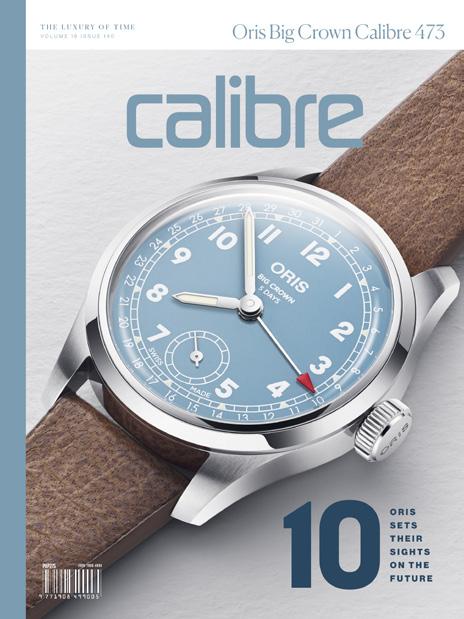
facebook.com/calibremagazineph
twitter.com/calibremagph
Quality deserves time.

With the 2023 Geneva shows shifting back to more face to face interactions in line with the world opening up and moving forward after a few years of uncertainty, it’s good to know that a lot of colleagues are making the trip to Switzerland in a few weeks’ time. What was once called the SIHH is now known as Watches and Wonders Geneva and judging by the volume of emails that I’ve been getting with the Subject Line going “see you in Geneva” or “Let’s have coffee at…” and such one can only surmise that it’s almost back to business as usual. For most folks in the watch industry at least.
On the market side, global markets are still rather shaken (absolutely no pun intended) by events both recent and lingering in so far as business growth is concerned. According to an excerpt from the Deloitte report, strong growth can be seen in the high-end to very high-end market while the mid-range segment remains in the doldrums. For the lower tier watches, they are still locked in a tough battle to get a share of the price point where smartwatches are currently the top draw. One thing that may also affect the sales of entry level and mid-level watches could be the disruption of the movement of goods around the world what with long delivery times and production shortages caused by
JP C. Calimbas Executive editor
various stoppages in the manufacturing of parts that are commonly outsourced by watch manufacturers to cut down on costs. For the top tier brands, they manufacture and produce most of the components they use so at least for the upper echelon models, the typical waiting time for delivery is still the same.
On the media and reporting side, the shift continues to head towards the digital spectrum thanks to more and more people getting online and providing search engines with better data to sell ads that reach the intended target with the accuracy of a satellite guided cruise missile.
Which is why instead of attending the show like I used to do together with our EIC, I chose to do the online version so that we can upload the latest novelties almost in real time rather than wait until after the show to get them to our followers/readers/bashers or whatever constitutes our viewer base. Of course, the change in the sponsorship package offered to us helped make the decision easier but at the end of the day, I still work for the magazine and that entails me to get the press releases from the brands as expeditiously as possible foremost.
While the appetite for traditional media is still enough to sustain a select few outlets, the pond is slowly drying up and at some point, even the heartiest of dwellers have to adapt to a new world.
Hopefully, we can be one of those that digital natural selection deems worthy. So please go to our digital portals and like and subscribe.
“WHILE THE APPETITE FOR TRADITIONAL MEDIA IS STILL ENOUGH TO SUSTAIN A SELECT FEW OUTLETS, THE POND IS SLOWLY DRYING UP AND AT SOME POINT, EVEN THE HEARTIEST OF DWELLERS HAVE TO ADAPT TO A NEW WORLD.”



It’s already a few months into the year, and watch companies are about to go full blast on their releases for 2023. Watches and Wonders Geneva is just a few weeks away, and even some small, independent companies have already started promoting their new models for the year. As is the norm during this time every year, things are about to get very interesting very quickly.
With the certainty of your social media accounts being flooded with new watch releases in a couple of weeks, and the potential for you to get swept up in the moment and instantly fall in love with a new watch, now is the perfect time to reflect on what you currently have in your existing watch collection, and your long term goals related to it. In watch collecting, sometimes the head must prevail over the heart if you are into this hobby for the long haul.
Probably one of the most important things to consider is what type of watch collection
you want to build. Are you the type of person who limits the number of watches in your collection with the number of slots in the watch box? Or do you feel the need to have at least one watch per category (sports watch, dress watch, etc.)? By figuring this out, you’ll be able to prevent impulse buys and focus on what type of watches you will shortlist this year even before the new releases are announced. Another factor to assess during this period is whether or not your watches are getting enough ‘wrist time.’ If you have watches that seldom see the light of day, or you still have something that you do not particularly enjoy anymore – perhaps now is the time to consolidate your watch collection. Or as some people would say when selling their watches: ‘RFS: Offload to Reload.’
After this much needed soul searching and objective review of your watch collection, there is nothing left to do but to wait for the imminent stream of new releases later this month. I personally can’t help but feel excited for what’s to come.
Bryan Martin B. Zialcita Editor-at-Large
“IN WATCH COLLECTING, SOMETIMES THE HEAD MUST PREVAIL OVER THE HEART IF YOU ARE INTO THIS HOBBY FOR THE LONG HAUL.”
Time passes irrevocably.

Astring of recent events left me considering what might have been for air travel in the Philippines:
First, I endured a 17.5 hour pre-Christmas flight from Toronto that ended in confused chaos, and luggage delayed by five days. Thanks, PAL! Then came news of the final Boeing 747 rolling off the production line and into legend. The Jumbo Jet defined my long-distance travels as a child in the 80s (starting with a flight on Pan Am Clipper Intrepid) and as a teen in the 90s. It’s all about twin-engine efficiency these days, but it’s still sad to see the old girl go. Lastly, I fell down a rabbit hole while reading about Concorde. Two highlights emerged during my research: First, an old GMT-Master advertisement that deduced, “If you were flying the Concorde tomorrow, you’d be wearing a Rolex.” Unfortunately, Concorde (only American copywriters preface it with “the”) was retired by the time I bought my first Rolex, so that was an impossible premise. Secondly, I found a fascinating image from a sales brochure printed during the supersonic transport’s late-70s promotional world tour for potential customers. It was Concorde in classic Philippine Airlines livery — red and blue stripes streaking from cockpit to tail.
Although my PAL experiences since the late 80s have been mostly negative (the convenience of direct flights keeps bringing me back), Asia’s oldest airline was once one of the best. It was a nationalized flag carrier in the 70s and 80s, so I will carefully refrain from commenting on the politics and economics of that arrangement! I will say that the single best flying experience of my life was sleeping in the Skybed on the upper deck of a PAL 747 to Los Angeles. In fact, Classic PAL’s in-flight food even received an award from Les Chaines de Rotisseurs. (No, I didn’t know who they were,
either.) PAL was one of the grandees among the world’s airlines and so in 1976, Concorde landed at Manila International Airport. Former Philippine Air Force pilot Capt. Pepot Gonzales was at the stick for the final leg of a long Eurasian journey: Paris-BahrainReunion-Singapore-Manila. It’s been said that PAL ordered two examples of the supersonic bird, but that the deal collapsed either due to a) the Marcos administration’s dispute over landing rights at London Heathrow or b) the same reasons why every other airline cancelled, save for stakeholders Air France and British Airways: The spike in fuel prices and an international distaste for sonic booms meant that the skies of tomorrow would belong to subsonic wide-bodies.
Assuming that the orders had been filled, what would PAL Concordes mean to transPacific travelers like me? In the aircraft’s early years, absolutely nothing. When it debuted, Concorde’s operating range was 3690 miles, which, combined with the runway requirement of 11800 feet, precluded any
Pacific island-hopping. There was a design for an improved “Concorde B” with longer range and less noise, but this was dropped as airlines cancelled their orders. But over its operational life, tweaks were made to the vanilla “Concorde A” that bumped its maximum range up to 4500 miles when it was finally retired. So let’s take those admittedly generous performance figures and imagine what a supersonic journey on PAL would have been like.
The most likely scenario would have been a three-legged trip from Manila to Los Angeles, with refueling stops in Guam and Honolulu. We can assume that PAL’s Concorde could cruise at Mach 2 for much of that journey, as there would be no ban of supersonic flight over the ocean. I will not bore you with my back-ofnapkin math, but I estimate a total travel time of 8.5 hours, including the two 45-minute fuel stops. This is a bit underwhelming, considering that a non-stop MNL-LAX flight is 13 hours today. How many travellers would be willing to pay a substantial premium over first-class just to shave 4.5 hours? Also, that’s 8.5 hours in a cramped, low-ceiling cabin with none of the privacy pods, in-flight showers, and “Sky Suite” decadence you find in an A380 or 7478. Speaking as a connoisseur of economy class, all voyages longer than 8 hours tend to blur together into similar, miserable memories!
Jose Martin V. Ursúa Contributing writerBut let’s return to that aborted “B” variant of Concorde. The imagination can be more ambitious if it had been built, and its performance similarly improved over time. Perhaps Manila-Tokyo-Vancouver in 7 hours? Now, we’re talking! Who cares about Soviets landing on the Moon or the Axis winning World War II? I want to dream of the alternate history where that speedy journey is possible, the in-flight meals are delicious, and I have a Ref. 1675 GMT-Master on my wrist. At least I can still work on that last item!

parallel passion

“A well-tied tie is the first serious step in life.”
— Oscar Wilde

As early as the 1950s, Breitling has served as the official timekeeper of the biggest races on the cycling calendar, including the Tour de France, Giro d’Italia, Milano San Remo, and Flèche Wallone. This year, the Swiss watchmaker takes a step forward by sponsoring a newly-founded team by the Italian cycling apparel brand Q36.5, on its mission to reach the World Tour by 2026.

Breitling sponsors its first ever cycling team.


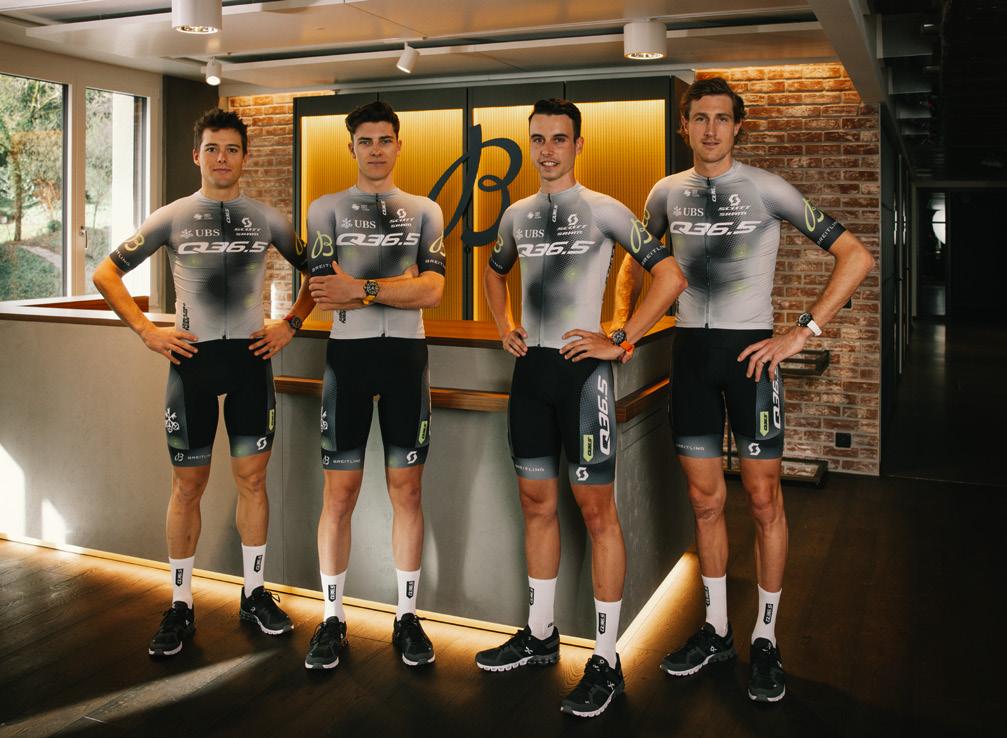

The Q336.5 Pro Cycling Team is a Swiss-registered professional cycling team that was founded just this year. Q36.5 has been pushing the limits of cycling apparel by using highly technological fabrics that guarantee nextlevel thermoregulation for athletes in the most extreme and difficult conditions. The letter “Q” stands for the Latin word “quaerere” which means “research,” and the “36.5” indicates the ideal body temperature in degrees Celsius.
“Cycling is one of the fastest-growing sports in the world. It’s also a big part of our history and we needed the right partner with a strong vision to carry this heritage into the future,” says Georges Kern, CEO of Breitling. “Q36.5 Pro Cycling Team, with its ambitions to perform at a world-class level while making a positive social and environmental impact, proved to be the model team to put our support behind.”

Breitling also supports Qhubeka, a South African based organization that supplies bicycles to remote communities, giving them better access to education, medical services, and jobs. Q36.5 Pro Cycling Team GM Douglas Ryder also supports the organization, and has been for many years.
The newly-formed squad’s mission is “Racing the Future” and rise to the World Tour. “With progress at the heart of who we are, one of our goals is to leverage our international team and global racing calendar to raise awareness to the benefits of social mobility, through education and physical mobility in Africa. Another goal is to reduce our carbon footprint, minimizing the use of plastics and showcasing the benefits of cycling as a means of building healthier and more sustainable communities,” says Ryder.
The Cayenne is a tale of extraordinary success.

The Porsche Cayenne holds a special place in the car manufacturer’s heart. It arrived during a time when the company most needed it. In the late 1990s, Porsche sales was on a dive and something needed to be done. So plans for a “new Porsche” was put into motion. And in August of 2002, the first model of the Porsche Cayenne was

introduced to the market. It was a bold move for a sports car company to produce an off-road capable vehicle. Some might say that it was “out-of-the-box”. But the Cayenne was met with high praises. It was not merely a sporty SUV consistent with the brand, but it also gave the top competitors in the off-road segment a run for their money.
This new 2023 Cayenne is in its third generation and is every bit as sporty, powerful, fast, and comfortable as its predecessors. It has 450 nM of torque, 250 kW/340 PS, reaches 0-100 km/h in 6.2 seconds and has a top speed of 245 km/h. Some of the interesting features this new model has includes a
360° camera that not only assists you in parking, but also warns you if vehicles driving by are too near you. It also helps you navigate through tight spots.
When you turn off your engine, the driver’s seat draws back, and goes to its original driver’s position when the ignition is turned on. Another cool feature is the ability to control the front side passenger’s seat via the driver’s seat controls. This comes in handy when your passenger falls asleep and you want to recline his/her backrest for a more comfortable position.
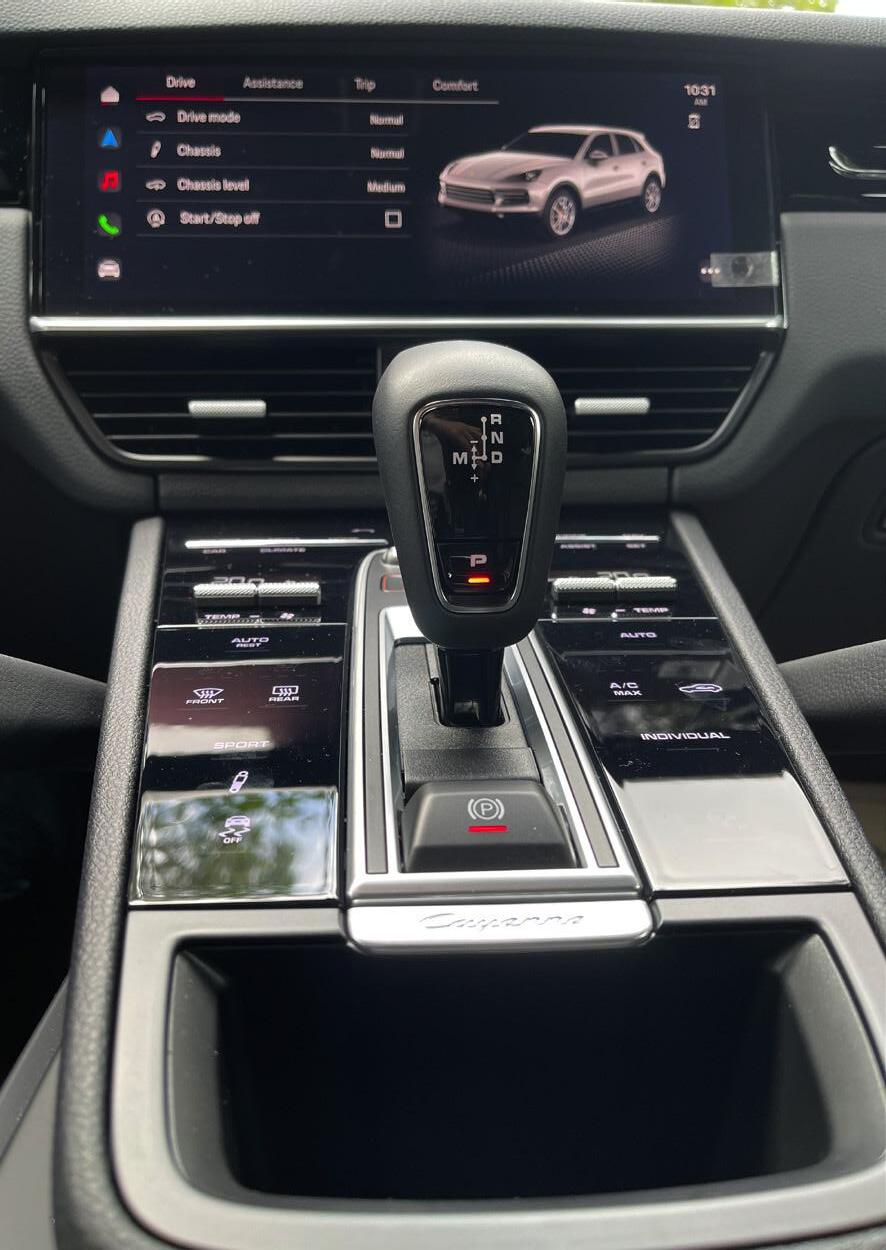
Of course, the car comes with a keyless entry feature. With the key fob in your pocket, you merely insert your hand in the door handle, and the car automatically unlocks the doors. You get in and sit on the comfortable leather seats, put your foot on the brake, and turn the ignition on the left-hand side of the steering column. Let’s face it, at this point, there will be times when you will need to get out of the car to get something in your house, or put something in the trunk. The Cayenne will disable the engine, preventing anyone else from entering and driving off with the car.
Ferry Porsche was correct in saying:
“If we build an off-road model according to our standards of quality, and it has a Porsche crest on the front, people will buy it.” Since 2002, the Cayenne has been one of the mainstays of the car manufacturer’s global success.

In the world of watches, the TAG Heuer Monaco has been an iconic wristwatch since Steve McQueen wore it in his 1971 film Le Mans, where he drove a Porsche 917K. The TAG Heuer Monaco is an emblematic timepiece as the chronograph was presented in a square case. It was an “out-of-the-box” and “avant-garde” design that housed a new movement - the Calibre 11. The Monaco was also the first square-cased automatic winding chronograph that guaranteed waterproofness. Aside from the eyecatching square case, the other striking feature of the Monaco was the placement of the crown at the 9 o’clock position.
The Porsche Cayenne and the TAG Heuer Monaco are both pillars of their respective brands. Each of them steeped in history and forever locked into the hearts of fans from all over the globe.

“The Cayenne has been an extraordinary success story and has been one of the mainstays in Porsche’s global success.”
A collection of emblematic vintage pieces.
Watch collectors know how difficult it is to acquire, much less find, a significant, historical timepiece in the world market. The smallest lead about a sought-after watch is enough for them to conduct a thorough investigation. Once proven authentic, then the cycle of negotiations start for the possible purchase of the watch.


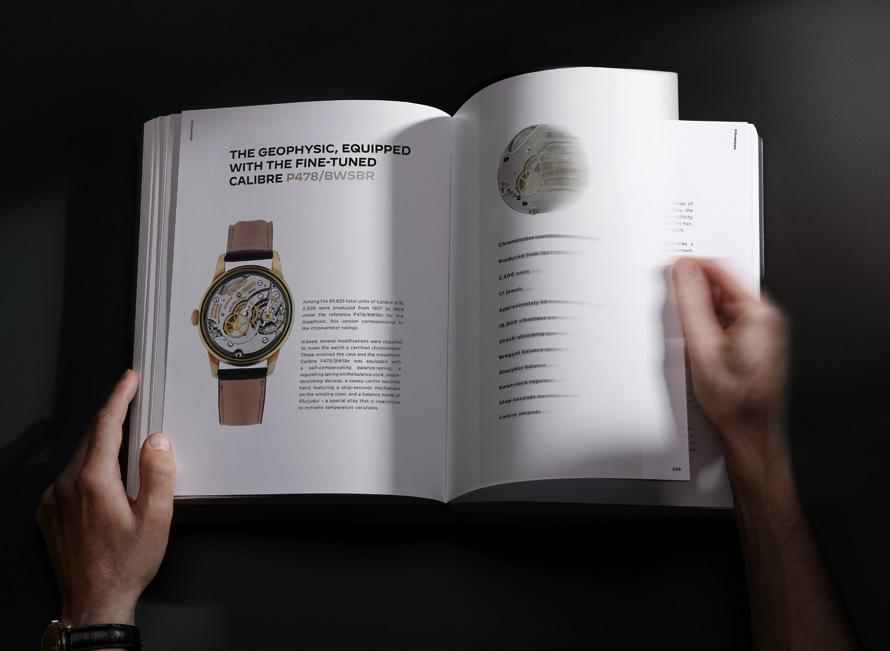
With this in mind, Jaeger-LeCoultre is proud to present The Collectibles, a meticulously curated collection of rare and sought-after timepieces that represent milestones for both La Grande Maison and 20th-century watchmaking.

Simply visit their website at jaegerlecoultre.com, click on The Collectibles tab, and browse through a selection of Jaeger-LeCoultre’s most emblematic

timepieces. The first to be offered are fine examples of a Geophysic, a Memovox Parking, a Master Mariner Deep Sea, and a Shark Deep Sea. Every Collectibles timepiece is presented with an extract from Jaeger-LeCoultre archives, a new watch strap, and a complimentary copy of The Collectibles coffee table book. In addition, when available, the original box and papers, and original strap or bracelet will be included.
Every piece offered through The Collectibles is thoroughly vetted by Jaeger-LeCoultre’s historical experts and fully serviced and restored by the specialized watchmakers of the Manufacture’s restoration workshop. Over time, a continually evolving selection of timepieces will be available for purchase.
“Being able to restore these remarkable timepieces and offer them once again is a nice tribute to our current environment, in which sustainability and second lives have come to the fore,” says Catherine Réiner, CEO of Jaeger-LeCoultre. “It is fantastic to see 50- or 80-year-old pieces given new life. For me, that symbolizes the beauty of our world - of timeless and durable objects to be passed from one generation to the next.”
The TUDOR Pelagos makes good on the promise of escape
In Fall 2015, Pelagos was awarded the "Sports Watch" prize as the prestigious Grand Prix d'Horlogerie de Geneve (GPHG), reinforcing the Pelagos's position as one of the most complete traditional mechanical divers' watches available today.
TUDOR has always considered the quality of its products and the daily experience of their users as their highest priority. Indeed, the storied history of all TUDOR diver’s watches have also been closely linked to these considerations, and have been invariably tied to their intensive use by the professional divers of the major navies from around the world. It was with all these considerations in mind that the TUDOR Pelagos was painstakingly developed.
This is why the TUDOR Pelagos is waterproof to 500 meters; it is available in both left- and right-handed versions with a 42mm diameter titanium and steel case; it is equipped with a helium escape valve, which is an essential device for preserving the watch during saturation dives; it is guaranteed with optimized readability with generously-sized square hour markers, as well as generous amounts of blue luminescence on the dial; the distinct “snowflake” hour hand (which is a feature of TUDOR divers’ watches since 1969) allows it to be distinguished from the minute hand at a glance; while the ceramic disc on the titanium unidirectional rotating bezel is also enhanced by luminous markers allowing for maximum visibility even during the darkest conditions.
Additionally, the external parts of the 42mm TUDOR Pelagos are made of titanium chosen for its intrinsic qualities of lightness — approximately 60% of steel for the same volume, as well as its superior resistance to the corrosive nature of seawater. The same goes for its highly functional matt appearance and color, which is an excellent way of
conveying the Pelagos’ technological and professional intention. Even its titanium bracelet with a steel folding clasp and its unique auto-adjustable spring mechanism developed in-house and patented by TUDOR is indicative of the watchmaker’s painstaking development: the mechanism allows the bracelet to contract and expand automatically and without the need for diver intervention according to the pressure and depth of the dive. The additional rubber strap, on the other hand, is provided with a quick extension system that allows for easy user adjustability during any type of diving conditions.

The calibre TUDOR MT5612 (COSC), presently driving the TUDOR Pelagos, was also developed entirely in-house with these considerations in mind. Its selfwinding system is bidirectional, and is autonomous for 70 hours. This allows the wearer to take off the watch on a Friday evening and put it back on Monday morning without having to worry about winding the watch (i.e. "weekend-proof"). The date sits discretely at 3 o’clock, while the movement oscillates at a frequency of 28,800 beats/ hour (or 4Hz) and regulated by a variable inertia oscillator with silicon balance spring held in place by a traversing bridge fixed at
both sides to improve resistance to shocks and vibrations.
And in a continuation of the exterior finishes of the TUDOR Pelagos, the calibre TUDOR MT5612 is also presented in a matt finish, which emphasizes its precision, reliability and the high level of technology as seen through large surfaces that have been sand-blasted, embellished with details or sun-ray-brushed, as well as the open worked central rotor.
In 2015, the TUDOR brand was endowed with a very significant first: the official certification of the TUDOR Pelagos by the Swiss Official Chronometer Testing Institute (COSC) earning it the distinction “CHRONOMETER OFFICIALLY CERTIFIED” as seen on two lines on the dial, as well as its name, “PELAGOS.”
The technical update was accompanied by the introduction of a new color combination for the dial, bezel and rubber strap. In addition to its original matt black version, the new model was available in matt blue, which was not only the emblematic color of the brand’s divers’ watches since the 1960s, but it was also the color chosen by the French Navy for the TUDOR Submariners that had been used in great numbers by its divers.



Many watch collectors make a big deal out of “signature watches,” watches that define a brand, or sometimes an entire category. Breitling, for example, has the Navitimer, which is not only identified with the brand but is also identified with Pilot’s watches in general. The same goes for the Rolex Submariner, a diver’s watch that is both brand and category defining. On the higher end of the spectrum, Audemars Piguet has the Royal Oak in the luxury sport category. And of course, there is the Omega Speedmaster, which as indelible a signature as watches can get.
And then there’s Oris, which has their own signature watch. It’s not a pilot’s watch nor is it a diver’s watch. In fact, it’s a design and type of complication that isn’t even exclusive to Oris but one that the brand has made their own: the Big Crown Pointer Date, which has been a part of the Oris roster since 1938.
Almost every version of the Pointer Date to date (pardon the pun) has run on a Sellita-based movement. Indeed, Oris has been known since the 1990s as a maker of rock solid, value driven mechanical watches driven by off-the-shelf Sellita movements that have been modified in-house. That all changed in 2014 with the inception
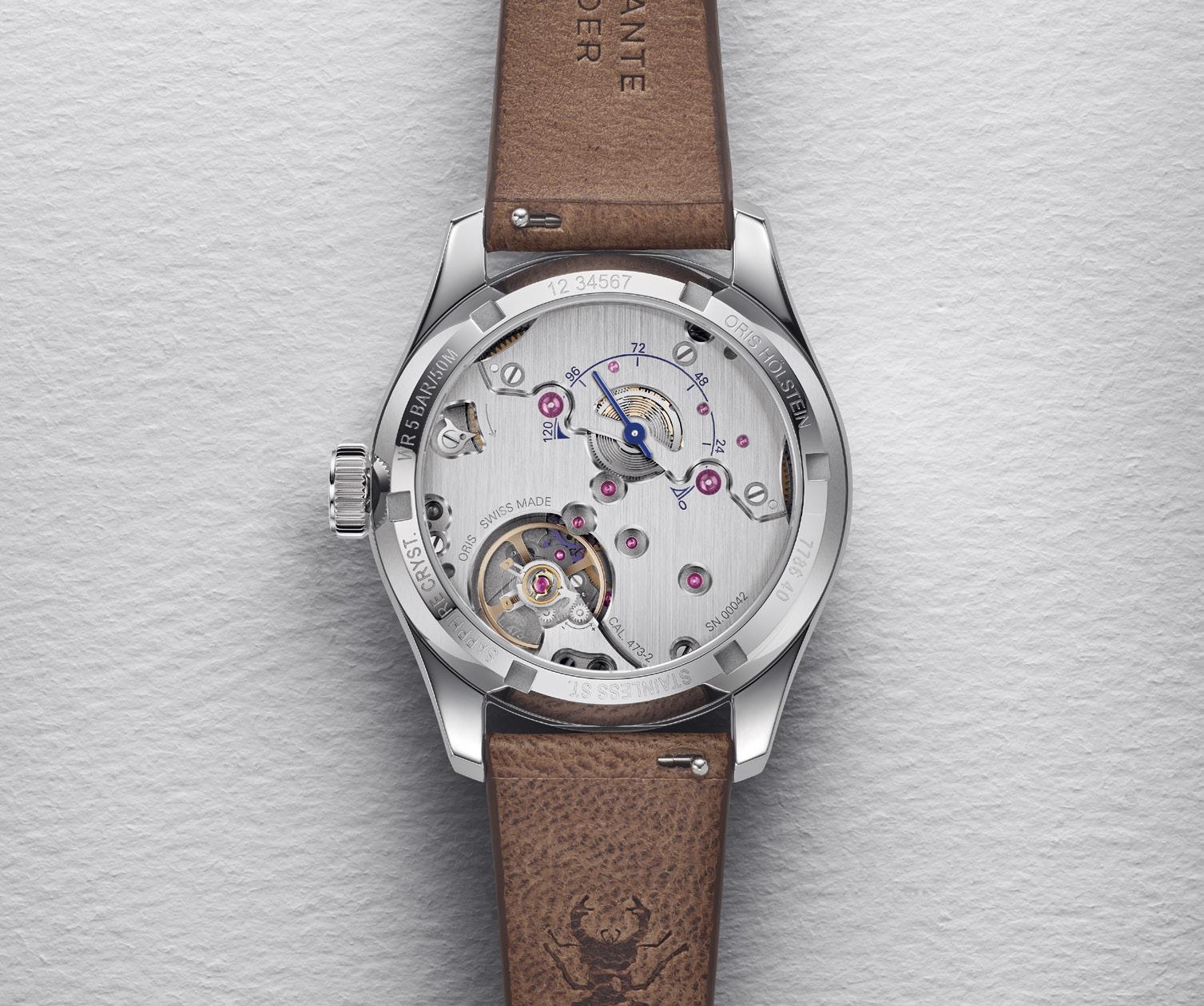
of Oris Movement Creation Programme, the watchmaker’s in-house initiative to elevate Oris while keeping the brand firmly on the ground.
The program brief was clear: to create purely mechanical and purely Swiss made movements with unique functions but at a price point that made sense to the average working class citizen. “We offer serious mechanical watches at fair prices in an industry that sometimes forgets that there are numerous people who would like to own a mechanical watch, but who still have to work hard for their money,” says Oris Chairman, Ulrich W. Herzog.
To think Oris was already a prolific movement maker, creating a number of unique, original and innovative watch movements that the brand carefully developed since its inception in 1904. That all changed with the quartz crisis of the late 70s and early 80s.
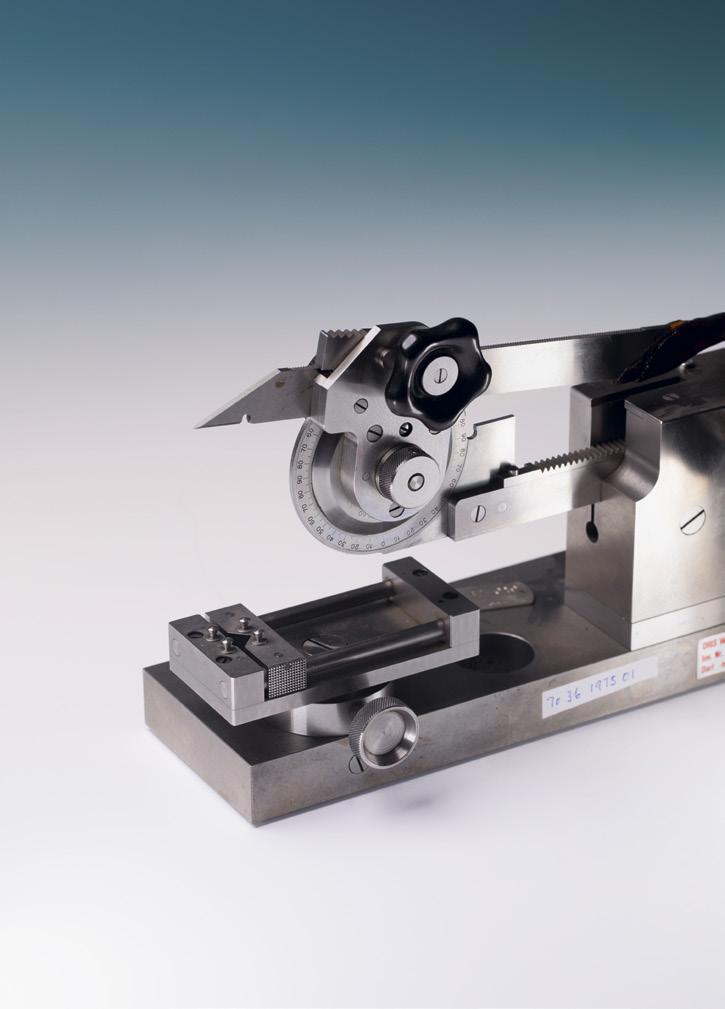

“Oris had created more than 270 calibres before 1980,” confirmed Herzog. “It’s part of our story and what makes Oris unique.We also had the talent in-house, so it was a natural step. Even then, it was a risk. It moved us into a new price segment. But the response was great and encouraged us to continue the programme.”
Risk be damned, Oris opted to leave their decades long Sellita-based comfort zone with the release of the Calibre 110, the initial offering of the Oris Movement Creation Programme in


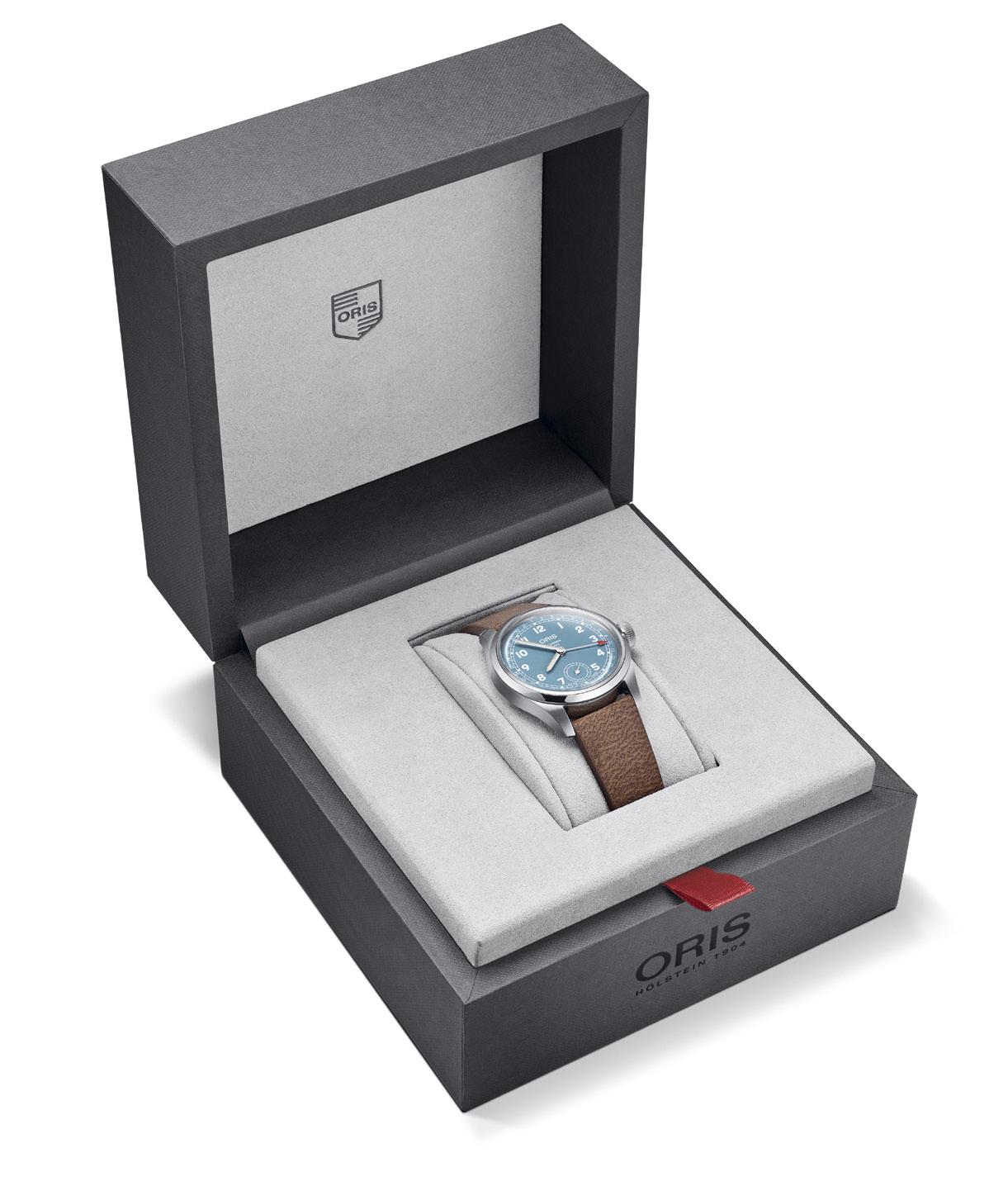
2014. It was the first completely in-house calibre the Hölstein-based watchmaker ever produced, and was the first of the Calibre 100 Series of hand-wound movements. It had a formidable 10-day power reserve, and became the driver of choice in many of the Pro Pilot collection and also in some Artelier pieces.
This was followed six years later by the groundbreaking Calibre 400, a powerful, antimagnetic automatic movement that made its debut in 2020 in the Aquis line of watches. It may have halved the power reserve of the Calibre 110 with “only” 5 days of autonomy, but made up for it with improved stability and reliability, which the watchmaker happily backed up with a 10-year warranty. Nine years and nine highly original and high performance calibres later, Oris presents the Calibre 473, the brand’s 10th original in-house calibre just in time for the 10th anniversary of the Oris Movement Creation Programme.
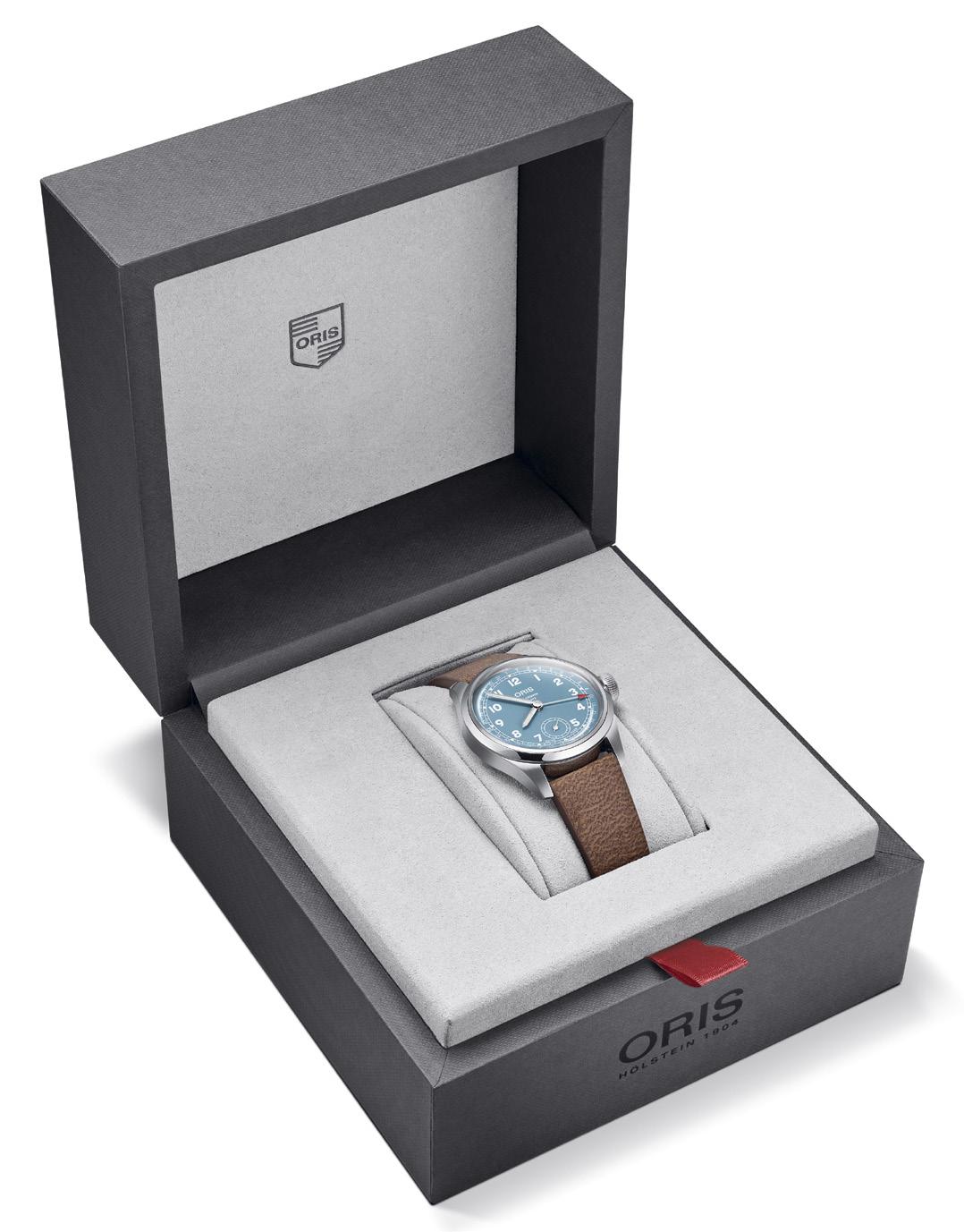

It is worth noting, however, how Oris defines the term “in-house.” According to Herzog, like the Calibres 110 and 400, the latest Calibre 473
is a proprietary manufacture movement that was developed exclusively by Oris watchmakers within the Oris workshops, the components of which are produced elsewhere by a network of different suppliers. “(In-house) means establishing specifications and the engineering concept, and financing tooling development and prototyping,” explains Herzog. “Know-how is in-house, manufacturing is by third parties, and we share assembly.”

This pragmatic approach to production has breathed new life into the brand’s signature design with the release of the Big Crown Calibre 473, the latest version in a long line of Oris Big Crown Pointer Date models. This new watch houses the latest, hand-wound mechanical movement designed from the ground up by Oris watchmakers. And you read that right: Calibre 473 is hand-wound, making this version of the Oris collection mainstay the first to be powered by a hand-wound movement in decades.
Based on the groundbreaking automatic Calibre 400, the new Calibre 473 is resilient, accurate, and equipped with elevated levels of
“Oris presents the Calibre 473, the brand’s 10th original in-house calibre just in time for the 10th anniversary of the Oris Movement Creation Programme”
anti-magnetism. It is built on the same chassis as the Oris Calibre 403, which made its debut driving the first completely in-house Big Crown Pointer Date released in 2021. Called the Hölstein Edition, that 250-piece limited edition sported a subtle grey color palette with updated case and dial details, all of which was meant to underscore the industrial production line Oris implemented in the first half of the 20th century. The nonlimited Big Crown Pointer Date Calibre 403 with a black dial and a black leather strap took up the mantle where the limited edition left off and was the only completely in-house Big Crown Pointer Date in production until now.

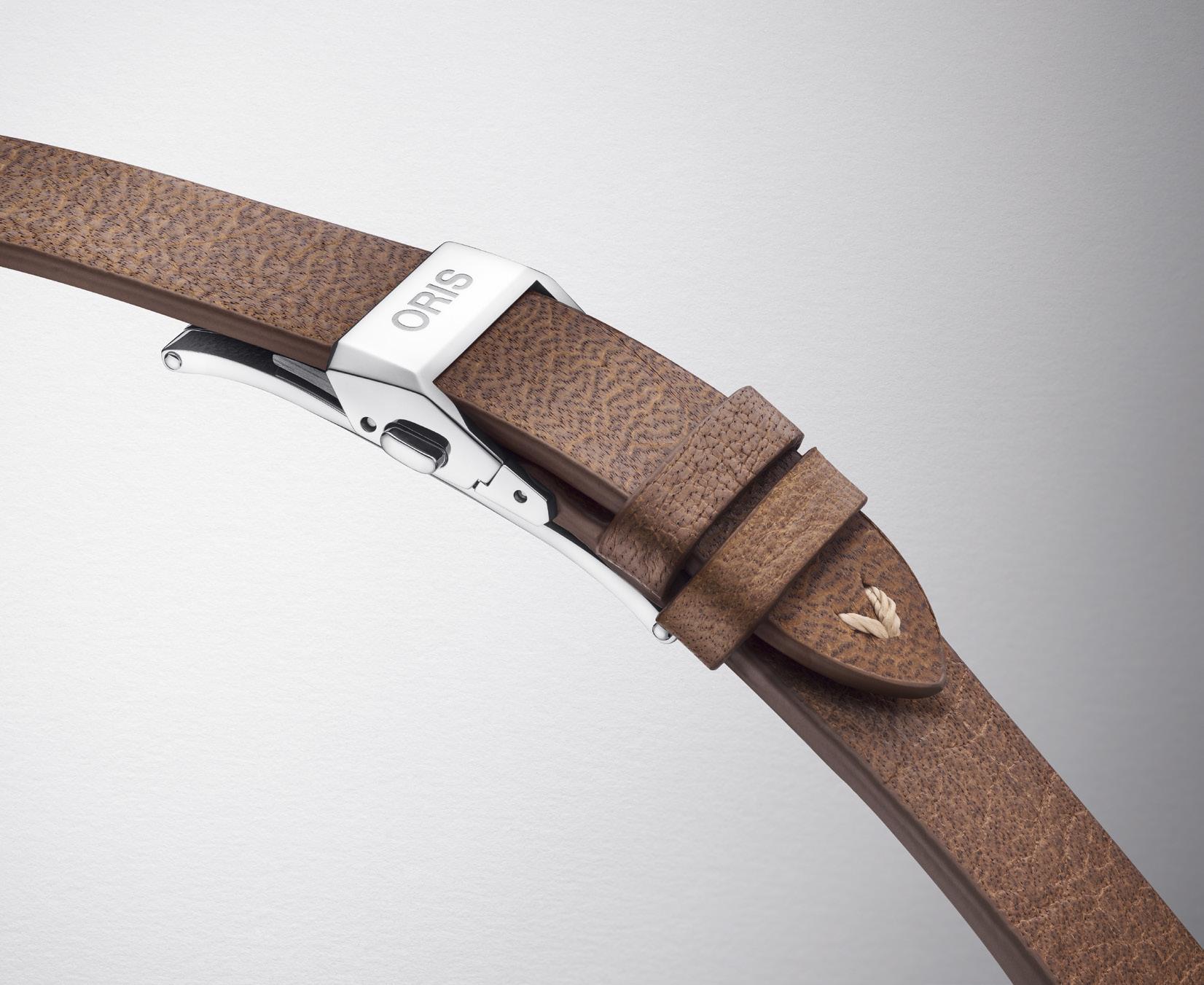
Just like the Oris Calibre 403, Calibre 473 is also an offshoot of the Calibre 400 that incorporates a small seconds and pointer date function, and offers all the technical benefits of its automatic sibling sans the rotor. This allowed the Oris watchmakers to engineer a 120-hour power reserve indicator on the back of the movement, which given that 5-day power reserve makes a lot of sense. Featured on the bridge over the barrel, the patented power reserve indicator has markings at 0, 24, 48, 72, 96 and 120, and is indicated by a blued hand.
Indeed, one of the advantages of the hand wound format is an aesthetic one: without a rotor, the movement can be admired through the caseback in all its glory. Not to mention there’s that everyday tactile interaction with the watch that an automatic calibre simply cannot reproduce. Just ask any watch collector. And to Oris’ credit, they’ve created a hand-wound movement that almost feels like an automatic with that extra-long power reserve of 120 hours, or five days.
A manually powered movement powering a Big Crown Pointer Date brings us back to the early flyboy days of the model. The raison d’être of the “Big Crown”, after all, was the oversized crown that allowed pilots to adjust the time on their timepiece without having to take off their gloves. The Big Crown, in fact, was reintroduced into the brand’s collection in 1984, and saved the company from the perils of the quartz crisis. And one of the most popular models has been the Big Crown Pointer Date.
In an interesting move, Oris downsized the 2021 Big Crown Pointer Date, which unlike most other 40mm Pointer Date models is sized rather conservatively at 38mm (maybe because the Pointer Date model made its debut in 1938?). And while that doesn’t exactly call attention to
itself 38mm is in the sweet spot for most wrist sizes out there, and is the most unobtrusive “large” size for everyday use. The finishing of the stainless steel case is a mix of satin brushed and polished surfaces; measures around 45.5mm from lug to lug; features a big screw down crown; provides 50 meters of water resistance; and wears a bit taller than its 12.5mm height would indicate due to the domed crystal, which bubbles up over the sloping and polished bezel; all of which gives the Big Crown the impression of polished sturdiness and dependability.
And there lies the rub: Oris watches are polished, Oris watches are sturdy, Oris watches are dependable, Oris watches also tend to be too subtle for their own good. On the onset the overall impression of Oris is that of a no-frills watchmaker, a no-ifs-or-buts type. A solid and dependable watchmaker that makes luxury watches that are good at their job and are a step up from basic “tool” watches. The new Big Crown Calibre 473 is no exception but at least it makes an attempt to “adjust” that perception. And that has a lot to do with subtle tweaks on the tried and tested Big Crown Pointer Date aesthetics.
Adopting the modified design aesthetics of the 2021 Big Crown Pointer Date Hölstein Edition, the signature fluted bezel that has been a feature of the Big Crown Pointer Date for years is gone on the new Big Crown Calibre 473, and has been replaced by a smooth, polished bezel, the slope of which melds fluidly with the domed sapphire crystal. As does the dial, which uses a different typeface for the printed white Arabic numerals that forgoes with the slimmer and more ornate typeface used on the previous models. It is bolder and somehow reminiscent to the white Arabic numerals seen on an elementary school chalkboard. The same goes for the cathedral type hands, they have been dropped in exchange for sword-shaped hands in the new model; as well as the crescent-shaped pointer date hand, which was swapped for an arrow-shaped one. And since the Calibre 473 is built on the base of the Calibre 403, the overall visual presentation of the watch has changed as well eschewing the centrally mounted seconds hand in favor of a small running seconds subdial at 6 o’clock. Then there’s the light blue of the lacquer dial, the particular tone of which is impossible not to be compared to the iconic color of a particular American jeweler. It may not be an
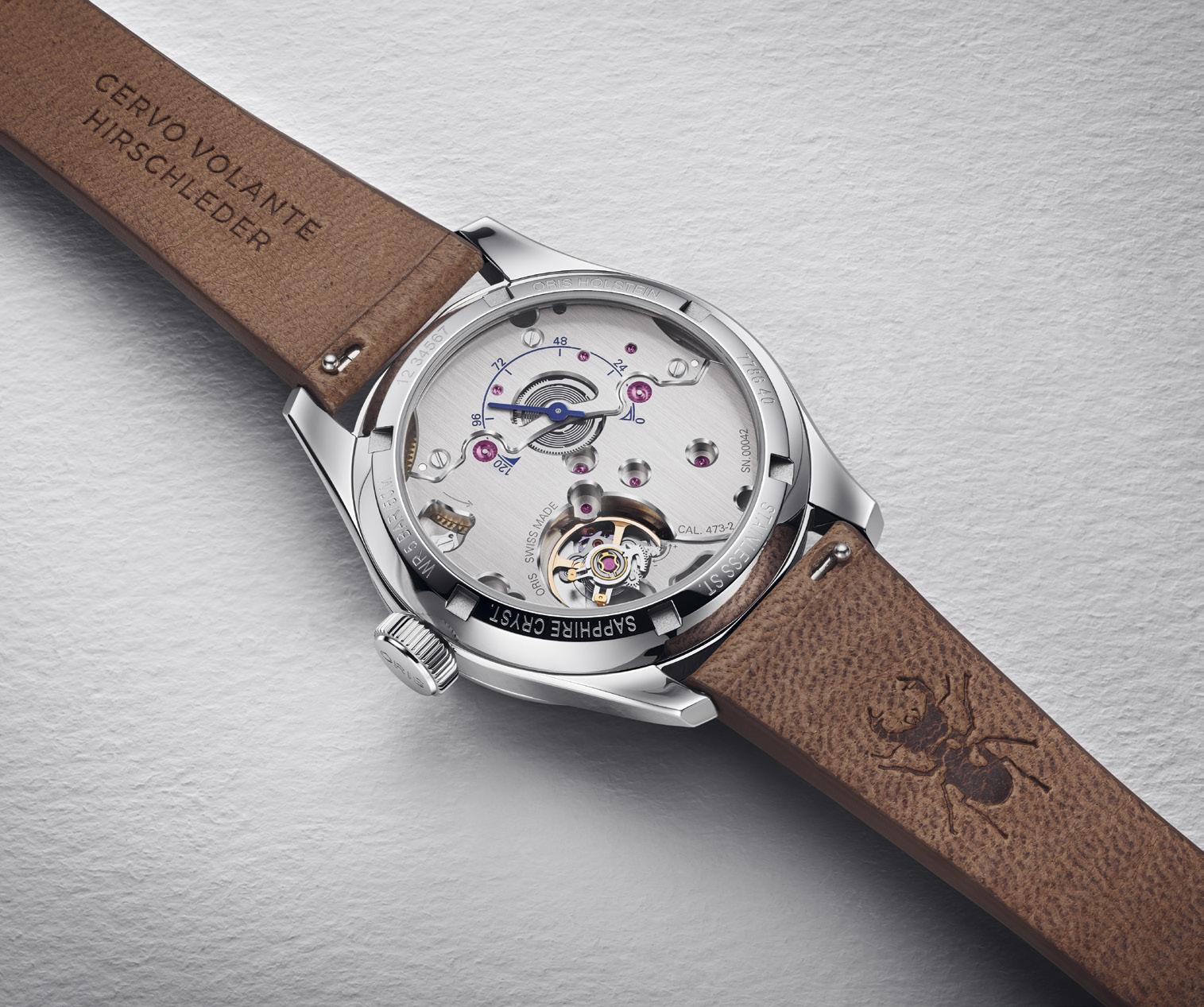
exact match but it’s close enough. And before anyone dismisses the choice as the watchmaker capitalizing on the current (albeit waning) Tiffany & Co. trend wherein every “relevant” brand used the color on, well, anything. Oris’ choice here makes sense. Not only does the color reinforce the “vintage” look even further, it’s a perfect match for the white printed Arabic numerals on the dial and the tan color of the strap.
Speaking of which, the Big Crown Calibre 473 is matched with an “olive brown” strap crafted from sustainably sourced deer leather produced by Oris’ Swiss partner Cervo Volante, the logos of which are the embossed stag beetle, and the “V” of off-white stitching on the straps. It is both pliant and extremely supple, and features Oris’ new stainless steel butterfly folding clasp with a fine adjustment system, which operates on
friction, meaning there are no holes to deal with. Only time will tell if this type of clasp will catch on, never the less…
The strap as well as the blue colored dial, and the white Arabic numerals make for an attractive vintage ensemble that’ll give anyone who wears the Big Crown Calibre 473 extra style credits. The color combination is also inherently casual, and can be a perfect match for any weekend or summer outfit. Another plus that can be added to the gains Oris already garnered with their 10th in-house calibre in as many years…especially with that 10-year warranty.
“Every Oris movement offers unique properties and performance, such as a five day power reserve and 10-year warranty, while still representing good value. Our calibres represent Oris values even better and our customers really welcome this.” — Ulrich
W. Herzog
Every issue, we try to bring the timepieces that we've seen at the shows and in different events we've attended both locally and overseas. These are the pieces that have caught our fancy and we hope they catch yours as well.



There are high-end luxury watchmakers, and there is Patek Philippe. Originally founded in 1839 by Antoine Norbert de Patek and François Czapek, the company became known as Patek Philippe & Co. when Patek formed a partnership with watchmaker Jean-Adrien Philippe in 1845.
Today, Patek Philippe is renowned for producing some of the world’s most complicated and exclusive timepieces, and has a reputation for using only the finest materials to produce some of the most technically impressive and aesthetically stunning watches in the world. The Patek Philippe 5935A World Time Flyback Chronograph is one of those watches.
First launched in 2016, Reference 5930 combined two iconic Patek Philippe complications: a World Time complication and a self-winding flyback chronograph. Patek was one of the first watchmaker’s to use the World Time complication developed by Louis Cottier, which allows for the instantaneous display of the world’s 24 different time zones represented by a rotating 24-hour ring with a city name representing each time zone. An exclusive patented mechanism aligns all displays with a simple press of the time-zone pusher at 10 o’clock. Simply use the pusher to rotate and align the selected city to 12 o’clock and the time in that time zone is displayed instantly by the main hour and minute hands. This, in conjunction with a dedicated 24-hour day/night indicator, indicates whether it is day or night in the selected time zone, which was all well and good. The Patek Philippe watchmakers, however, decided to makes things exponentially more difficult for themselves by adding a flyback chronograph complication.

A useful function for timing events that require precise measurements, the chronograph allows the wearer to measure elapsed time with the press of the chronograph start/stop pusher at 2 o’clock. Compliment it with a flyback function, however, and the user can quickly reset the chronograph by activating the flyback pusher at 4 o’clock and start timing a second, near simultaneous event without having to stop and reset the chronograph first.
Originally offered in white gold with a blue dial with a hand-applied circular guilloché pattern and blue alligator leather strap (5930G-001 then 5930G-010), Reference 5930 made a second appearance in platinum (5930P-001) with a green guilloché dial and matching green alligator leather
strap in 2021. And one of its main highlights (if not THE main highlight) was the fact that the Ref. 5930 World Time Flyback Chronograph was not only perfectly proportioned but also perfectly legible despite having a case only 39.5mm in diameter all whilst accommodating two complications notorious for having highly complicated layouts.
The Patek Philippe watchmakers got around this practical but seemingly insurmountable issue mainly by keeping the number of chronograph counters at its bare minimum. This means that if all other chronographs would normally have at least two counters, Ref. 5930 only had one. That’s right, the lone counter is at 6 o’clock to accommodate the 30-minute elapsed time, while the running seconds (which would normally be located on the flange) sat in between the rotating city ring and the dedicated 24-hour ring. And thanks to the vertical clutch ensuring minimal wear, the central chronograph hand can also be used to display the running seconds.
Alas, Reference 5930G-010 was discontinued
in 2020 to make way for a new model. Which is why the World Time Flyback Chronograph is back this year as the Patek Philippe 5935A World Time Flyback Chronograph (Ref. 5935A-001), which makes its third appearance in a material that may actually be more precious than either white gold or platinum: stainless steel, which in the world of Patek Philippe, is a rarity within the Manufacture’s collections.
The entirely polished stainless steel case is still water-resistant to a depth of 30 meters (which means the occasional splash while doing the dishes, only. Don't even think of going swimming with this watch) but is also slightly larger at 41mm, which was done (we presume) to give more space to the city disc thereby guaranteeing optimized legibility (as if the older models weren’t already the epitome of complicated legibility).
Decidedly warmer in tone than the first two iterations, Ref. 5935A-001 features a vintage-inspired rose-gilt opaline dial, the new salmon color of which has been described as a
“shimmering rose gilt hue.” It features a center bearing a “carbon” motif, the crisscross pattern of which is a reference to the decoration of a limited edition stainless steel Calatrava (Ref. 6007A) that celebrated the inauguration of the brand’s manufacture in Plan-les-Ouates in 2020, and complements the stainless steel Ref. 5935 with a dynamic and contemporary vibe.


To ensure optimal legibility the hand-applied baton-type hour markers and faceted dauphine hour and minute hands, all in charcoal gray white gold, have been generously treated with white luminescent coating, while the 30-minute counter
at 6 o’clock is also sportier than its previous iterations with a dark ring and contrasting snailed and salmon-colored interior.
The Patek Philippe 5935A is powered by the self-winding caliber CH 28-520 HU movement. This completely in-house flyback chronograph world timer movement is made up of 343 individual parts including 38 jewels, and features Patek Philippe's patented Gyromax balance and Spiromax balance spring, which can be admired through the sapphire crystal caseback. The movement spins at a frequency of 28,800vph while boasting a power reserve of up to 55 hours.

The Patek Philippe 5935A is a highly sophisticated and functional timepiece that combines a world time function and flyback chronograph complication with Patek Philippe's renowned craftsmanship and attention to detail. It is a sought-after watch among collectors and enthusiasts of fine horology, which joins the Ref. 5930P-001 in the regular collection. Last but not least, Reference 5935A-001 is matched with a calfskin leather strap in grained taupe, and comes with an additional calfskin leather strap in beige with a nubuck finish, both of which are secured by a steel fold-over clasp.

“The Patek Philippe 5935A World Time Flyback Chronograph (Ref. 5935A-001)... makes its third appearance in a material that may actually be more precious than either white gold or platinum: stainless steel, which in the world of Patek Philippe, is a rarity within the Manufacture’s collections.”
 Words by Bert Casal
Words by Bert Casal
As the sun breaks into the horizon, dark skies gently brighten, hues of orange and yellow appear, then slowly transition to blue. It is a magical hour that signals the start of a day. It is the moment when eyes awaken and the senses come to life. But the most spectacular display of lights in nature is found in the northern hemisphere, a show that has fascinated people for centuries. This is, of course, the aurora borealis, also referred to as the northern lights.
These beautiful waves of dancing light has captivated people for centuries, watching in awe as they move like ocean tides in the sky. But for all its grace and beauty, this spectacular light show is actually a violent event. The sun releases charged particles from its upper atmosphere, creating what is called the solar wind. This wind travels through space and hits the Earth’s atmosphere at speeds of up to 72
million kilometers per hour. As it slams onto the ionosphere (upper atmosphere), the particles are deflected towards the planet’s poles via the Earth’s magnetic field, depositing energy and causing our atmosphere to fluoresce. The bright colors of the northern lights are dictated by the chemical composition of the atmosphere.
With this in mind, Rolex unveils a new, colorful, and sparkling version of the Oyster Perpetual Yacht-Master 40 that harnesses the colors of the dawn and the aurora borealis.
The new Oyster Perpetual Yacht-Master 40 is cast from 18 ct white gold, a first for the model. It features a rotatable bezel set with trapezecut precious stones. Pink sapphire, light-blue sapphire, diamond, purple sapphire, and darkblue sapphire. This sequence of five hues are repeated eight times around the bezel, giving it a unique sparkle that is further enhanced by a triangular diamond at 12 o’clock. The case shines with 46 brilliant-cut diamonds from the lugs to the crown guard.

This new version of the Yacht-Master 40 is equipped with calibre 3235, a movement entirely developed and manufactured by Rolex. This calibre movement was released in 2015 and has been fitted on this model since 2019. This selfwinding mechanical movement incorporates the patented Chronergy escapement, which combines high energy efficiency with great dependability. Made of nickel-phosphorous, it is also insensitive to magnetic fields. It has an optimized blue Parachrom hairspring, manufactured by Rolex in a paramagnetic alloy. The blue Parachrom hairspring is equipped with a Rolex overcoil, ensuring the calibre’s regularity in any position. The oscillator is fitted on the Rolex-designed, patented high-performance Parallax shock absorbers, increasing the movement’s shock resistance. The self-winding module can store a power reserve of up to 70 hours.
The 40 mm Oyster case is crafted from a solid block of 18 ct white gold. The case back is edged with fine fluting and is hermetically screwed down. The Triplock winding crown, fitted with a triple waterproofness system and protected by an integral crown guard, screws down securely against the case. The Cyclops lens on the crystal allows for an easy reading of the date at 3 o’clock.
This timepiece is fitted with an Oysterflex bracelet which offers the robustness and reliability of a metal bracelet, yet provides the comfort and flexibility of an elastomer strap. This innovative bracelet, developed by Rolex, is made up of flexible, curved metal blades overmoulded with high-performance black elastomer, a material that is particularly resistant to environmental effects. It is equipped with the Rolex-designed and patented Oysterlock folding safety clasp in
18 ct white gold. It also has the Rolex Gridlock extension system which comprises a rack located under the clasp cover and a toothed sliding link that locks into the chosen notch. This allows easy size adjustment of up to 15 mm.

It goes without saying that this new Oyster Perpetual Yacht-Master 40 is covered by the Superlative Chronometr certification. This designation testifies that every watch leaving the brand’s workshops has successfully undergone a series of tests conducted by Rolex in its own laboratories according to its own criteria, following the official certification of the movements by the Swiss Official Chronometer Testing Institute (COSC). The fully assembled watch is certified to have a precision of -2/+2 seconds per day, a deviance more accurate than that accepted by the COSC.
Rolex has captured the beauty of the northern lights and put it on their new Oyster Perpetual Yacht-Master 40. Now, you don’t have to travel far to see the aurora borealis. All you need to do is to look at your wrist.



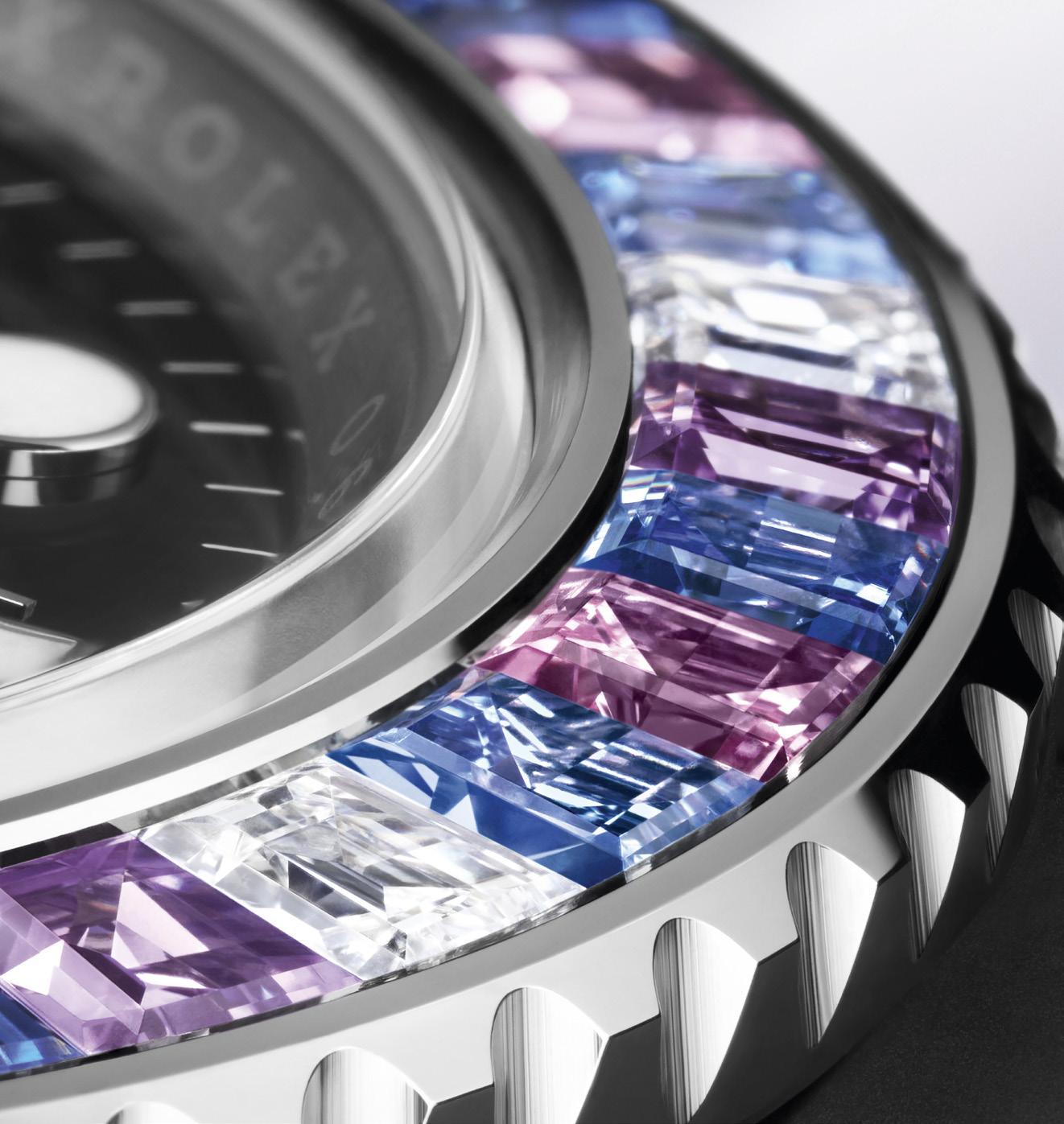
harnesses
beauty of the aurora borealis.”

 Words by Kit Payumo
Words by Kit Payumo
Hublot is one those rare watchmakers that seem to illicit a love it or hate it response from watch enthusiasts in general. To be fair, Hublot has always happily marched to its own beat, consciously creating timepieces that boldly stand apart from the norm. In fact, Hublot has spent the better part of the last two decades singularly focused on expanding its reputation as a watchmaker that makes big, brazen, and LOUD looking watches to equally singular effect. And one of those watches is the MP-09 Tourbillon BiAxis 5-Day Power Reserve, which Hublot exploded with in 2017.
A real showstopper of a watch, the frankly gargantuan 49mm MP-09 Tourbillon Bi-Axis took all of Hublot’s patented bombastic watchmaking skills and fused it into a single verbose timepiece. The manually wound timepiece immediately set itself apart mechanically and aesthetically even within Hublot’s own diverse collections not only by being the brand’s first multi-axis tourbillon, but also by featuring a case and sapphire unlike anything seen before.
For the uninitiated, the MP-09 Tourbillon Bi-Axis’s massive 49mm case made from carbon fiber earned multiple wow-factor points by protruding at the 6 o’clock position to prominently display the bi-axis tourbillon. Naturally, a large and asymmetric sapphire crystal had to be specially conceived in order cover this elaborate dial: forged as a single piece, it curved heavily towards the bottom of the case to create a large two-sided display window for the tourbillon. And despite its ultra-modern, high-tech architecture, the HUB9009.H1.RA.B movement runs at a very traditional frequency of 3Hz or 21,600vph, because of this the MP-09 Tourbillon Bi-Axis boasts a power reserve of approximately 120 hours or 5 days.
To be fair, the use of the word “dial” may be a bit misleading since the face of the watch is made up of a large skeletonized main time indicator at 2 o’clock; an arced date display in two layers below that; and a skeletonized power reserve indicator at the 8:30 position. A winding crown at 3 o’clock offered access to the movement, while a
separate up and down switch on the opposite side of the case at 9 o’clock independently adjusted the date display. A large sapphire crystal fitted on the caseback, and a specially designed integrated rubber strap added the finishing touches to one of Hublot’s more “interesting” creations.
But what happens when you take the already outrageous MP-09 Tourbillon Bi-Axis 5-Day Power Reserve and dial it up to eleven? A watch that takes the “basic” architecture of the MP-09 and runs it through the rainbow washing machine is what.
Called the MP-09 Tourbillon Bi- Axis Rainbow 3D Carbon, the new watch is essentially a multi-colored, 8-piece limited edition of the already existing in-your-face model. But instead of going the variously colored gemstone route, which most other watchmakers are wont to do, Hublot decided to makes things exponentially more difficult by recreating the rainbow spectrum out of carbon fibre composites.
The new Hublot MP-09 Tourbillon Bi-Axis Rainbow 3D Carbon, therefore, takes the iconic Rainbow “design” and literally thrusts it into the

“HUBLOT HAS RELEASED THE WATCH IN DIFFERENT COLORS BEFORE, SPECIFICALLY IN GREEN, YELLOW, BLUE, AND RED. BUT TO SEE ONE CHANNELING ALL THE COLORS OF THE RAINBOW AT ONCE IS CERTAINLY SOMETHING TO WRITE HOME ABOUT.”
21st century, Hublot style. And while the overall design and features of the new rainbow version doesn’t deviate from the existing collection of MP-09 Tourbillon Bi-Axis watches, it’s carbon fibre case certainly does, and that has all to do with the innovative way that Hublot was able to achieve the unique multi-colored gradations on the carbon fibre used in its construction.
Starting with the gemstones, it’s worth noting that there aren’t any, and instead of choosing from stones that have already been formed over millions of years and then assembling them according to their color, Hublot chose to have their work cut out for them by creating each colored facet one by one, and setting them within a “braided” carbon fibre case.
To be fair, Hublot the innovator has long cultivated a reputation for pushing the envelope with regards to new and innovative case materials. But the brand’s greatest achievements in this regard have been in the use of ceramic. Having said that, carbon fibre has also played a prominent role within Hublot’s diverse catalog,
and this rainbow-colored 3D carbon case certainly represents another first in the everexpanding Hublot collection.
“We have mastered Carbon.We have mastered traditional Rainbow setting. But no one was yet to master 3D carbon with the Rainbow effect, quite simply because no one had thought about it. That is what makes Hublot different: we explore the unknown regions of Haute Horlogerie. This new ‘MP’ is therefore not just another Manufacture Piece: it embodies what Hublot is. Being first, unique and different. And that will never change.” – Ricardo Guadalupe, HUBLOT CEO.
Hublot had to first develop a complete prism of different colored pieces of composite inserts that recreated the brilliance of gemstones. And in order to achieve the complete rainbow effect hundreds of individual colored inserts had to be created, a near-infinite number of shades of which had to be produced in order to reproduce a natural gradation effect. To make matters worse, it was determined during the research and development process that these inserts darkened

slightly once set within the carbon case. This necessitated the need to produce even more brilliant colored inserts since the final result would be darker once the inserts were finally set in place and not achieve the colorful “pop” that the watchmakers wanted.
To create the case, thin bars of carbon are fist laid flat a few millimeters apart. The colored composite inserts are then individually selected to create a rainbow pattern and placed vertically into the gaps. These inserts will protrude slightly from the carbon material and to level them off requires a third carbon mesh to raise all the different elements to the same level. To create the seamless “one piece” effect, both the carbon and composite inserts are threaded across all three dimensions (length, width, and height), essentially forming one singular woven mass.

The result is a complex, pixelated rainbow pattern that encompasses the entirety of the MP09 Tourbillon Bi-Axis’s multidimensional case body, the surface of which is entirely smooth and polished to the touch. Each insert is imperceptibly cropped with carbon and polished and adjusted to the nearest micron. And while Hublot has released the watch in different colors before, specifically in green, yellow, blue, and red, to see one channeling all the colors of the rainbow at once is certainly something to write home about.

Various elements incorporated into the basic design of the MP-09 Tourbillon Bi-Axis highlight the colorful nature of this Rainbow 3D Carbon version, not the least of which are the various hues on the hour markers and power reserve that reflect the various shades of the case, as well as a bespoke alligator leather strap that replaces the rubber strap on “standard” models, which looks like it had just escaped from a tie-dye factory.
Just when you thought we had seen it all from the Nyon-based watchmaker, Hublot shocks us with the MP-09 Tourbillon Bi-Axis Rainbow 3D Carbon. It takes all the colorful, and unapologetically bombastic watches the brand had created before, and throws all of them out the window. To think, the MP-09 Tourbillon BiAxis series of watches were already one of the brand’s more outrageous offerings, this Rainbow 3D Carbon version simply ups the ante by dialing things up to eleven. And have we mentioned only 8 numbered pieces will be made?
In the end it is Hublot once again doing what it does best: developing a mind-blowing movement, encasing it in an innovative material, developing an outrageous design, and curating it all together in one flashy Hublot-style package that will surely be talked about for years to come. Take it or leave it.


Evolution is an interesting phenomenon. As defined, evolution is the gradual development of something, from a simple form to something more complex.
You start with something possibly basic then add aspects of interest or improvement. Each iteration has the classic DNA of the original creation, but is somehow better. Cleaner, more intricate, more impressive.
Such is the story so far of the Bvlgari Octo, though we wouldn’t describe the watch as basic. The Octo was initially released in 2012, and had the combination of Italian architectural touches and Swiss watchmaking skill. The lines were clean and definitely masculine, but not overly imposing. It was the perfect collaboration resulting in a new iconic watch for Bvlgari. The look was luxurious and sporty at the same time, with a squarish case and exquisite details.

Just two short years later, Bvlgari released the Octo Finissimo, bringing the watch to higher depths, or should we say, thinner widths. The thinner profile offered a lighter watch but also presented the challenge of designing something mechanically impressive yet not large or heavy on the wrist. It didn’t just look cool, it had to be
functional too. Bvlgari rose to the challenge, as they often do. Bvlgari has won acclaim rather regularly at the Grand Prix d'Horlogerie de Genève (GPHG), with awards in 2017, 2019, 2021, and 2022. They don’t rest on their laurels though, as they keep striving and looking forward.

And in 2022, Bvlgari again leveled up the watch with the Octo Finissimo Ultra 10th Anniversary to celebrate the Octo’s 10th anniversary. Measuring just 1.8mm in thickness, this watch is ultra thin (no pun intended), ultra luxurious, and ultra fascinating. And yes, it won the Audacity Prize at the 22nd Grand Prix d’Horlogerie de Genève. The watch comes from a line of winners though, since the Octo Finissimo won the Aiguille d’Or Grand Prix at the GPHG in 2021.
The Octo Finissimo Ultra 10th Anniversary has all the design elements that made the watch such a success a decade ago. The case is still squarish, though it looks a smidge longer than it is wide. The titanium case and bracelet make for a handsome watch on your wrist. This ultra thin watch has the BVL Calibre 180, a mechanical ultra-thin manual winding movement. It has the hour and minute counters, though not in the typical run-of-the-mill displays.
A look at the intricate dial is all you need to be convinced that the watch is amazing. How did they fit all that in there, and still keep the watch ultra thin? Did you see the subtle nod to the decade of the Octo on the hour subdial? Only the 10 o’clock has a numeral, while the other hours have classic line markers. Look closer and you’ll see a QR Code on one of the subdials. Aside from the design aspect it brings to the alreadyarchitecture-inspired watch, the QR Code brings a new level of engagement and interaction for the owner. Scan the code and you get access to your own website with pictures and videos of how your watch was constructed. There are also sketches depicting the design process come to life, and interviews with the skilled watchmakers behind the just 10 watches in this limited edition. It’s the story behind your own Octo.

But wait, there is more. The story does not end there. Fabrizio
Buonamassa Stigliani, Product Creation Executive Directorat Bulgari Watches, has created an NFT artwork for the watch. NFT stands for ‘non-fungible token,’ in essence a digital file that is secure and can also offer security of ownership. Think of the provenance of a piece of art, only the original owner never gives up the piece of art. NFT is definitely a thing of the future, and to Bvlgari is happy to bring you there with your Octo.

Bvlgari sure knows how to keep things interesting. Because, yes, there is even more. The Octo Finissimo Ultra 10th Anniversary comes with a presentation box. You’ve never done unboxing until you’ve unboxed your Bvlgari watch. More than just a pretty place to store your watch, the presentation box serves an important function. Of course you can wind your watch by hand, and winding this watch must be a joy, with something so thin. But Bvlgari now gives you another, equally enjoyable, way to wind your watch. Place your watch in the center of the box, where it fits perfectly, and with a few button pushes, the box will not only wind the watch for you, it will even set it to the desired time. All it will take is a few pushes of buttons and closing the box, and in just 20 seconds, your watch will be properly set and ready to go. There are buttons on the lefthand side of the box with a digital display so you can set the watch exactly. The righthand side of the box houses the charging cord. The presentation box reinvented, if you will, gives you the chance to play watchmaker in the comfort of your own home (black gloves optional).
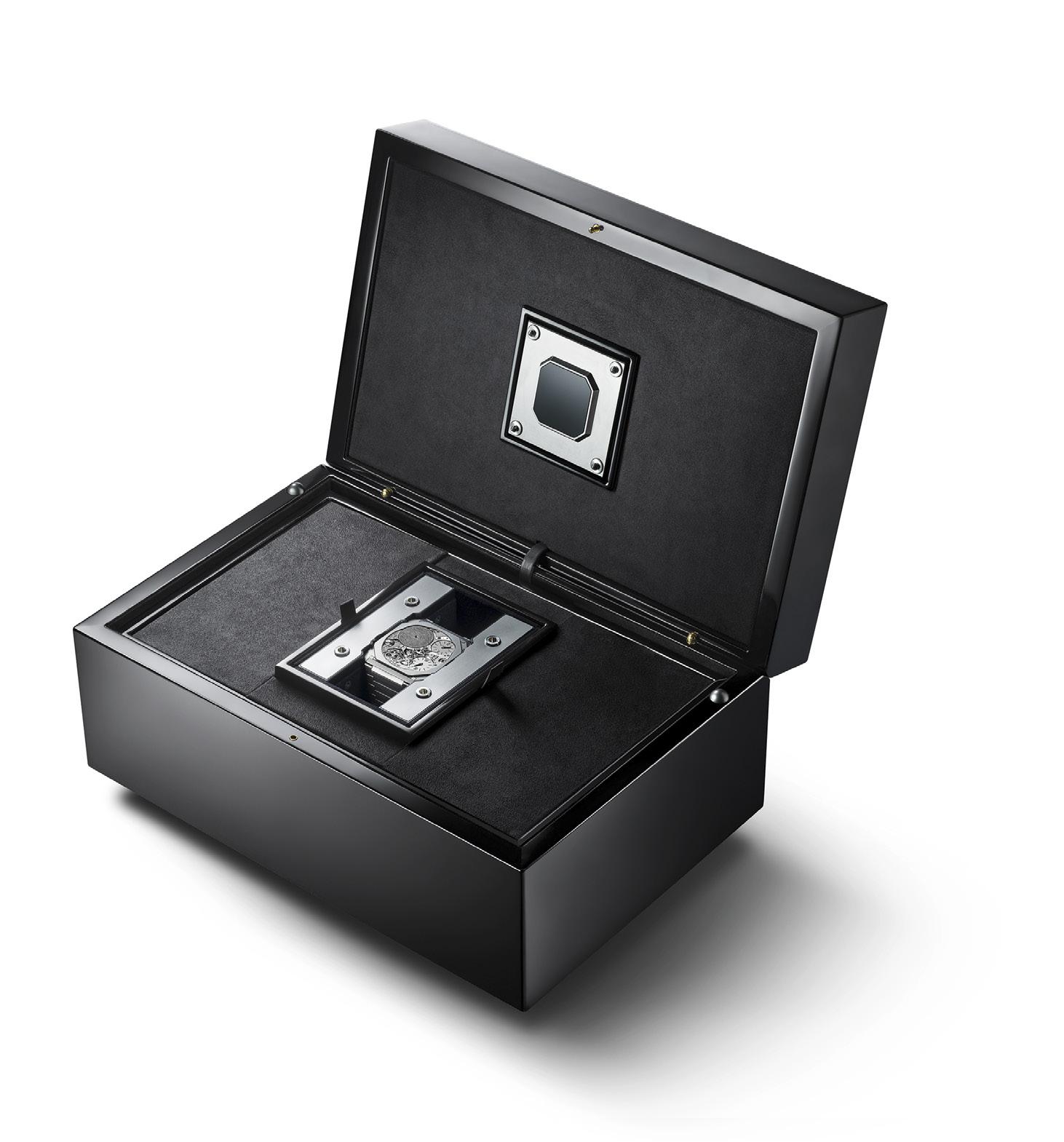
The Bvlgari Octo Finissimo Ultra 10th Anniversary has the strength of the history of Bvlgari watchmaking behind it, and the confidence to forge ahead into the world of NFTs and the digital dimension. The decade that has passed is proof positive of the future they will continue to lead with audacity.

“The Bvlgari Octo Finissimo Ultra 10th Anniversary has the strength of the history of Bvlgari watchmaking behind it...”


Asilhouette can be very powerful. It may be just an outline, but the original can be so distinct that the silhouette is easily recognizable. Think of the face of a distinguished gentleman and his profile. Or the body of a bombshell, that even in silhouette is recognizable. Many cars have distinct profiles too, and you can identify them just from the outline.
Watches are not immune from this phenomenon. Sometimes you catch a glimpse of the watch’s outline beneath a shirt cuff, and you can still figure it out. That silhouette is so unique, it is an easy tell.
Just like with the Girard-Perregaux Laureato. The Laureato was initially introduced in 1975. The watch was a masterful combination of contrasts that resulted in a very handsome watch. The watch was well-suited for business events, but was not out of place on the weekend either. Over the years, Girard-Perregaux has added complications or used different colors or materials, but the silhouette remained.
For 2023, Girard-Perregaux has released two models for us: the Laureato Absolute Light & Shade, and the Laureato Absolute Light & Fire.

Of course, the silhouette is the same in either model. That distinct powerful shape shouldn’t be altered too much. The watch models share other similarities; but each one has its own personality to it, if you will.

The Light & Shade model (reference no. 8107143-2022-1CX) and Light & Fire model (reference no. 81071-44-3115-1CX) are each a pairing of straight lines and sleek curves. The watch has traditional touches, but is also extremely modern. The watch has the hours and minutes, with the small seconds, all very classic. But the skeletonization makes it oh-so-modern too. It has clean functionality, but boy, does it look great. The skeletonized watch is always a marvel to see –the inner movement must be neat and finished to perfection because you can see everything quite easily. Nothing is hidden behind a plate, so extra care and effort has been taken.
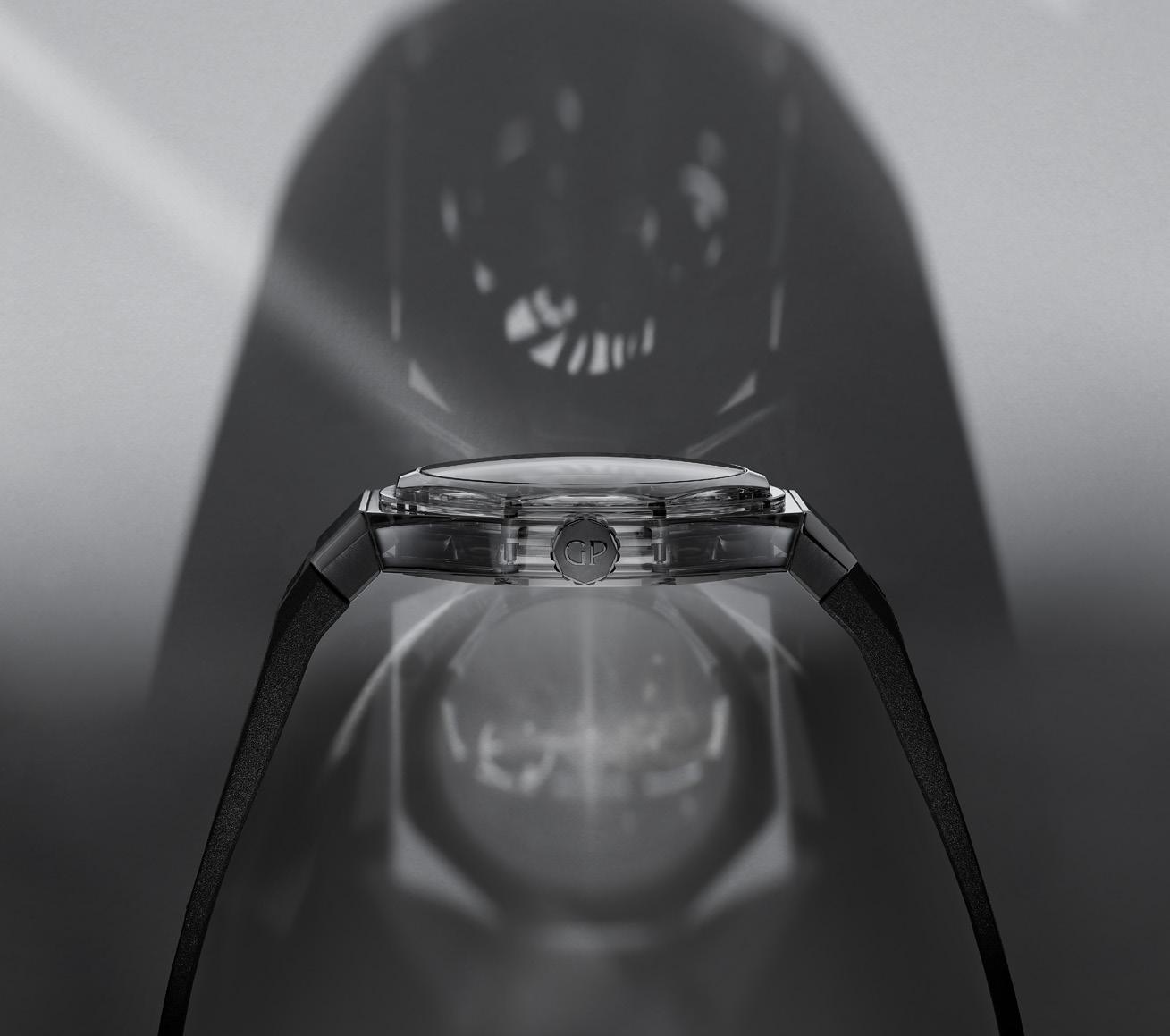
Both models come in 44mm in diameter and a height of 11.56mm. The GP logo appears at the 12 o’clock on the skeletonized dial. The casebacks are anti-reflective sapphire crystal, and the straps are in black rubber with a fabric effect. Each model has the self-winding mechanical movement, composed of 72 jewels, and has the

hours, minutes, and small seconds. The power reserve of 54 hours means you can go a couple days without worrying. Take another look at that movement – the octagonal shape is a tip of the hat to the Laureato’s bezel. Yes, another easilyrecognizable silhouette.
The Laureato Absolute Light & Shade has a classic black and white palette; or should I say, black and clear. The watch case itself is metallized crystal sapphire, so it is transparent. Yes, you read that right. The watch case itself is crystal, not just the case back. How do you get such a large piece of sapphire crystal?
Well that takes a lot of science, a lot of effort, a lot of patience. Creating crystal in a lab can take as long 8 weeks, like in the case (no pun intended) of these watch cases. The scientists use the Kyropoulos growth method to transform alumina powder into a solid block of sapphire crystal. This method uses a specific temperature protocol to achieve clean sapphire crystals that are large enough, sometimes larger than 100mm. This method was an improvement on the previous method that was typically in place to create crystals, but often resulted in smaller sizes. Bigger is better, some people say, and in the case
of the Girard-Perregaux’s need for the Laureato’s sapphire crystal, this rings true.
With a crystal of the correct large size, the skilled workmen would then cut the proper pieces for the bezel, case middle, and caseback. The next step is thermal treatment then polishing, followed by a stringent inspection and quality control. Only the perfect pieces make into the next step in the process: metallization within a vacuum. This results in a smoky appearance on the crystal, which adds to the overall look of the finished watch.

The Laureato Absolute Light & Fire takes the walk on the wild side, with a black and red palette. Red signifies passion, power, and energy. This watch does have a sapphire crystal caseback, but the case is made of a different polycrystalline material named YAG. It is also translucent, and scratch resistant, but can be developed in different shades. This was critical to the Light & Fire model, for that deep rich red hue. The tips of the hour and minute hands have a touch of red too, to echo the brilliant red from the case. The red stitching on the strap extends the vibrant hue even more. For Girard-Perregaux, the Laureato Absolute Light & Fire is meant as the ideal watch for Chinese New Year, and is limited to just 18 pieces.



 Words by Bert Casal
Words by Bert Casal
The ZENITH DEFY is a very important collection for the brand. It was first introduced in 1969 and had an unusual case shape to go along with the styles of the 1960s and 1970s. It was originally made in a thick octagonal case, had a mineral crystal, and a screw down case back to make it water resistant. It was introduced to the market with a relatively plain dial.
But in this present day, the dials of the DEFY are anything but plain. This year, ZENITH is building up the different lines within the DEFY collection. A batch of new watches are filling in the spots, concentrating on more creative and daring designs. Here are their latest additions:
The DEFY Skyline Skeleton is housed within an angular 41 mm steel case. The symmetrical skeleton dial takes the form of a four-pointed star, in a nod to the ZENITH “double-Z” logo of the 1960s. The baton hour markers, as well as the central hour and minute hands are filled with Super-LumiNova, a feature that lacks in most skeleton watches. The 6 o’clock position displays a constantly running 1/10th of a second counter that makes steady jumps in fixed increments, completing one revolution every 10 seconds.
The open dial comes in two versions: black and blue. The skeleton’s main plate, as well as the bridges and open star-shaped oscillating weight are finished in the same color for a cohesive look. Matte, satin-brushed, and polished finish surfaces further accentuate the depth and intensity of the color. Following the unique octagonal geometry of the early DEFY models, the sculpted steel case of the DEFY Skyline Skeleton retains the same DNA of robustness and durability as its predecessors. The faceted bezel is reminiscent of those from early DEFY models, reimagined with twelve sides that are positioned as extensions to the hour markers.
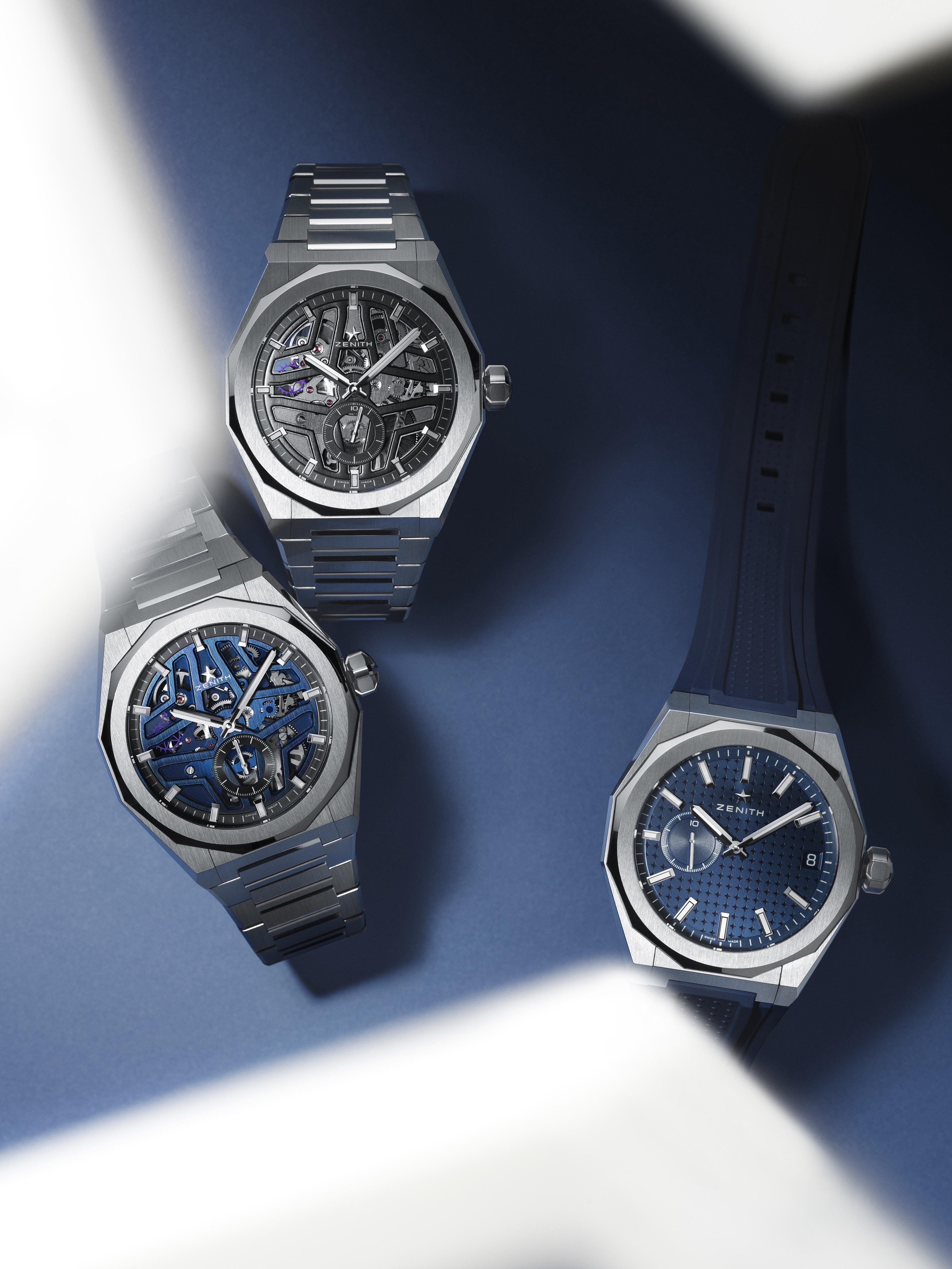
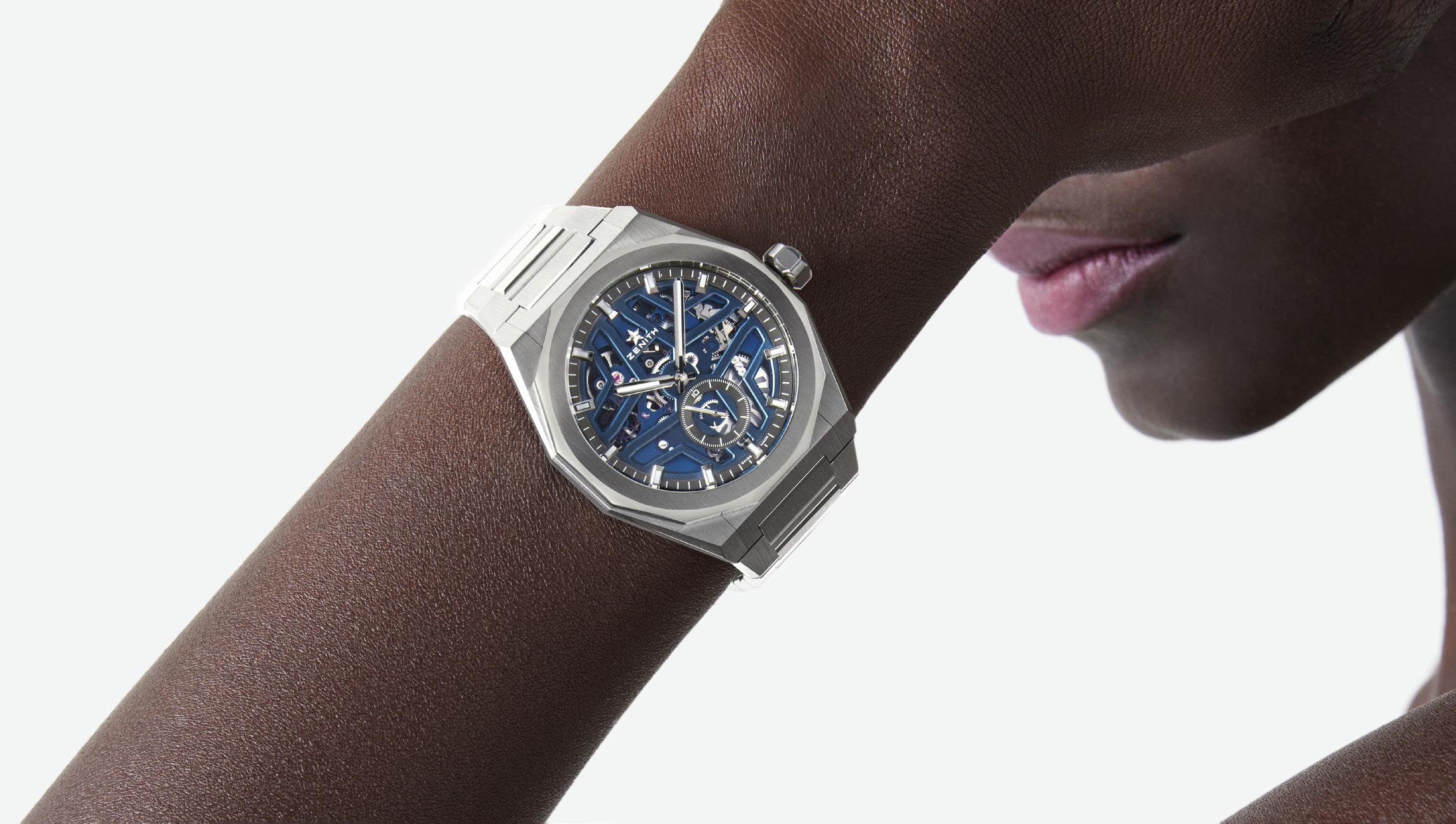


This DEFY model is powered by the highfrequency automatic El Primero Calibre, the 3620 SK. This automatic manufacture movement drives the 1/10th of a second hand directly from the escapement, which beats at 36,000 vibrations per hour. Its efficient bi-directional winding mechanism delivers a power reserve of approximately 60 hours. The DEFY Skyline Skeleton features the quick strap-change mechanism. The steel bracelet with a satin brushed surface with chamfer and polished edges can be easily swapped with the supplied rubber strap.
In 2021, ZENITH launched the DEFY Extreme Desert to highlight the environments that the DEFY Extreme was destined for. This year, they decided to go the opposite end of the spectrum, going from extreme heat to extreme cold.

Presenting the DEFY Extreme Glacier.
This new DEFY Extreme watch is encased in a 45 mm titanium case. The pushers are crafted from chalcedony, a crystalline semi-translucent stone with a pale blue hue that evokes the frozen glaciers. Meticulously cut and polished by hand, each stone is different and exhibits slightly different colors, making each of the 50 examples of the DEFY Extreme Glacier essentially a unique piece.
The open dial reveals the inner workings of the innovative and singular El Primero 1/100th of a second automatic high-frequency chronograph calibre 9004 and its two regulating organs beating at 50 Hz for the chronograph and 5 Hz for the timekeeping. The chronograph counts are made in transparent sapphire crystal with a frosted finish. This wristwatch comes with a durable black Velcro strap and white rubber strap, which can be easily swapped with the titanium bracelet using the quick strap-change mechanism.
Following the phenomenal reception of the DEFY Skyline collection last year, ZENITH is pleased to introduce its first boutique-exclusive edition of the groundbreaking model. Housed in a 41 mm angular steel case with a dodecagonal bezel, the DEFY Skyline Boutique Edition stands out with its radiant anthracite dial, engraved with a rose gold motif and set with rose gold hands and hour markers. The visual animation is one of a constellation of golden stars twinkling against the night sky.
Powered by the El Primero 3620 automatic high-frequency calibre, the DEFY Skyline Boutique Edition features a unique running 1/10th of a second indicator that’s driven directly from the 36,000 Vph escapement. The movement is visible through the sapphire crystal case back. The efficient automatic winding mechanism with bi-directional rotor delivers a power reserve of approximately 60 hours.
This very first Boutique Edition comes with a steel bracelet with a satin-brushed surface with chamfered and polished edges. A black rubber strap with a starry sky pattern is also provided with a step folding clasp and can be easily swapped without the use of any tools, thanks to its quick strap-change mechanism.

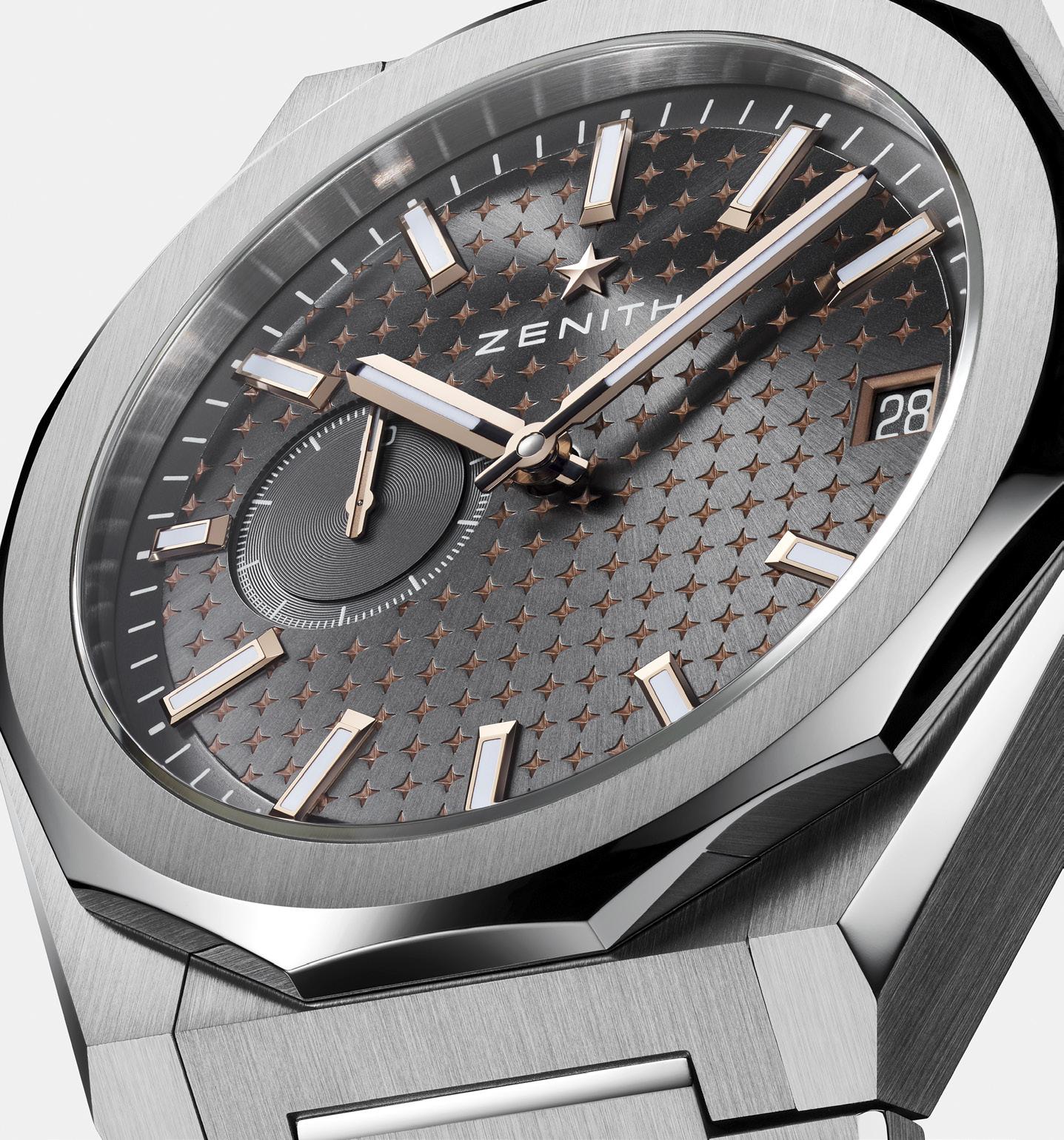
“ZENITH is further building up the different lines within the DEFY collection, synonymous with the Manufacture’s unique take on progressive watchmaking”

PANERAI AND BRABUS HAVE POWERED BACK UP WITH ANOTHER LIMITED EDITION COMPANION TO A NEW HIGH PERFORMANCE POWERBOAT
Words by Kit Payumo


“It’s definitely not for the faint hearted, and is a perfect fit for those who are ready to push boundaries and make indelible statements.”
The two power players are back: Panerai, a legacy watch brand that merges the finesse of Swiss watchmaking with the flamboyance of artful Italian design, and BRABUS, one of the world’s leading power brokers in extreme automotive aftermarket tuning, take their next step in a match made in heaven that brings together horology and high performance day boating. The boat in question is the BRABUS Shadow 900 Stealth Green Signature Edition, and its horological limited edition companion is the Panerai Submersible S BRABUS Verde Militare Edition.
A “striking embodiment of uncompromising marine high-performance and modern outdoor lifestyle,” the 38-foot Stealth Green Signature Edition is the newest addition to the BRABUS Shadow 900 range of powerboats. It impresses with its evocative style and high-class functionality, which combines a distinctive BRABUS “Stealth Green” paintjob with the contemporary outdoor aesthetic of one of the tuner’s most popular powerboat models. And with a top speed of 111kmh courtesy of 900Hp, the BRABUS Shadow 900 Stealth Green Signature Edition has what it takes to conquer the wildest oceans in typical BRABUS fashion. Indeed, it’s definitely not for the faint hearted, and is a perfect fit for those who are ready to push boundaries and make indelible statements.
The combat-ready 47mm Panerai Submersible S BRABUS Verde Militare Edition is certainly cut from the same cloth, and is the fourth limited edition to come out of the two brand’s clandestine operations following the Experience, the Black Ops, and Blue Shadow models. Highlighted by the same shade of BRABUS “Stealth Green,” the new Verde Militare Edition takes its covert ops persona from an appropriate mentor, the high-tech Panerai Submersible S BRABUS Black Ops Edition
This means the new watch shares many features established by the collaboration’s second limited edition, not the least of which is the use of Carbotech, a composite material first used in the industry by Panerai. It is lighter than steel or titanium and is highly resistant to corrosion. Further, Carbotech is strong and adaptable, making it easy to wear especially in harsh conditions. This dark carbon composite with surfaces that show subtle wave-like patters was singularly employed for the Verde Militare Edition and used liberally on its extra-large 47mm case; its unidirectional, anti-clockwise rotating bezel; and its signature Panerai crown protection with its locking mechanism.
The composite was shaped by a completely novel manufacturing process called Direct Metal Laser Sintering, a new method of 3D printing technology that produces volumes that are both strong and lightweight (that’s right: 3D printing, which, believe it or not isn’t confined to just plastic), and involves sintering (not melting)
fine 20-40 micrometer wide metallic powder; a process that fuses the particles together to create pieces that are more porous than pieces created by the melting method (thus, the lighter weight). Simply add layer upon layer of the powder and continue the sintering process until the final shape is formed. This allows the printing of alloys containing materials with different melting points, and even allows the combination of metal and plastic materials.
Coming back for power duties is the skeletonized version of the calibre P.4001, called P.4001/S that made its debut in the Black Ops Edition. The product of three years of development, the P.4001/S caliber includes a GMT function, an AM/PM indicator at 9 o’clock, a three-day power reserve courtesy of a one-piece off-centered oscillating weight that allows for bidirectional winding; a tungsten oscillating rotor, a shiny, high density metal that results in a much thinner movement, and therefore a much thinner and lighter watch; as well as a stop balance wheel, and seconds reset devices that allows the time to be synchronized with a reference time signal.
The multi-spoke, steering wheel-shaped bridge with the BRABUS logo at 7 o’clock, as well as the patented polarized date display, which offers a view of the date indication only through the opening at 3 o’clock without revealing the rest of the date wheel or concealing the workings of the movement also make welcome returns. The latter is made possible by a date wheel and date window angled 90° to each other acting as polarizers, and coupled with a piece of polished metal achieves the effect. The Panerai engineers are so proud of their work in fact that the words, “OPTICAL POLAR DATE” prominently points to the display from the dial’s outer green flange.
Available in a limited edition of 200 pieces, the Verde Militare Edition features “Stealth Green”colored accents throughout the entirety of the watch including the hands, the rehaut, rubberized crown, the AM/PM indicator and the small seconds sub-dial. Further, the power-reserve indicator with its clear rotating disc can once again be found on the caseback and like the rest of the watch now features green details making it a nice counterpoint to the polarized date window out at front. Water-resistant to 300 meters (30 bar) the Panerai Submersible S BRABUS Verde Militare Edition is matched with two straps, a bi-material option combining black rubber and calf leather melded with a rubber base and green stitching, and a second made of pure rubber and colored (you guessed it) “Stealth Green.” Both straps are fastened by a trapezoidal titanium buckle with DLC coating.

In 2021, IWC Schaffhausen introduced the Pilot’s Watch Chronograph 41. With a case diameter of 41 and a lug-to-lug distance of 51.8 mm, this chronograph offers excellent wearability, even on slender wrists. It had a 10-bar water resistant case and featured the integrated EasX-CHANGE® quick change system, making this reference a fully versatile sports watch. It was presented with blue and green dials.
This year, IWC extends this collection by the introduction of two new versions with black dials. The first one (Ref IW388111) is fitted with a black calfskin strap. The other (Ref. IW3888113) features a sophisticated 5-link stainless steel bracelet with a folding clasp. The bracelet is beautifully finished and extremely comfortable to wear on the wrist.
Both new models are powered by the IWC-manufactured 69385 calibre movement. This mechanical chronograph movement in a classic column-wheel design consists of 231 individual parts and is visible through the sapphire crystal case back. The bi-directional pawl winding system builds up a power reserve of 46 hours.
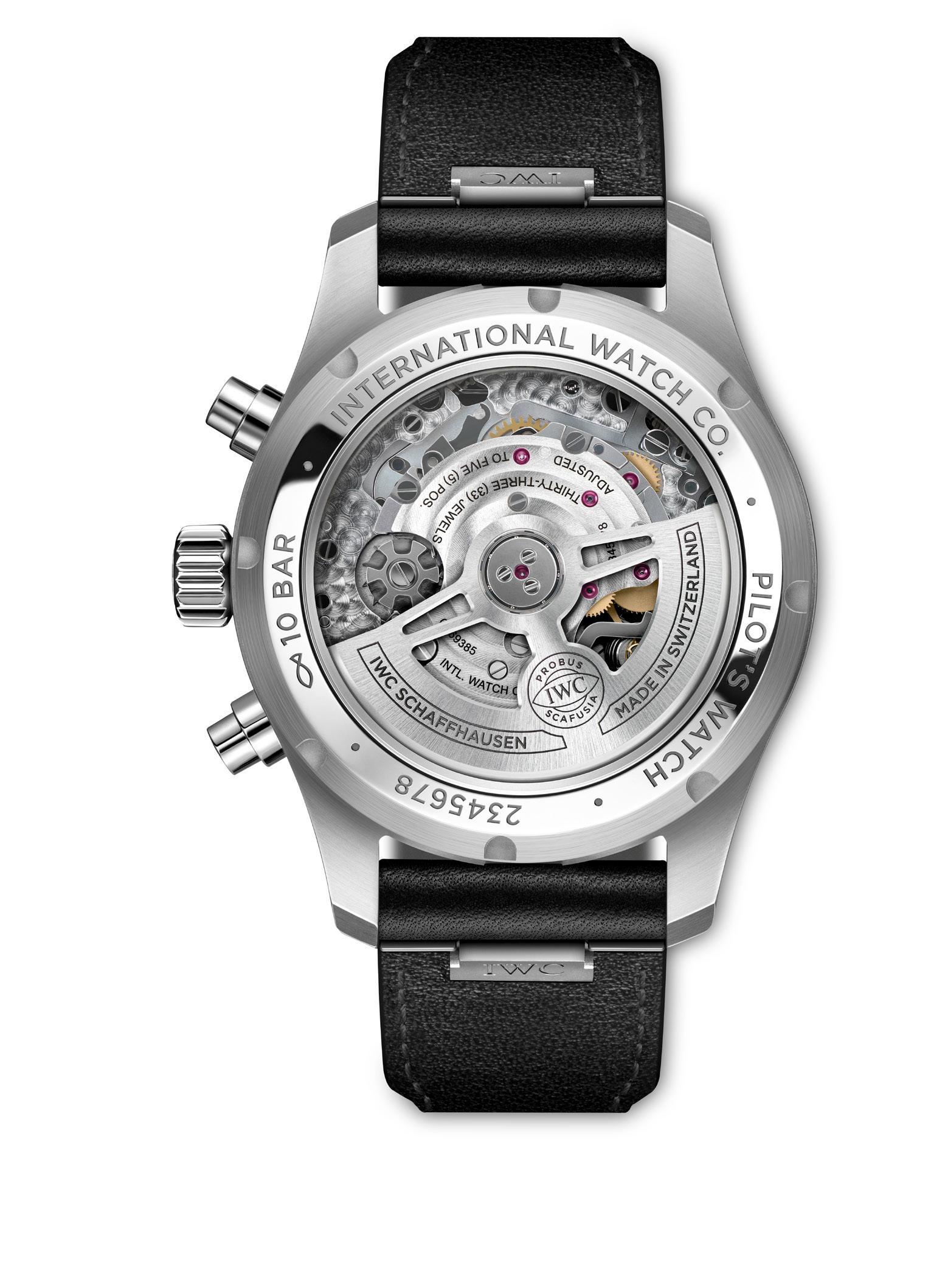

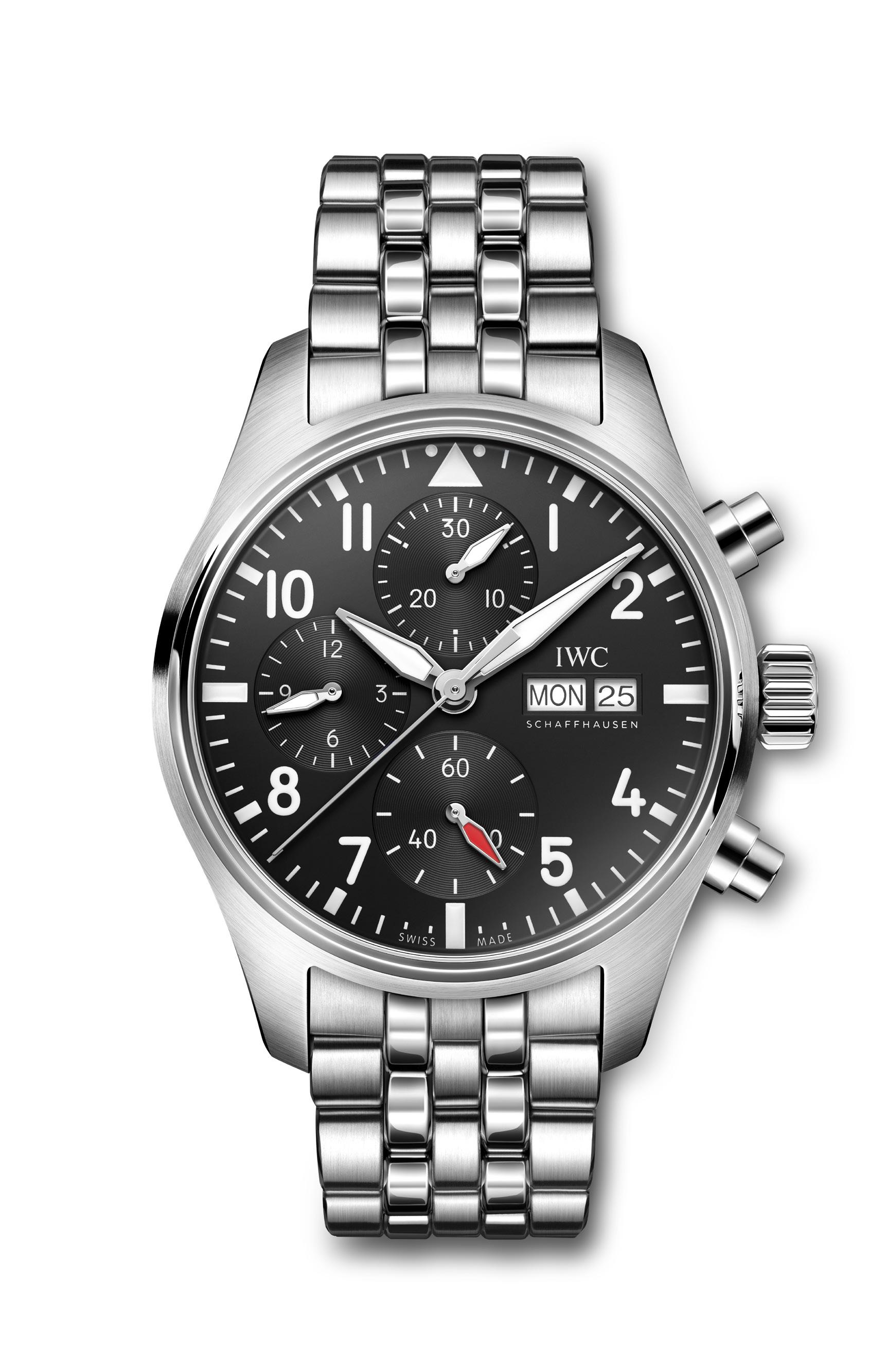
“The dial features the iconic design in the style of an easy-to-read cockpit instrument design.”
Of all the achievements, and all benchmarks that Omega has established over the years this is probably the most subtle, which is ironic because it’s also probably the most significant. Introducing the “Spirate,” no not a “spy pirate” but a trademarked word combination of “spiral” and “rate,” which refers to a tiny, almost insignificant device that Omega has been teasing for some time now. That’s right, the “Tiny device that makes a massive change…” all started 10 years ago, in 2013, when Omega took their first big steps in a journey that has led to higher levels of anti-magnetism and accuracy.
That was the year the watchmaker introduced the groundbreaking Aqua Terra 15,000 Gauss, Omega’s first timepiece to achieve an unprecedented resistance to magnetism without the need for a protective casing. Resistant to magnetic fields of over 15,000 gauss (1.5 Tesla), the Aqua Terra 15,000 Gauss, indeed, exceeded the magnetic resistance of most, if not all, other watches, and it was due largely to the use of proprietary non-ferromagnetic materials (including the Si14 balance spring) for key movement components in a new trailblazing calibre. This means it was the Co-Axial Calibre 8508

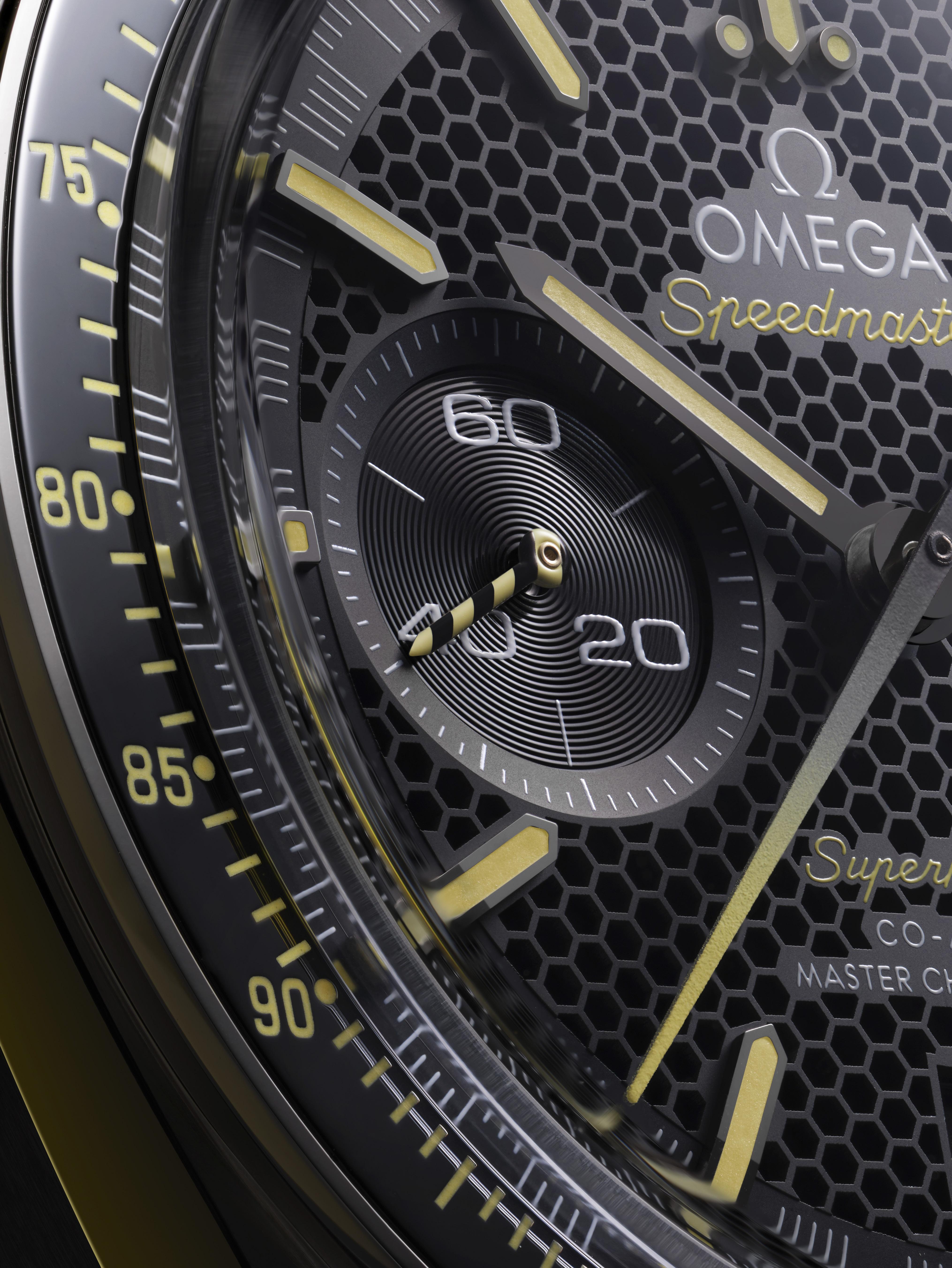
movement itself that was resistant to extreme levels of magnetism thereby negating the need for a special protective case.
Two years after that, in 2015, Omega collaborated with the Swiss Federal Institute of Metrology (METAS) to establish the brand’s Master Chronometer certification, a 283step process that involved 8 tests over 10 days designed to push a timepiece to its absolute limits and achieve a standard of precision that went well beyond the industry benchmark. Because of the demanding standards of the Master Chronometer certification, Omega watches have been regulated with a precision between 0 and +5 seconds a day for the past 8 years. But that all changed this year with the new Spirate System.
10 years in development, the Spirate System involves a revolutionary new patent-pending spiral made from a silicon wafer via an internal manufacturing process called DRIE (Deep Reactive Ion Etching) in the form of a totally new Si14 balance spring. This allows for ultra-fine rate adjustments via the stiffness of the hairspring’s attachment point through an eccentric adjustment mechanism located on the movement’s balance bridge. Thanks to this one-of-a-kind mechanism, an Omega watch can now be regulated to within an astounding METAS certified 0 and +2 seconds per day, which could very well be the most stringent standard in the industry, at least when it comes to the large scale industrial production of mainstream luxury watches.
The Omega Speedmaster Super Racing is the first timepiece to incorporate this industry changing advancement, and is Omega’s new souped-up watch from the Speedmaster Racing collection that incorporates all the watchmaker’s accomplishments over the years, not the least of which is the Co-Axial Escapement; the Si14 Silicon Balance Spring; the 15,000 gauss antimagnetic movement; the Master Chronometer certification; and of course, the new Spirate system incorporated into the new state-of-the-art Co-Axial Master Chronometer 9920 Calibre that powers it. The movement is (of course) certified by METAS with a precision of 0/+2 seconds per day, the proof of which is the distinctive red METAS card that accompanies the watch.
But the Omega Speedmaster Super Racing is more than just the vessel used to showcase Omega’s latest technological advancement, it is also a visual tribute to the watch that started it all: Omega’s 2013 anti-magnetic masterpiece the Aqua Terra 15,000 Gauss.
The basic structure and design of the Omega Speedmaster Super Racing is identical to the
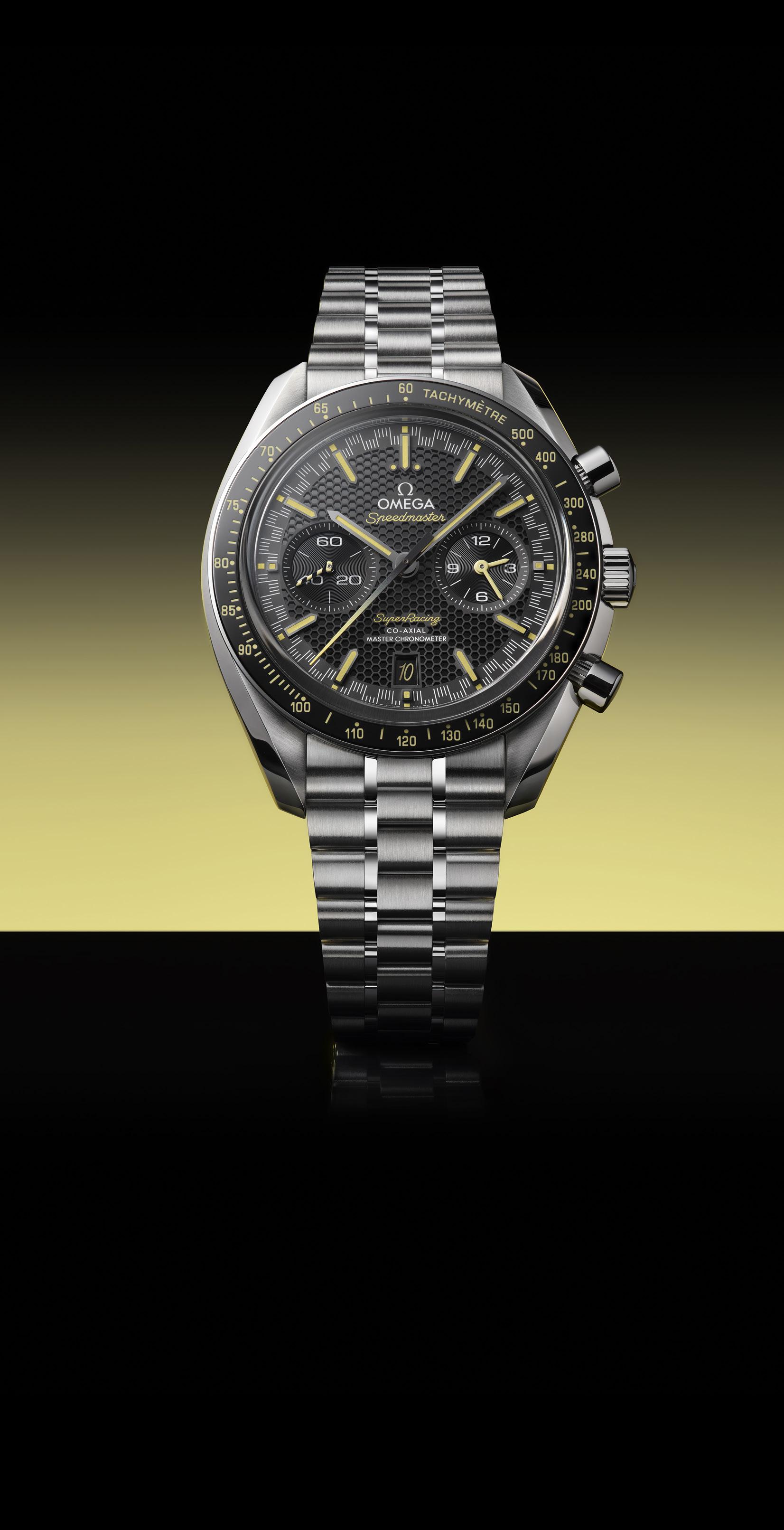
“AN OMEGA WATCH CAN NOW BE REGULATED TO WITHIN AN ASTOUNDING METAS CERTIFIED 0 AND +2 SECONDS PER DAY, WHICH COULD VERY WELL BE THE MOST STRINGENT STANDARD IN THE INDUSTRY”
Speedmaster Racing models we’re all familiar with. This includes the large 44.25mm diameter, the 50mm from lug to lug, and the height of 14.9mm (so, it’s by no means a small watch). Still made of stainless steel, the new watch retains the 50 meters of water resistance, the classic asymmetrical profile of the Speedmaster Racing with the lyre-shaped lugs, the box-shaped sapphire crystal, and the brushed and polished surfaces. The classic two-counter layout of the Racing collection is present as well with the small seconds at 9 o’clock; the 60 minute/12 hour recorder, which doubles as a second time zone at 3 o’clock; and the date display still at 6 o’clock. In other words, so far, so usual; but it’s new Super Racing’s updated aesthetics that hints at the super mechanics under its hood.
Aesthetic design elements of the Aqua Terra 15,000 Gauss abound in the new Speedmaster Super Racing, not the least of which is the new and distinctive yellow “grand feu” enamel seen on the 2013 Aqua Terra; it punctuates, well, everything including the racing style minute track and black ceramic bezel ring with the famous tachymeter scale. The use of this bold yellow shade is continued on the striped small seconds hand at 9 o’clock, as well as with the distinctive
black to yellow gradient effect on the main chronograph hand, both of which add to that “hey, did you notice that?” effect that rewards second glances.

Other distinctive features include a new sandwich dial with a DLC-coated lower plate, and an upper layer with a frankly gorgeous honeycomb grid pattern. This not only continues the Aqua Racer’s black and yellow color accents, it also references a concept timepiece that survived extreme magnetic fields of 160,000 Gauss presently on display at the Omega Museum. Further, the diamond-polished and bevelled black arrowhead indexes are filled with
a new and exclusive yellow Super-LumiNova, the color of which extends to the Speedmaster Super Racing logo on the dial. But it’s the date window at 6 o’clock that has a little Easter egg: on the 10th of every month, the watchmakers pay homage to the 10th anniversary of the Aqua Terra 15,000 Gauss with a stylized number “10” in the Speedmaster font, which appears every month in the date window.
The Omega Speedmaster Super Racing is matched with a steel bracelet similar to that of the Chronoscope with its brushed and polished 3-link architecture, and micro-adjustment with a push and slide mechanism. It comes in a special black-colored presentation box with yellow stitching and sports the same honeycomb pattern as the watch’s dial. Further, the box contains a way-cool additional NATO strap in recycled nylon with (naturally) black and yellow stripes, a strap changing tool, and the aforementioned red METAS card.


As of this writing, the Spirate System can only be found in the new Omega Speedmaster Super Racing. But because of Omega’s large-scale industrialized production capabilities, the Spirate will most likely “trickle down” to other Omega collections sooner than you think.


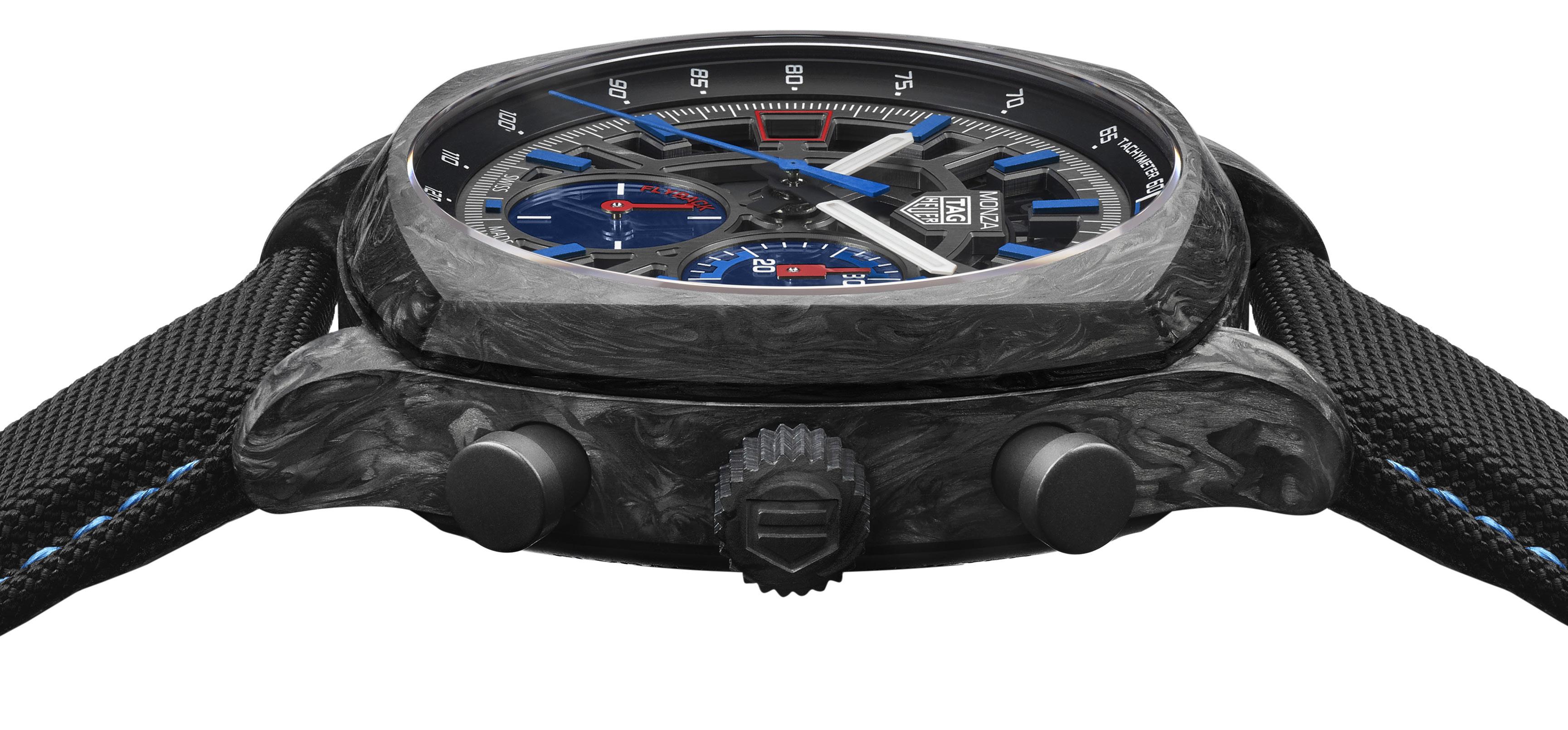
THE MONZA’S NEW DIRECTION ADDS RED AND BLUE HIGHLIGHTS TO THE WORDS “TECHNIQUES D’AVANT GARDE”
WordsIn the menagerie of Formula 1 personalities, few are so closely tied to a particular time and place as Vittorio Brambila, dubbed “The Monza Gorilla” by the English press. Brambilla was born in Monza — the only driver in the history of the sport who could call this Italian “Cathedral of Speed” his home town. He was brash and aggressive, a bear of a man who drove with passion, yet maintained
the restraint and sensitivity needed to excel in wet conditions. Brambilla did not win at Monza –he only ever won a single Grand Prix — nor did he drive for an Italian team. Yet he was loved by his compatriots for his pugnacious spirit.
The TAG Heuer Monza Flyback Chronometer can be seen as a commemoration of Brambilla, who in 2001 died of a heart attack while mowing the lawn. This colorful watch is big, bold, and cares little for everything that came before it as it blazes a brave new path for both the Monza
by Jose Martin Ursúaand TAG Heuer. It could also be a celebration of TAG’s more recent history in Formula 1. The spirit animals of this Monza might be both simian and taurine — specifically, Red Bull, which reshaped the F1 landscape from 2005 onward. Thus far, Red Bull has won 5 constructors’ championships and 6 drivers’ championships, with Sebastian Vettel and Max Verstappen. It has shaken up the established order, as well as upended decades-old partnerships like McLaren and TAG. Team principal Christian Horner even has a personal connection with this TAG Heuer model. Long before joining Red Bull Racing, while still managing the Arden F3000 team, he celebrated Vitantonio Liuzzi’s victory at Monaco by buying himself a TAG Heuer Monza.
We last saw the Monza seven years ago, in its 40th Anniversary guise. The Monza has always been an odd amalgam of historical influences like the 1976 original, which celebrated Niki Lauda’s World Championship, and the 2000 re-edition, which more closely resembled pre-war Heuer chronographs. While the 40th Anniversary was a valiant attempt to merge these distinct models into one Monza, the Flyback Chronometer shreds the heritage book and appears to be inspired in no small part by the Royal Oak Offshore. In 1993, Audemars Piguet judged that it needed to update the 20-year-old design of the Royal Oak to appeal to a younger clientele thirsty for bigger watches, exotic materials, and wild visuals. The Flyback Chronometer takes those three elements and launches the Monza into uncharted waters.
The Flyback Chronometer’s outer shell immediately reveals its new direction. TAG Heuer has retained the beefy 42mm dimensions of the 40th Anniversary Monza, but renders the cushion-shaped mid-case and bezel in forged carbon instead. This is not TAG’s first foray with the material; forged carbon could be found on 2018’s Bamford Monacos, and it has made a handful of reappearances since then. The visual tell is the swirling pattern of grays and blacks, giving each timepiece a unique fingerprint. For durability, the caseback is made of DLC-coated titanium while the crown and pushers are in steel, similarly blackened. The crown is further capped with the same forged carbon, giving it an appearance consistent with the case.
It is on the dial where we see the Flyback Chronometer’s innovative and carefree spirit. The red and blue highlights might be seen as a link to partner Red Bull, though the liberal use of
electric blue suggests otherwise. Fans of the team, or of drivers Max Verstappen and Checo Perez, may want to consider the much cheaper Formula 1 X Red Bull Racing, TAG’s quartz chronograph with an obvious red/blue/yellow color scheme and caseback engraved with the RBR logo. The motorsports association may be debatable, but the truly avant-garde visual language is not. The skeletonized dial combines finely-chamfered perforations with two translucent, blue-smoked sapphire subdials to expose large areas of the movement underneath. The 3 o’clock counter tracks minutes with a chunky, pixelated hand that has been a visual hallmark of the Monza since 1976. The running-seconds subdial at 6 is surprisingly clean, other than 15-second marks and “Flyback” written on its edge. Perhaps this lack of detail is meant to encourage use of the chronograph, and its blue-lacquered sweep hand, for tracking seconds accurately. Hour and minute

hands are white with black bases, again echoing the parts on the 1976 original.
Another visual innovation for TAG Heuer is the skeletonized datewheel. Totally visible through the dial, each day rotates between a red-framed date window and a trapezoid covered in blue Super Luminova. The glow from the hands, the hour markers, and the silhouetted date make the Flyback Chronometer unmistakeable at night. Surrounding the dial is a dual-function chapter ring, boasting a motorsports-appropriate tachymeter to calculate speeds, and a pulsometer for estimating one’s heart rate. Curiously, “100” is highlighted in red on the latter’s scale, possibly serving as a dividing line between rest and exercise for someone with moderate athletic ability.
Visible from both sides of this Monza is Calibre Heuer 02 COSC Flyback. This is TAG Heuer’s flagship chronograph movement, designed inhouse and boasting bullet points that can compete
with the best: 28,800 bph, 80-hour power reserve, 6.9mm thickness, column-wheel, vertical clutch, COSC-certified accuracy. It should be noted that this calibre is not skeletonized; the front and rear windows provide a peek at plates, bridges, and gears that are fascinating but unmodified. Extract it from the Flyback Chronometer and the Heuer 02 appears as it does in its earlier, high-profile application: the Autavia Chronometer. Even the blackened, 8-spoke rotor will be familiar to Autavia owners. The flyback complication gives this Monza its full name, and allows for a swift reset of the chronograph to zero, without requiring a stoppage.
The Flyback Chronometer’s modern style extends beyond its case. The strap is blue-stitched


black textile, of a type that other brands would call “sailcloth”. Despite the nautical-sounding material, the Monza is not a dive watch, and the strap’s effectiveness against moisture should be considered appropriately matched. In other words, it would be wise to switch to a rubber or NATO strap if the Monza’s 100m waterresistance might be tested. The final treat to literally close the loop is the carbon, single-fold deployment clasp.
Vittorio Brambilla’s most famous moment was when he crossed the finish-line to win a sodden Austrian GP at the Osterreichring. Raising his arms in triumph, his Day-Glo orange March hit standing water, yawed slowly to the right and into the guardrails. This is the only post-victory
crash in F1 history — à propos for a driver who raced with his heart on his fireproof sleeve. At first glance, TAG Heuer’s Monza Flyback Chronometer appears similarly reckless, shedding the tradition and conservative styling that appealed to past generations of Heuer enthusiasts. This is not a watch for them. Rather, it is TAG’s equivalent of the Royal Oak Offshore. The Flyback Chronometer similarly takes a familiar design and ticks all the design options to yank the Monza into the year 2023. The combination of outré, primary-color graphics, current-day materials technology, and pre-war case is an unnatural fit, and that is the point: The Flyback Chronometer intends to challenge conventional assumptions about TAG Heuer and the Monza.
“The Monza Flyback Chronometer sheds the traditional styling that appealed to older generations of Heuer enthusiasts. This is not a watch for them.”

Words by Kit Payumo

Mahindra Racing is a motor racing team based in Banbury, England that competed in MotoGP until it became a founding team in the ABB FIA Formula E Championship. It is the only Indian team to compete in the fastest growing and most competitive championship in motorsport, and has, in fact, been successfully competing in the all-electric race since the inaugural season in 2014 with 5 wins and 23 podiums to date.
Mahindra Racing has, indeed, garnered an impressive stats sheet by being a multi-race winning outfit after scoring its breakthrough victory at the Berlin E-Prix in 2017. And because of their deep involvement in Formula E the team has committed to not only push the limits of technology and innovation in the electric vehicle space, but also to address the impact of climate change. This resulted in Mahindra Racing becoming the first Formula E team to be awarded the FIA Environmental Accreditation Three-Star rating, demonstrating best practice and excellence in sustainability practices.
In 2020, Swiss watchmaker Maurice Lacroix was named Official Timekeeper of Mahindra Racing, a position that stemmed from the watchmaker’s admiration for the racing team’s environmental stance, and which the watchmaker celebrated with the release of a trio of AIKON Mahindra watches: an AIKON Chronograph Quartz, and AIKON Chronograph Automatic, and an AIKON Chronograph Skeleton Automatic Indeed, partnering with a racing team that not only actively promotes EV technology as a means of making the skies cleaner, but that has, in fact, been using the same technology to become one of the foundations of Formula E was, for a lack of a better term, a no brainer.
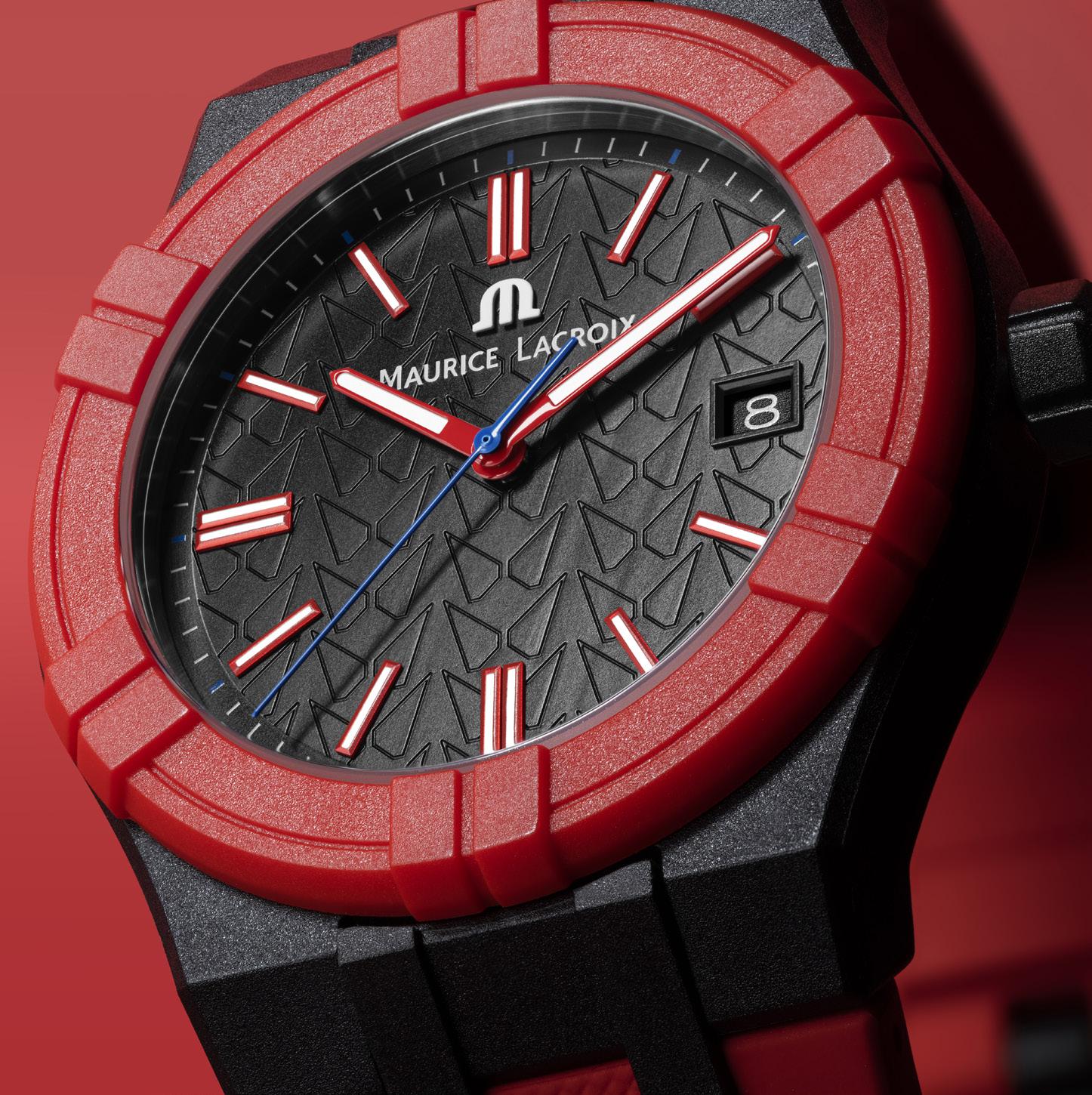
Last year, Maurice Lacroix partnered with Tide Ocean SA, the world’s premier recycled plastic supplier that makes products out of the plastic waste presently inundating our oceans. Based in Basel, Switzerland, with offices in Lengnau, Hong Kong and Ranong, one of the southernmost provinces of Thailand, #tide originated from the Swiss watchmaking industry via the Braloba Group, a world-leading watchstrap manufacturer, and was founded by Thomas Schori who was looking into the possibility of using plastic for watchstraps as a way to provide a durable solution to plastic pollution in our oceans.
Together with the Swiss University of Applied Sciences, Schori began conducting research on
how to make watchstraps out of upcycled plastic waste. The result is ocean-bound plastic waste, “Brought back to life as a valuable resource,” in the form of the award winning #tide ocean material, a 100% ocean-bound plastic raw material that is processed into either granules, yarn or filament depending on the application.
Produced by the Institute for Materials Engineering and Plastics Processing (IWK), Switzerland’s leading research institution for component design and production in plastics technology, this raw material is then shipped for application to all sorts of diverse industries throughout the world via an eco-friendly global supply chain that Tide Ocean SA is helping to develop as well. And coming full circle, one of those industries is the watchmaking industry with a number of major watchmakers including Maurice Lacroix that make use of the award winning #tide ocean material for their watch straps and case material. The AIKON #tide is one of those watches. And by using upcycled plastic recovered from the ocean, Maurice Lacroix has made the world a little cleaner and a little better for everyone.
“by using upcycled plastic recovered from the ocean, Maurice Lacroix has made the world a little cleaner and a little better for everyone.”
“It takes 17 plastic bottles to make one AIKON #tide and its user-friendly packaging, which means 17 fewer bottles polluting the ocean.” This ties in perfectly with the environmental stance of Mahindra Racing. Which is why in their third year as the racing team’s Official Timekeeper, Maurice Lacroix is presenting another motorsport racing-inspired AIKON watch. Albeit this time, one made with environmentally friendly oceanbound upcycled plastic called the AIKON #tide Mahindra watch.
“The AIKON #tide Mahindra is a further demonstration of our shared commitment to the environment,” remarked Stéphane Waser, Managing Director of Maurice Lacroix. “Like Mahindra Racing, we tour the globe, operating in urban settings. Both brands strive for success, whether that’s competing on race tracks in various cities or making urban watches for competitive souls, but most important of all, we both believe in innovating for a brighter, greener future.”
The AIKON #tide shares the same attributes as other members of the AIKON family, and the AIKON #tide Mahindra watch is no exception. This means the same Swiss quality, the same

precision timekeeping, and the same urban styling, however in the case of the AIKON #tide Mahindra, turbo charged with the team’s racing colors.
Joining the original trio of Maurice Lacroix Aikon Mahindra watches, the new AIKON #tide Mahindra sees the familiar AIKON design cues all executed in ocean-bound upcycled plastic. This means the 40mm case, bezel, caseback, crown, end pieces, strap buckle, integrated lugs and screw-in crown are all made from the award winning #tide ocean material. These are highlighted by a bold red AIKON bezel with sixprong detailing to mimic the Mahindra Racing team’s colors.
This contrasting red and black color palette is continued on the unique black dial textured with the Mahindra Racing logo and contrasting red hour markers and hands, all of which are swathed in generous amounts of white SuperLumiNova. These are complemented by a black colored date window at 3 o’clock, as well as a blue colored seconds hand to add that final pop of color. Best of all, the inherent design and all-plastic nature of the Aikon #tide lends itself well to the team colors of Mahindra Racing resulting in a watch that can

be worn by someone who may have never even heard of the Mahindra racing team or Formula E.
Like the “regular” AIKON #tide, the AIKON #tide Mahindra is powered by a traditional Swiss quartz movement hidden from view behind the closed caseback. It is ready to compete in Formula E with two rubber straps, the first in black with Maurice Lacroix’s ‘M’ logo in contrasting red on its side, and the other in vibrant red with a contrasting black ‘M’ on its side. Both are secured by an ocean-bound plastic pin buckle, and both can be easily swapped with the other without the need for tools thanks to the Maison’s Easy Strap Exchange system.
“We are delighted to be partnered with Maurice Lacroix once again on the development of their new AIKON #tide watch,” reiterated Fred Bertrand, CEO of Mahindra Racing. “They have developed the watch with recycled materials with the aim of really targeting a younger audience.We love working with brands that share our same values and goals of working towards a more sustainable future, so I’m pleased to welcome Maurice Lacroix on board for Season 9. I can’t wait to wear the watch with pride in 2023.”
CELEBRATING THE FIRST RELEASE OF THE FIRST GRAND SEIKO.
Words by Bert Casal

Japan is a country that is rich in culture and tradition that is evident even to this day. They developed many arts and crafts that were passed on and are still practiced in these modern times. Though technology has taken over most of the production process, ancient skills and crafts are still being utilized, offering a higher value to the products.
Since the 1960s, Japan has been known to be the leader in technology. A case in point is their skill in the field of robotics. But one field that not a lot of people recognize is their skill at making watches. There are those who believe that the Swiss make the best watches. They are not wrong. But what some may not realize is that the Japanese make pretty darn good watches as well.
The history of Seiko began in 1881 when Kintaro Hattori opened a shop in Ginza to repair and sell timepieces. In 1913, his company produced Japan’s first wristwatch, and many achievements that have advanced the art of watchmaking followed. Seiko brand watches were originally produced by two different Seiko Corp. subsidiaries. One was Daini Seikosha Co., Ltd. and the other was Suwa Seikosha Co. Splendid watches were produced at both companies because of the tough competition.
People believed that Swiss watches were the highest quality and Japanese watches were inferior. Seiko believed they were capable of producing
watches of the same quality as the Swiss. The challenge to come up with a watch that rivals the Swiss fell upon the hands of Suwa Seikosha Co. So in 1960, the first Grand Seiko was released. The first Grand Seiko had a dial that was always easy to read at any angle. It had multifaceted rectangular indexes that allow the time to be read precisely. Double indexes were placed at the 12 o’clock position to accentuate the vertical line from 12 to 6 o’clock. It had multi-faceted hands where the hour, minute and seconds hands are all sharply cut on every facet to create high legibility. It was the first chronometer grade watch manufactured in Japan, based on an official certificate chronometer standard developed internally within Seiko. It was priced so high, practically as expensive as a very good Swiss watch. What made Grand Seiko different from

the other Seiko brands were the materials used and the degree of craftsmanship that went into creating that watch.
This year marks the 110th anniversary of Japan’s first wristwatch. In honor of this milestone, Seiko recreated the first Grand Seiko model in Brilliant Hard Titanium with an urushi dial.
Urushi lacquer is synonymous with traditional Japanese craft, and its use can be traced back to Japan’s Jomon Period (13,100 BCE - 400 BCE). The varnish used is made from the sap of the urushi tree which mainly grows in Japan and China. The tree must be tapped carefully, as in its raw form, the liquid is poisonous to the touch, and even breathing in the fumes can be dangerous. Since the Japanese have been working with this material for centuries, they have developed a technique to refine and use this material safely.
Flowing from the incisions made in the bark, the sap is a viscous greyish-white liquid. One of the drawbacks of this process is that it can only be done in very small quantities. Three to five years after being harvested, the resin is treated to make an extremely resistant, honey-textured lacquer. After filtering, homogenization, and dehydration, the sap becomes transparent and can be tinted black, red, yellow, green or brown.
Once applied on an object, the lacquer is dried under very precise conditions. Its harvesting and highly technical processing make urushi an expensive raw material applied in exceptionally fine successive layers.
After heating and filtering, urushi can be applied directly to an object. Pure urushi dries into a transparent film. Each layer is left to dry, then it is polished before the next layer is added. This process is very time-consuming and laborintensive, and this contributes to the desirability and high costs of lacquer-made goods.
The lacquer employed by Grand Seiko on this re-edition has the distinction of being sourced exclusively from Japan, a rarity today. The jet black color of the dial was achieved through the addition of iron. The lacquer is further enhanced through a special treatment unique to Grand Seiko that prevents its color from changing over time.

The indexes of this new Grand Seiko are brought to life by urushi master Isshu Tamura. The markers and the Grand Seiko name are built up, layer upon layer, through the application of lacquer, endowing them with their trademark three-dimensional profile. Next comes the 24k gold powder (the process of which is called
maki-e which means “sprinkled picture”) which is applied and polished with the special tools of the artisan. The process requires tremendous dexterity and precision to the micron level.
Maki-e is the Japanese art of gold sprinkling. This thousand-year-old technique consists of sprinkling the lacquer with fine particles of gold onto lacquer that is still wet. The gold dust is applied using bamboo tubes and small brushes made from rat’s hair.
As a re-creation of the very first Grand Seiko released in 1960, the anniversary limited edition cuts a striking vintage profile, one that many watch lovers will recognize instantly. But for the urushi and maki-e treatments, the curved dial and Grand Seiko lettering are faithful to the original 1960 creation.
Under the dial is the manually wound Caliber 9S64, which allows for the slim profile and accuracy to +5 to -3 seconds per day. It beats at a frequency of 28,800 vibrations per hour and has
a power reserve of 72 hours. The Brilliant Hard Titanium case and clasp ensure that the recreation is not only beautiful and light, but also highly resistant to corrosion and scratches. Grand Seiko’s proprietary alloy is brighter than traditional titanium, causing the Zaratsu-polished surfaces to appear even more radiant while commanding a hardness double that of stainless steel.
Two leather straps accompany this timepiece. The first incorporates a traditional Japanese weaving technique called yoroiori that was once used for making samurai armor. The strips of calf leather and fabric are interlaced by a skilled artisan to enhance the watch strap’s durability. The second strap is leather sourced for its softness, unique texture, and comfort.
The new Grand Seiko limited edition timepiece with an urushi lacquer dial and maki-e hour markers is crafted to stand the test of time and captivate generations of watch connoisseurs with its uniquely Japanese craftsmanship and beauty.
“The urushi dial and maki-e hour markers are crafted to stand the test of time to captivate for generations”
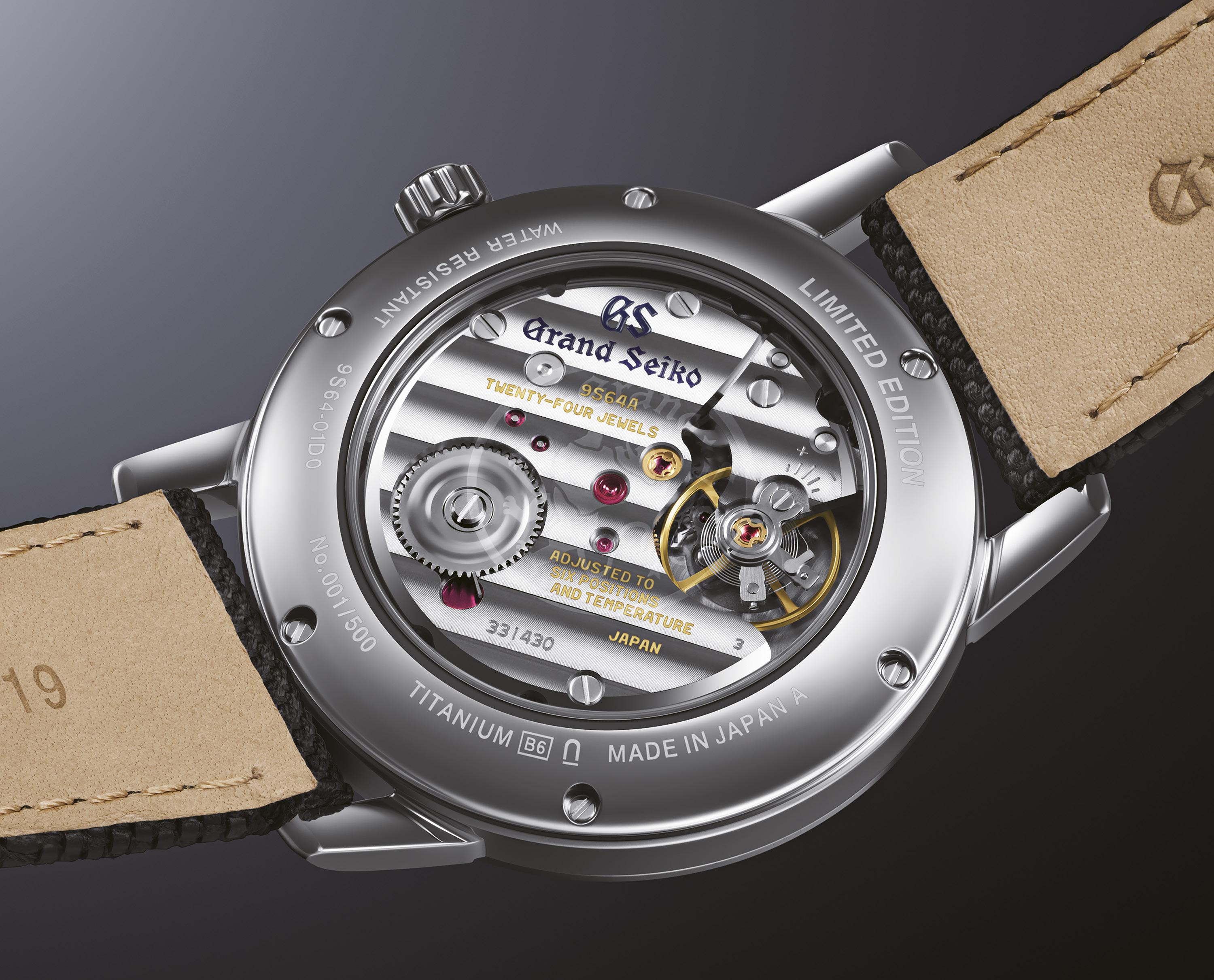
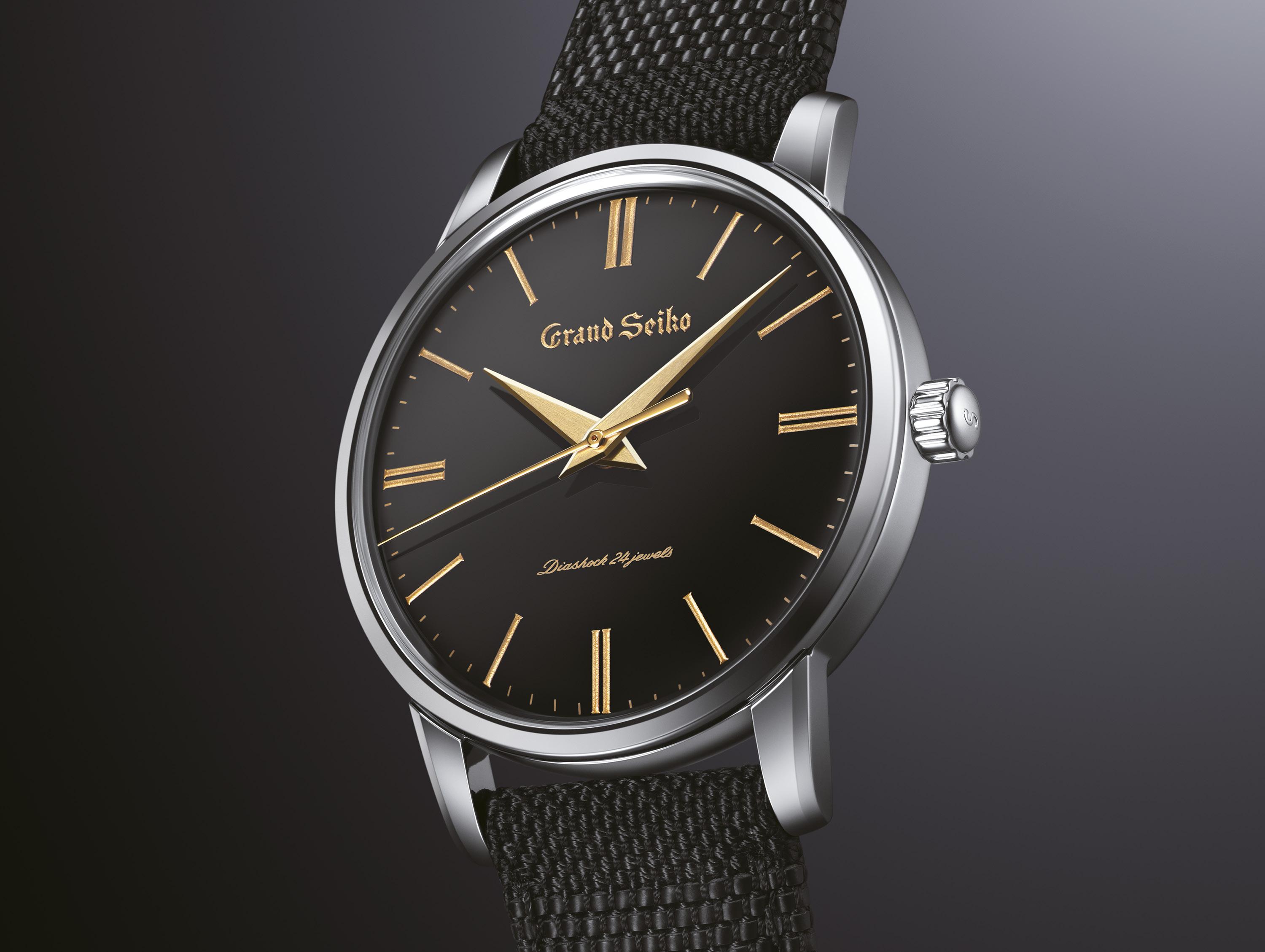

Alpina takes on the challenge of the world’s most extreme skiing and snowboarding competition

Words by Kit Payumo


"Xtreme Verbier” was, since 1996, an iconic and standalone Swiss event in extreme freeride skiing and snowboarding until it was transformed into a global circuit for big mountain skiing and snowboarding in 2008. Called the Freeride World Tour (FWT), the five-stage event has put the best skiers and snowboarders from all over the world to the test on some of the most legendary and challenging mountain faces around the globe resulting in some of the most exiting skiing and snowboarding the extreme sport has ever seen. The 2023 edition is guaranteed not to be the exception.
• The first stage of the FWT 2023 started in January 29 in BaqueiraBeret, Spain. Located in the heart of the Pyrenees, Baqueira-Beret comprises four interconnected areas and is known for a dramatic 1,100-meter vertical drop.
• The second stage saw the FWT return to the perennial Pyrenean freeride mecca of Ordino-Arcalís, Andorra on February 2. Known as the “Benchmark for freeride,” Ordino-Arcalís is famous for its playful terrain that always guarantees explosive action, showcasing a mix of freestyle and pure freeride.
• This year, the Tour crossed the Atlantic for a triumphant return to Kicking Horse Golden BC, Canada where the third stage of the FWT is presently taking place. Labeled as ‘The Champagne Powder Capital of Canada,’ Kicking Horse BC is known for its steep and deep chutes, four alpine bowls, and 3,500 acres of light & dry ‘champagne’ snow, which makes it an ideal venue for the Tour.
• The fourth stage and first finals event on March 11 will take place in Fieberbrunn, Austria where athletes must navigate the glorious, yet intimidating, Wildseeloder, a 2,119-meter high mountain in the eastern Kitzbühel Alps in Tyrol, Austria. The mountain face has played host to the Tour for over a decade and continues to be one of the most inspiring venues for the competitors. But it is the fifth and final stage that will ultimately test the mettle of the riders.
• The most impressive mountain challenge in the world will conclude on one of the toughest slopes on earth: the Bec des Rosses de Verbier in Switzerland, the original Verbier in “Xtreme Verbier,” the legendary north face of which is where competitors will battle it out between March 25 and April 2. Known for its maze of cliffs and couloirs (that’s a steep, narrow gully on a mountainside to you and me), the Bec des Rosses is one of the most exciting and inspiring freeride venues in the world.
“Freeride” for those not in the know is a style of skiing or snowboarding with no set rules. Indeed, competing in freeride is about mastering a creative line and doing so in perfect style. The riders scope out the mountainside from the bottom, before going on their daring run to find their own thrilling way down. A panel of judges scores the overall impression, taking into consideration, line, fluidity, control, air & style as well as technique. And by the end of the season, the top-ranked rider in each discipline is crowned World Champion.
The event will definitely push these top tier skiers and snowboarders to their limits, and having always been involved in outdoor activities and mountain sports, Swiss watchmaker Alpina, knows this only too well. Perfectly at home working in some of the most challenging environments our third rock from the sun has to offer, Alpina has become the Official Timekeeper of the Freeride World Tour, and is on hand to help guide this year’s competitors on their way with the new Alpiner Extreme Automatic Freeride World Tour 2023, a watch designed to echo the extreme essence of the FWT.


True to form, the Alpiner Extreme Automatic is as robust as they come and strikes an imposing pose in its 41mm x 42.5mm x 11.50mm case. Rugged but still completely wearable, the design of the 3-part case looks to have been borne from the Avalanche line of the brand with its cushion shape, and the extra element on the case flank at 9 o’clock to counterbalance the crown guards at its opposite. Six screws with triangular sprockets that mimic the triangular Alpina logo set off the round bezel; the screw-in crown not only guarantees 200 meters of water resistance, but is also fitted with a rubber grip that makes for easy manipulation even when wearing gloves. Last but not least, the vertical and circular brushed finishing of the case is true to its purpose and guarantees the watch with the aesthetics of a utility timepiece.

Beneath the scratchproof and glare proof sapphire crystal is a black chapter ring that borders a black dial flourished with its own version of the famous tapisserie dial with a triangular pattern instead. This, as well as the seconds hand counterweight once again echoes Alpina’s legendary triangle logo, which symbolizes the Alpine summits for which the watch is designed. The red Freeride World Tour logo sits at 6 o’clock on the dial, while to ensure optimum readability, the polished silver color indices are applied and filled with white luminous treatment along with the hand-polished silver color hour and minute hands, and polished central seconds hand.
Seen from the sapphire caseback is the selfwinding AL-525 calibre, a Sellita SW200-1-based movement that oscillates at 28,800 VPH, and features a blackened rotor that generates a powerreserve of approximately 38 hours. Last but not least, is an integrated black rubber strap, the texture and tough construction of which is not only a perfect match for the dial, but is the perfect complement to a watch made for extreme sports.
And as the Official Timekeeper of the FWT, Alpina will be staging an event worthy of the challenge at a site featuring the brand’s colors at the Bec des Rosses finish line, and will be offering fans a dedicated zone from where fans will have the best possible view of the event. Something for fans of the extreme sport will no doubt be looking forward to.
“Perfectly at home working in some of the most challenging environments our third rock from the sun has to offer, Alpina has become the Official Timekeeper of the Freeride World Tour.”

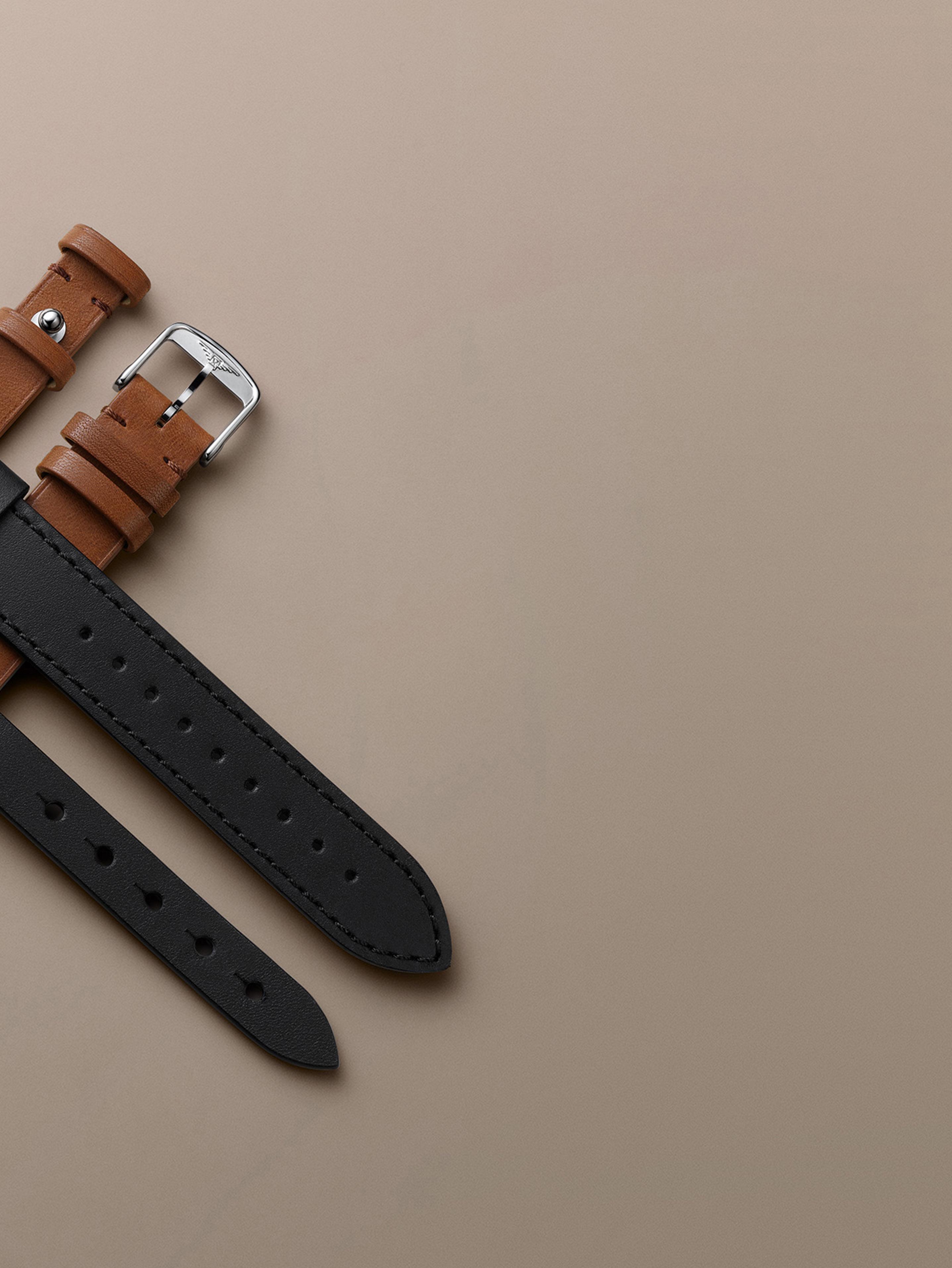 Words
Words
Lby Katherine Cunanan ongines watches are known for their elegance. The clean lines and sophisticated color palettes made the timepieces perfect for the man or woman who wanted a nice touch of refinement for their look. I recall a friend describing a Longines titanium watch that caught their eye some years ago. ‘It was elegant and refined’, they said, ‘and it was perfect.’ But they walked away and when they went back, it had been sold. Since they missed their chance, it has become the Horological One That Got Away.
In the nearly 200 years that Longines has been in Saint-Imier, Switzerland, they have mastered the skills needed for horology. Their dedication to tradition is matched with their desire for excellence. The watches are skillfully refined and have beautiful hand finishing and polishing. Longines has often participated in world championship sporting events as a timekeeper. In the world of sport, milliseconds matter, and accurate timekeeping is crucial to the credibility of the championship. Longines has long been associated with equestrian events specifically, like horse racing and jumping. And as like attracts like, Longines has also partnered with likeminded individuals who crave excellence as intensely as some crave coffee or chocolate.
The Longines DolceVita X YVY is the product of such a collaboration between the watchmakers of Longines and Yvonne Reichmuth, the founder and power behind YVY, a Zurich-based design company. The resulting timepieces are elegant, sophisticated, and doubly wonderful.
Yvonne Reichmuth is an intelligent and inspired choice for this collaboration project. She began in the womenswear design field, and developed a passion for working with leather. This led her to Florence where she had quite a productive stint, with fashion and editorial shoots. She found her creativity also expressed with costumes and unique pieces.
Reichmuth has won many awards for her design work, including the Swiss Design Prize for the Category Swiss Textiles Prize for Young Fashion Entrepreneurs. She was also nominated twice in the Fashion Category in the same competition. She was winner in the Accessory Designer Category in the Young Talent Award by Premium Berlin, and has been named one of the NZZ Best Dressed Switzerland Top 20, and one of the Top 100 Women in Business Switzerland. She has been a guest lecturer or a jury member for F+F (Fashion Design), the Swiss Management Forum, and the Luxury Innovation Award. Her pursuits included design and fashion styling for Swarovski, economiesuisse, and Volvo, among others. If you need some style or design inspiration, a quick check of her Instagram posts might be all you need to get your creative thoughts flowing.
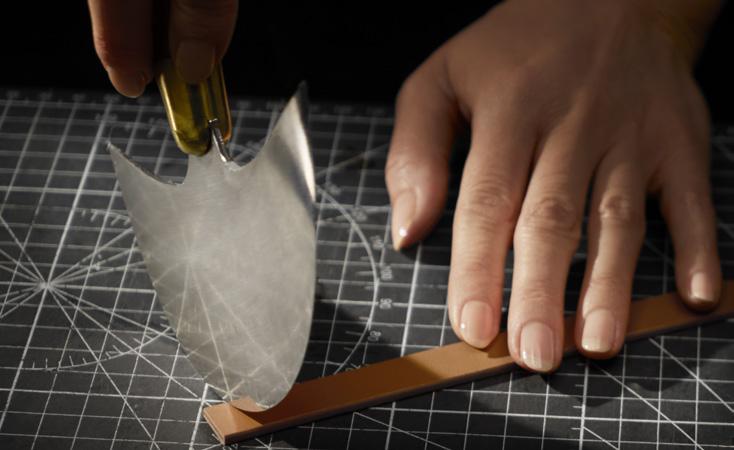
She founded YVY in 2016, and has had collaborative efforts in Europe, Asia, and the Middle East. Her designs are timeless and season-less, if you will. The collaboration for this timepiece is inspired by the equestrian world, which is a shared interest with Longines.



The Longines DolceVita X YVY watch has a rectangular stainless steel case with a leather strap, either single or double. The watch has touches of the equestrian influence. “We wanted to develop a new approach together to the world of horses and their bridles,” explains Yvonne Reichmuth. The bond between a rider and their mount is close, tight, but not prohibitive. Reichmuth adds, “The idea of a modular strap came about with the aim of creating a watch that could be worn with class in different styles.”
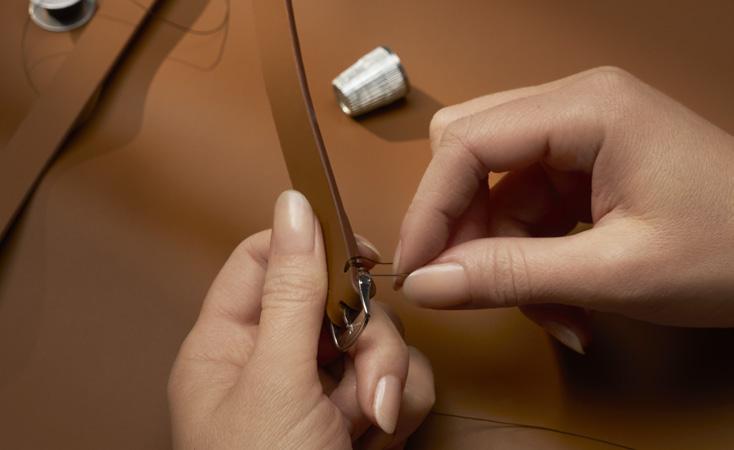

The result is a watch that is youthful, glamorous, and gives you that option and flexibility. It can be worn as a one-strap watch, or for added interest and style, a two-strap watch. “It is available with two different case sizes, to suit both men and women,” promises Matthias

“The bond between a rider and their mount is close, tight, but not prohibitive”
Breschan, Longines CEO. All models have a quartz movement and come in 2 sizes; they have the hour and minute hands, with the small seconds above the 6 o’clock. The caseback is engraved with the model name (Longines DolceVita) and the winged hourglass logo of the brand.


The equestrian feel seems more evident in the brown model (reference no. L5.512.4.71.B), perhaps due to the deep rich brown of the strap. The silver ‘flinque’ dial has Roman numerals for the hours, and the blue hour and minute hands. The small seconds hand is also blue.


The beige model (reference no. L5.512.4.79.2) is the most sedate and understated of the three. The dial is also light in color, and a suited match for the leather straps. The hours are marked by
clean lines that don’t distract from the elegance of the watch.
The black model (reference no. L5.512.4.59.2) is perhaps the most bold among the three models. The black dial and black leather back strap make for a strong figure on its own. When you add the complementary strap, the metal stud enhancements on it give the watch a little rock star feel to it.
Although the Longines Dolcevita X YVY watch models have a similar look to them, each one has something different that makes it special. And because time is the greatest teacher, when you see the watch that makes your heart skip a beat, it is best to snap it up so it will be The One On Your Wrist instead of the One That Got Away.
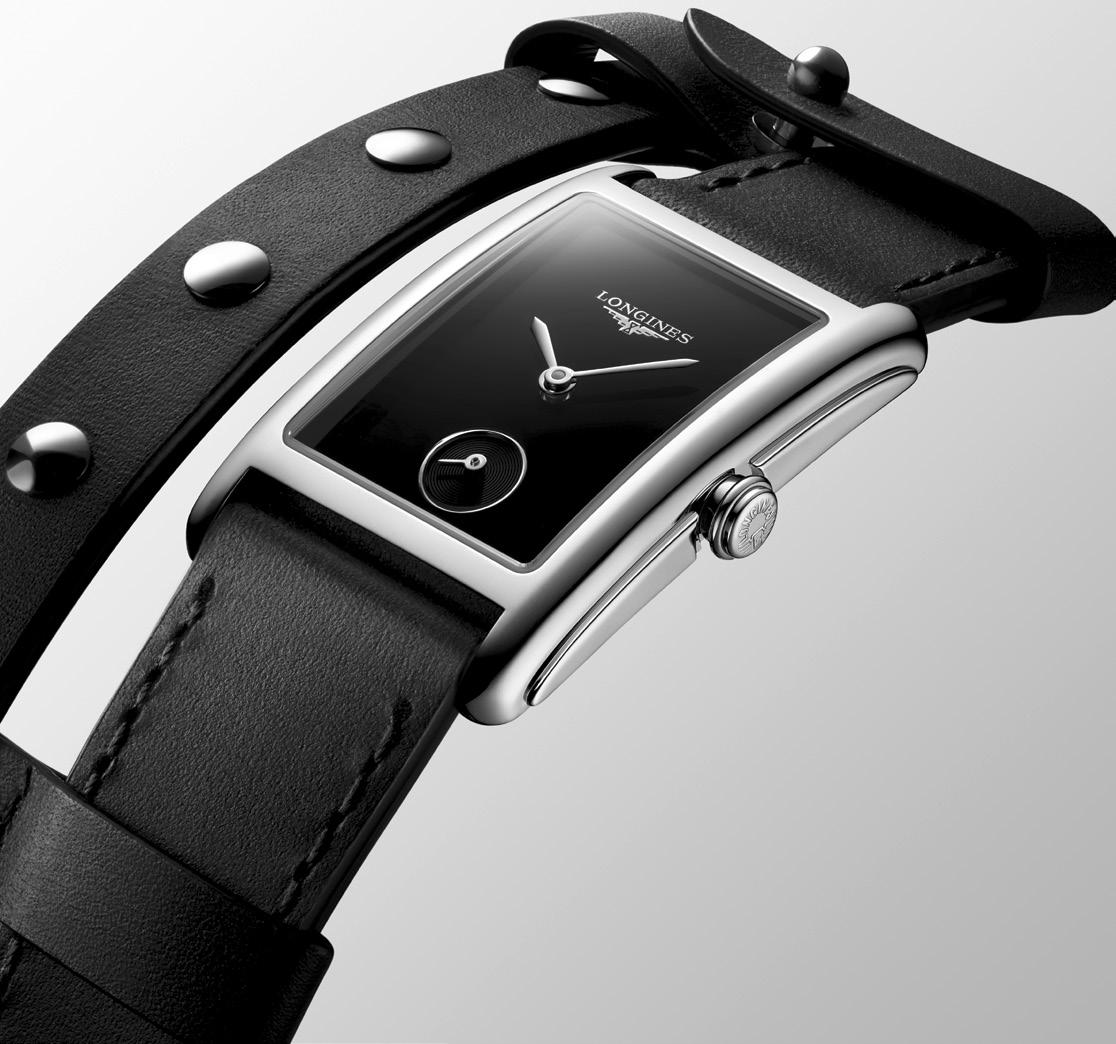
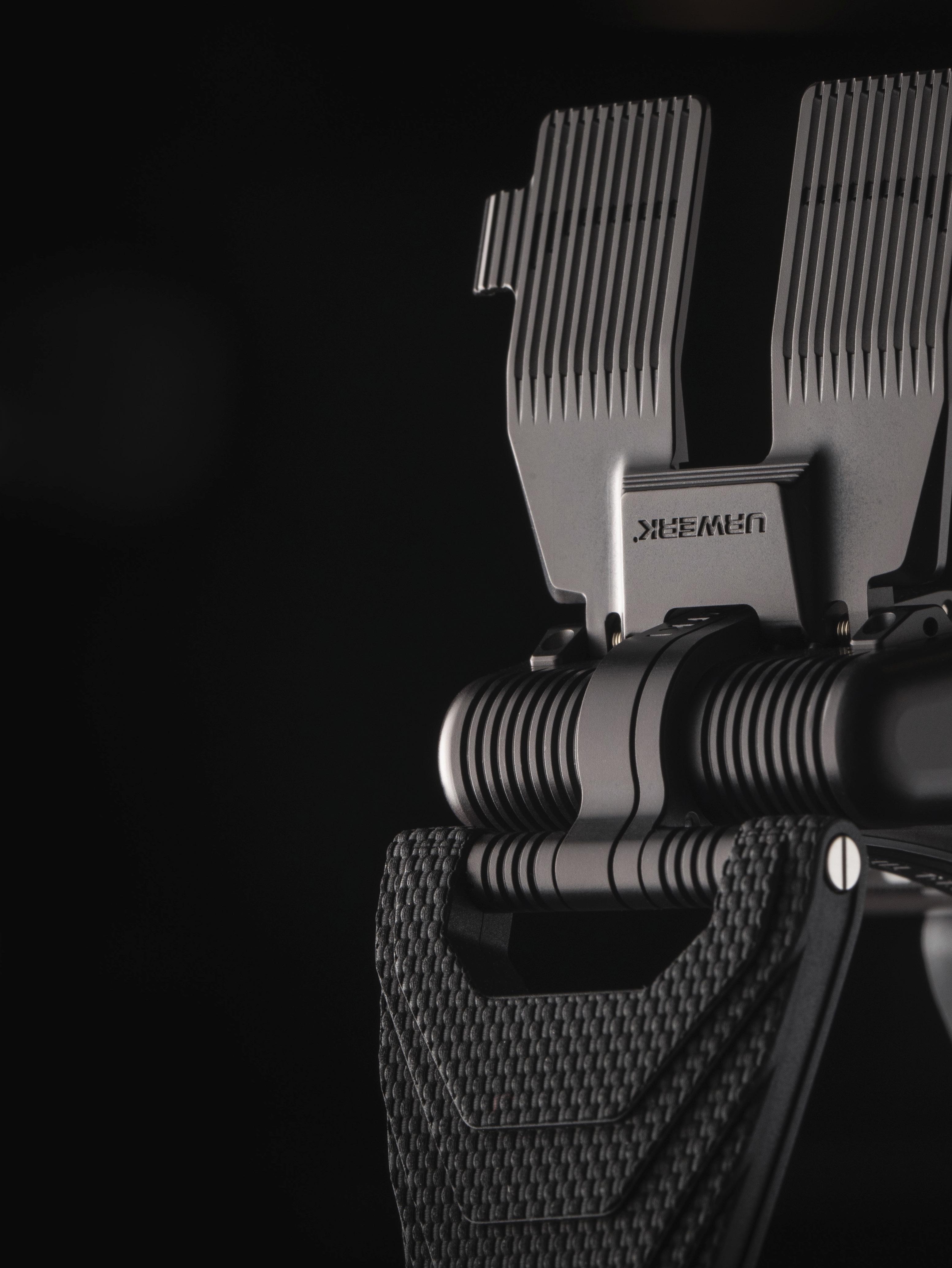
Words by Kit Payumo

Last year we featured the URWERK UR112 “Aggregat,” one of Urwerk’s greatest pieces of haute horlogerie, which like the textbook description of compendium brings together disparate elements to form a whole. Borne from the Maverick watchmaker’s Special Project collection, a think tank-type laboratory where follies “are encouraged to ultimately offer horological freedom,” the UR-112 Aggregat was, for all intents and purposes, another URWERK horological masterpiece, albeit one that departed from the avant-garde watchmaker’s signature wanderinghour indication. In fact, the Aggregat was a different animal altogether.
“The inspiration for the 112 line came straight from the USA,” says Martin Frei, co-founder of URWERK. “Felix and I were lucky enough to discover the impressive car collection of Ralph Lauren. Amongst the rarest models was the Bugatti Atlantic. WOW! It was love at first sight. Its perfect lines, its spine running along its body, its Art Déco features.
This Bugatti is a true wonder! It was the muse that inspired my first drawings of the UR-112.”
Ettore Bugatti built the Bugatti Atlantique in 1936, and inspired by his earlier 1935 Bugatti Aerolithe concept, built the Atlantique of lightweight aluminum to enhance speed. More importantly, the Atlantique was an “exceptional automobile” with a contrasting spine that Martin Frei says, “Emphasizes absolute symmetry.” That’s right, similar to the twin-bubble flourish on top of every Zagato cabin, the curvaceous and aerodynamic Bugatti Atlantique featured a seam running down its central body that worked not only as a “speed line” but also worked to emphasize the design’s inherent balance. It also featured a vertical grille with speed lines so often featured on objects made during the Streamline Moderne period of the mid-1930s (the Pan-Pacific Auditorium in Los Angeles, and the Electrolux Vacuum cleaner of 1937 are great examples of this).
Taking its cues from the Bugatti, the original hunter case of the UR-112 Aggregat featured a streamlined body with industrial design-inspired sweeping and rounded curves with the hunter
cover flourished with speed lines. And like the Atlantique, it was made of a lightweight material: titanium for the bonnet, and black and gunmetal PVD-coated titanium for the central body.
This year, the Aggregat is back for its final curtain call and this time in blacked out steel and titanium for the hunter case and central body respectively. And just like the original model, the new UR-112 Aggregat Back to Black hints at its gleaming engine within with a grooved and openworked steel bonnet, which once again opens vertically to gain access to the power reserve and digital seconds indications.
Its central titanium body is satin-brushed, sandblasted and beadblasted, thereby forming a field of functional microdots. The two blackened steel wings of the UR-112 Aggregat Back to black fit into this central body, which, viewed on the wrist, tapers from front to back, and features the central seam on the “caseback” where it transforms into the floating lugs as it reaches the extremities on both sides of the case.
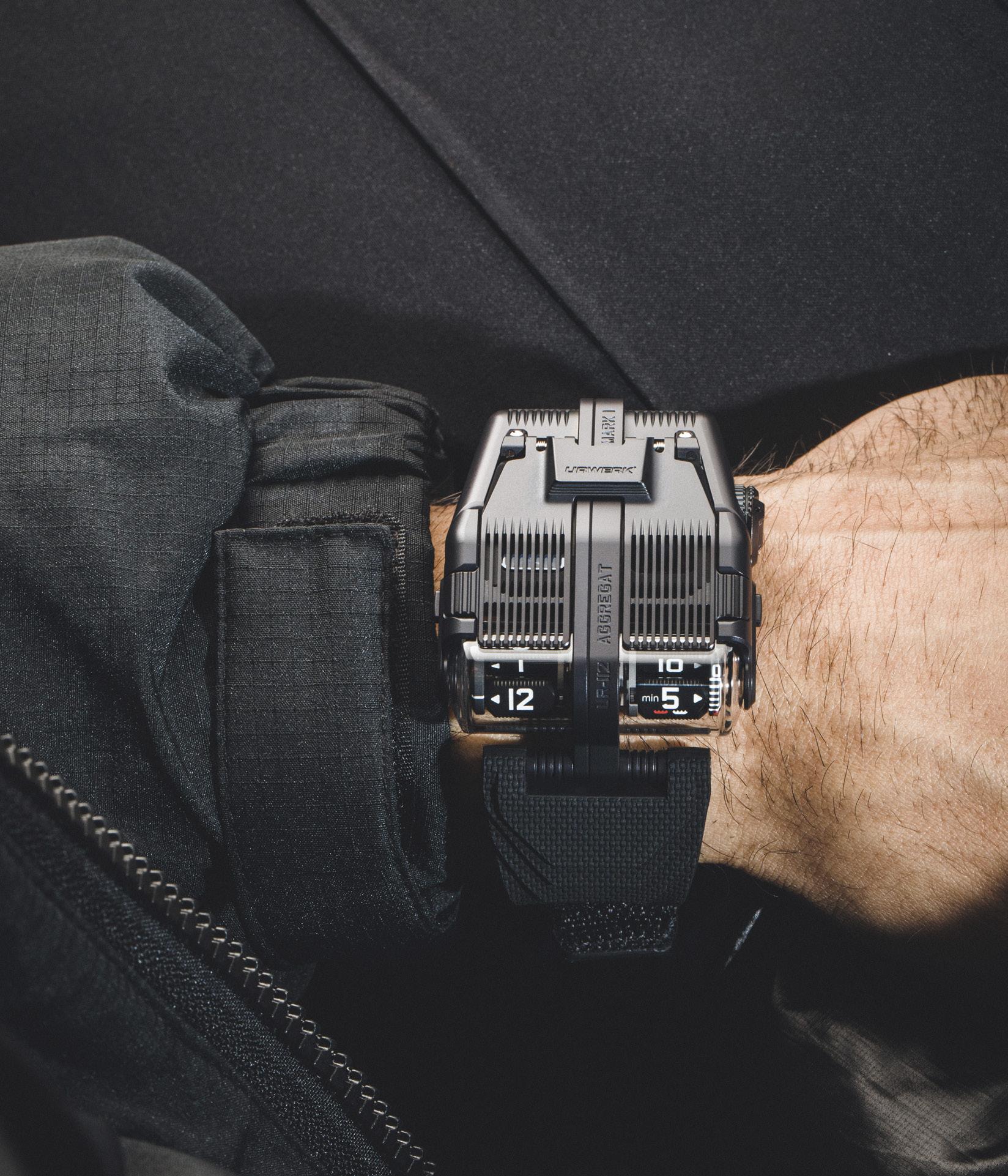
The 42mm x 51mm x 16mm dimensions, in fact, do not reveal the complex architecture of the case, which is (for lack of a better term) armorlike. Best of all, the watch only weighs 25.2 grams, which belies its complexity as a heavyweight mechanical tour de force that utilizes eight titanium planetary gears.
Even more technically astounding is that the basic power (mainspring) and regulation of the self-winding UR-13.01 movement is on a traditionally horizontal plane while the display is perpendicular to it, with power being distributed by something akin to a driveshaft.
“From a single source of energy, we power all displays and mechanisms of this UR-112,” continued Baumgartner. “This force is distributed sparingly, some even "recycled" so that from the digital second at the top of the dial to the dragging minutes and the jumping hours at the opposite extreme, each display receives precisely its required dose of energy with none wasted.”
This “driveshaft” is a long, thin titanium rod known as a cardan shaft that horizontally spans the central area between the left and right sections of the Aggregat to transmit the power required by the jumping hours, minutes and seconds. Measuring several centimeters in length, the cardan is possibly the longest component in contemporary watchmaking and is geared at each end to transmit all the energy required from the barrel to the perpendicular “digital” time displays through a complex set of cogs and gears whilst hidden by that specially designed seam that runs
the gamut of the case. A large barrel providing 48 hours of power reserve is coupled with an automatic-winding rotor.

The UR-13.01 spins at 28,800, has a 66 jewels and is endowed with traditional finishes, which include circular and straight graining, sanding, côtes de Genève, and polished screw heads that decorate the movement, none of which can be seen. That’s right, neither the movement nor the automatic motor are anywhere to be seen, and are completely covered up by the hunter style case.
Pressing the pushers on either side of the case unlocks the cover to reveal the only analogue
display of the UR-112: the 48-hour powerreserve indicator. This sits on the left side of the case across from an elaborate display of digital seconds, the tiny numerals of which are etched on tiny silicon wafer disks and parade under a magnifying lens framed by a bright red surround with a white arrow.

Out in front, the UR-112 Aggregat Back to black displays its hours and minutes on Aluminum prisms, the numerals of which are engraved and filled with Super-LumiNova. These are visible from their large sapphire crystal housing and move in sharp, precise jumps like those old airport

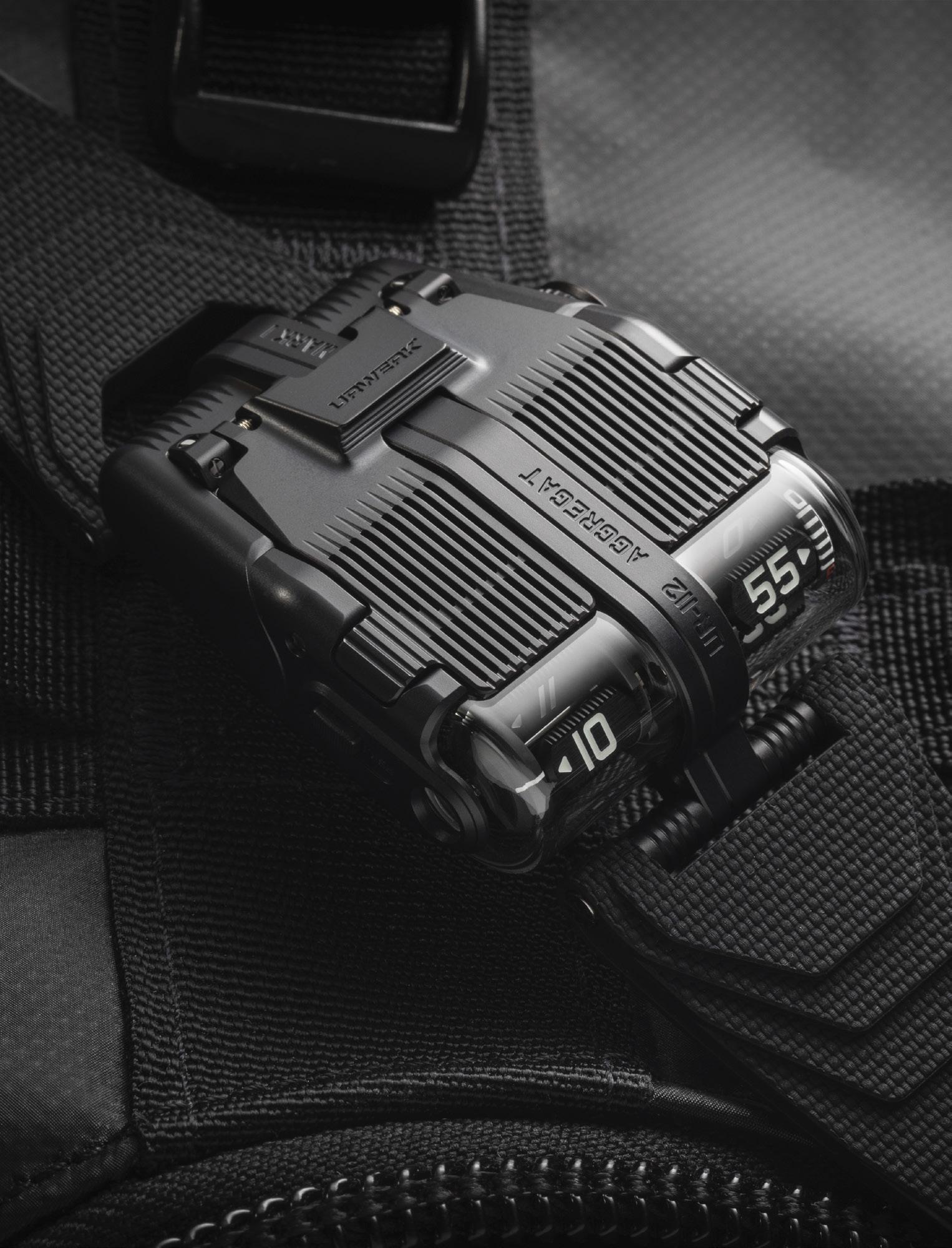
split-flap Solari displays. Interestingly, the minute prism advances in 5-minute intervals making the additional trailing indicator that shows the accurate minutes to its right wholly necessary.
This final model of the Aggregat line has its hours and minutes placed on the “active” side of the watch to face the inside of the wearer’s wrist. This is becoming the defacto avant-garde configuration for watches designed specifically for drivers since it makes for the easy reading of the time while the driver’s hands remain on the steering wheel, and is a limited edition of 25 pieces.
The world is getting more colorful, and also more precise. Some watches have their own very specific and documented colors and tones. Here was part of the exhibit of IWC for the new colors of their Big Pilot. Happily, it was done with Alchemist coffee shop in Singapore!


